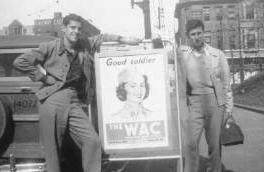
Tom and Friend Join the Navy at the Federal Building, Kansas City, Missouri, 6 October 1944. (Hahn Collection)
Home Page
11 January
2007October Tom Hahn
Family - Part 2
Chronology
6 October 1944 -- Enlisted in the United States Navy, Seaman 2nd Class (Combat Air Crew), Serial No. 343-27-20, at Kansas City, Jackson County, Missouri.

Tom and Friend Join the Navy at the Federal Building, Kansas City, Missouri, 6 October 1944.
(Hahn Collection)
8 November 1944 -- At the Naval Air Technical Training Center Millington, Tennessee for training for Combat Air Control: Boot Camp (six weeks), Aviation Radio School (16) weeks), and Aviation Radar School (two weeks). Mail Address: Barracks 33, Pers. [or Res. Center], Company 6, Battalion 3, N.A.T.T.C., Memphis 15, Tenn.
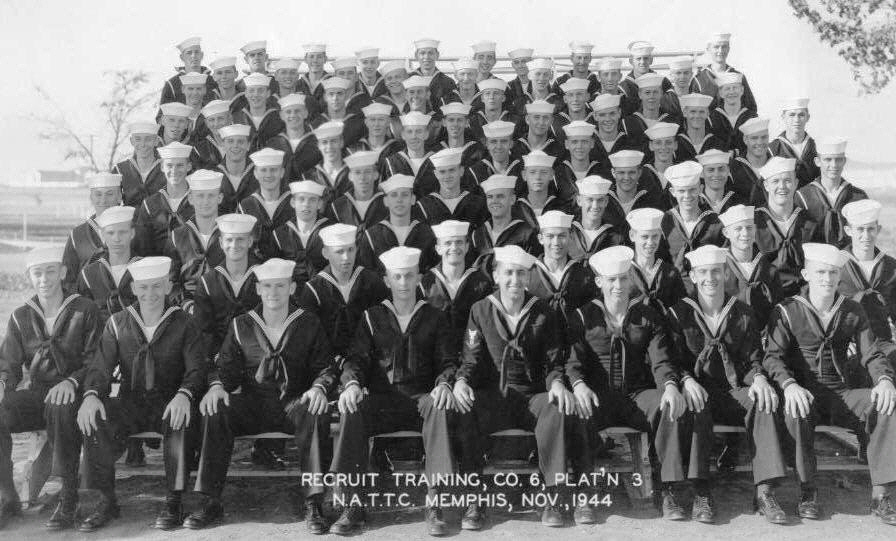
To
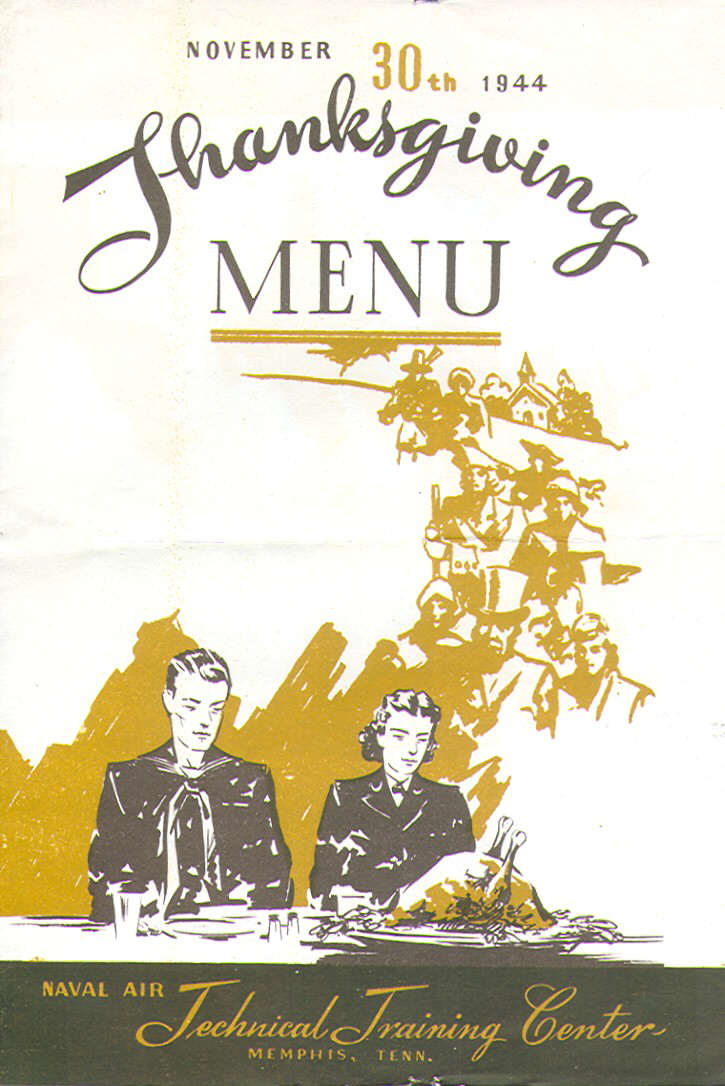
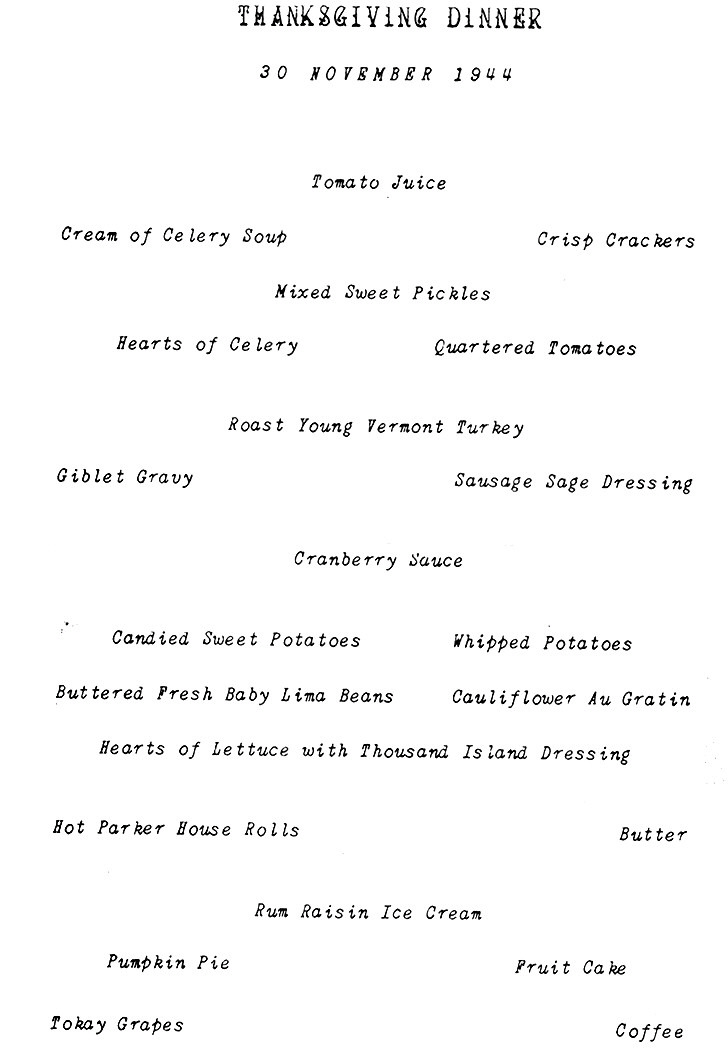
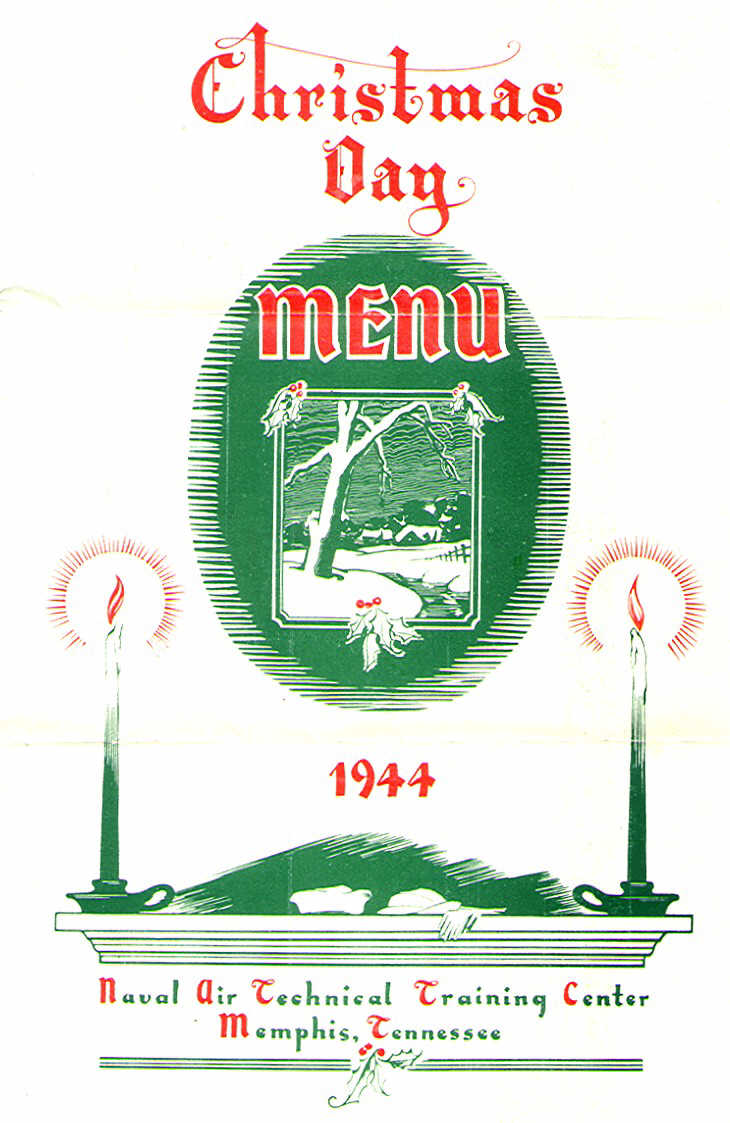
The menu was practically the same as that for Thanksgiving (Hahn
Collection)
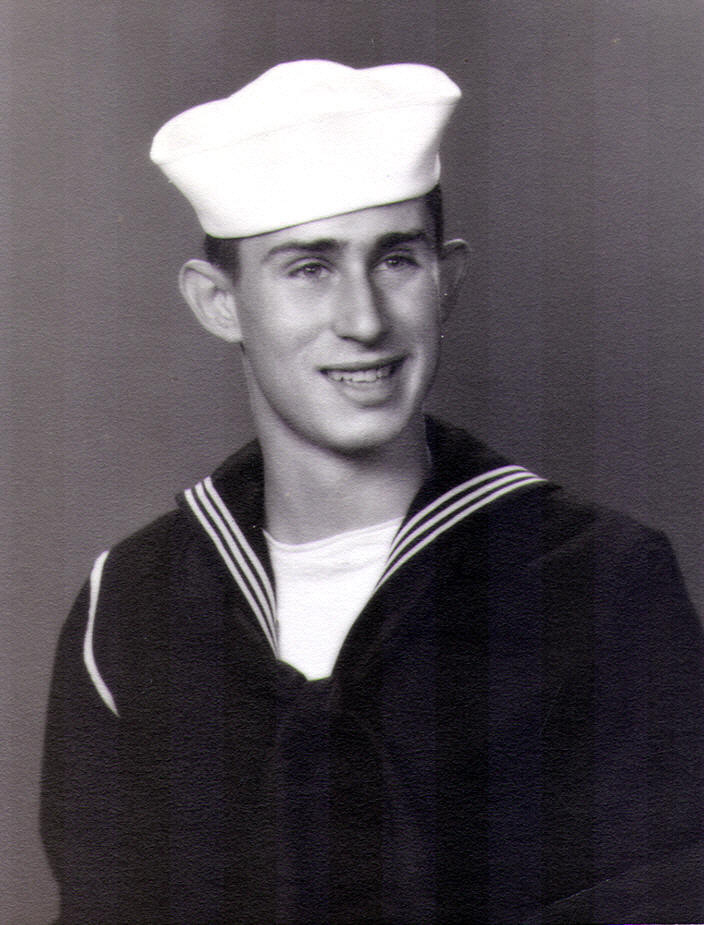
Tom Hahn, Seaman Second Class, Memphis, Tennessee. Note Aviation Radioman Striker's Badge on a the left sleeve. Note also that he has undergone cosmetic surgery on his ears. (Hahn Collection)

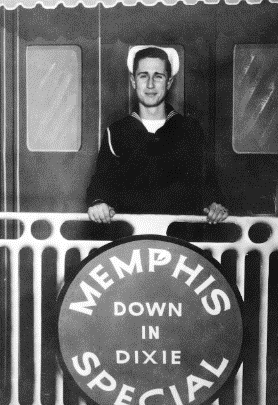
(Hahn Collection)
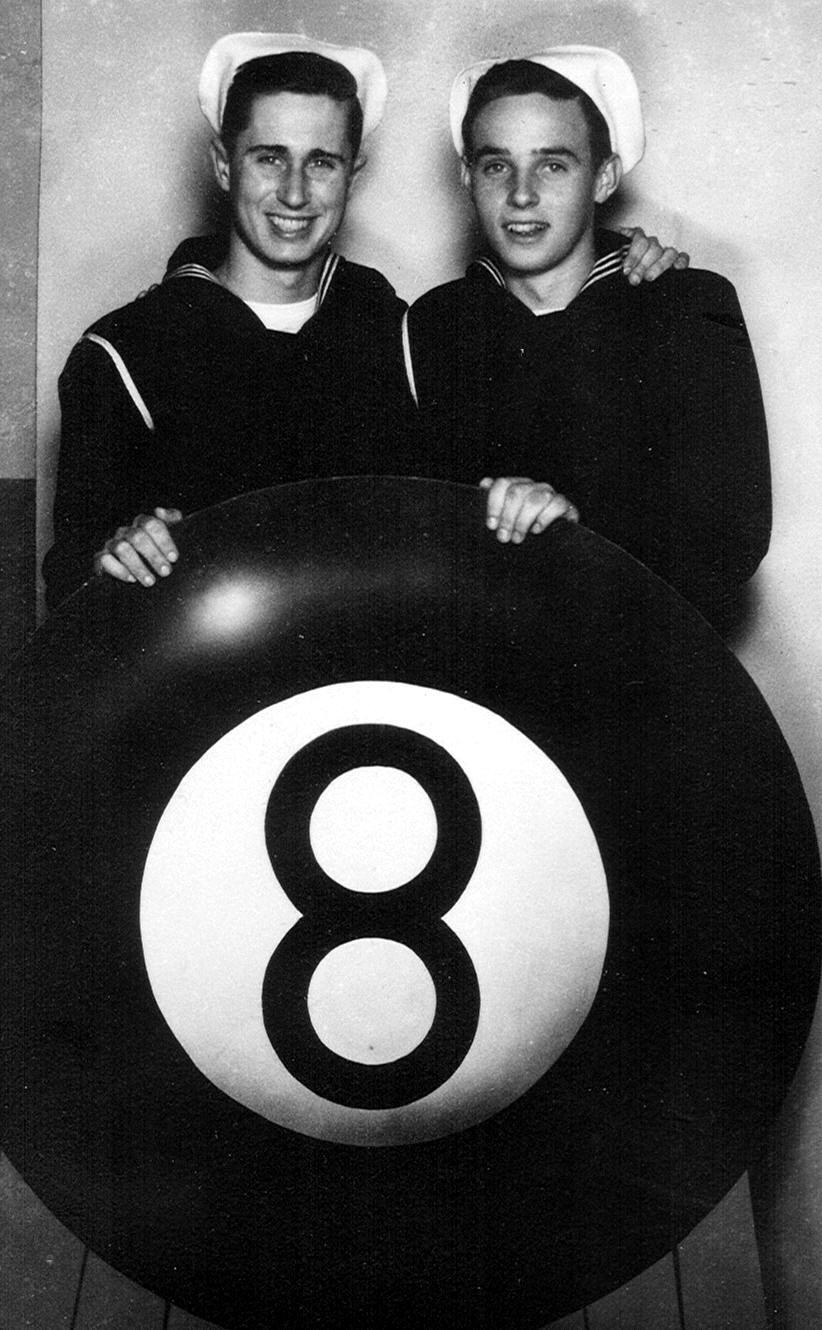
Navy Buddies Tom Hahn and Don Hilfer at Memphis, Tennessee 1944 (Hahn
Collection)
Tom Hahn, Memphis Museum, 1945 (Photo by Walt Hahn)
Tom Hahn and Walt Hahn at a park in Memphis, Tennessee in April 1944. (Hahn Collection)
Tom Hahn and his mother, Florence Hahn, at a park in Memphis, Tennessee, 8 April 1945. Tom's parents came to visit him by train from Topeka while he was attending Aviation Radio School and Aviation Radar School. (Thomas Hahn Collection)
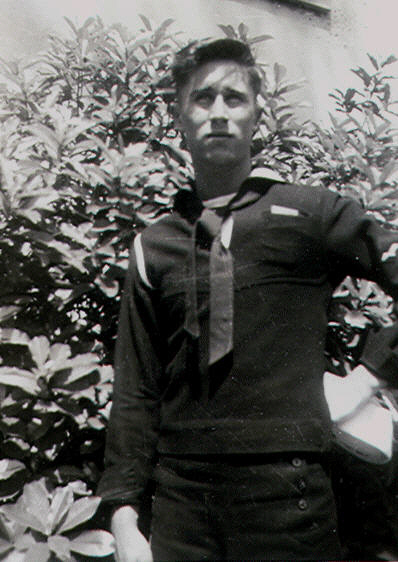
Tom Hahn at Memphis 8 April 1945 (Photo by Walt Hahn)
28 April 1945 -- NAVAL AIR TECHNICAL TRAINING CENTER (NATTC), Millington, Tennessee - Completed Aviation Radioman/Aviation Radarman Course
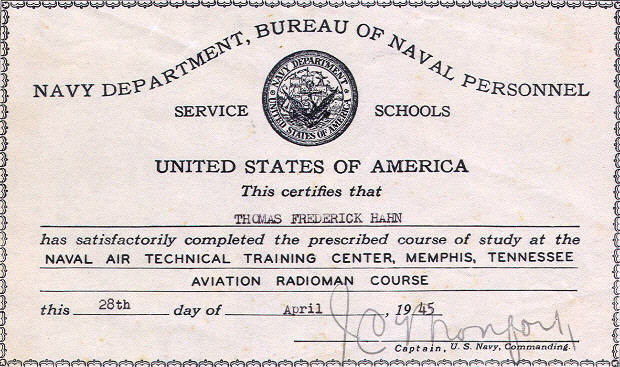
(Hahn Collection)
May 1945
-- Commandant 8th Naval District, New Orleans, Louisiana
for examinations for officer training. was given the choice of the Naval
Academy, the V-5 Program (Naval Aviation). I chose the V-12 Program so as to get
a well-rounded academic, co-ed education.
June 1945-November Navy V-12 Program (Engneering) at the Southern Methodist University, Dallas, Texas (14 weeks)
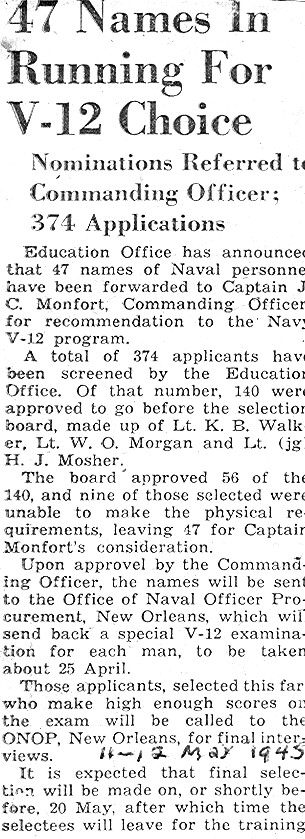
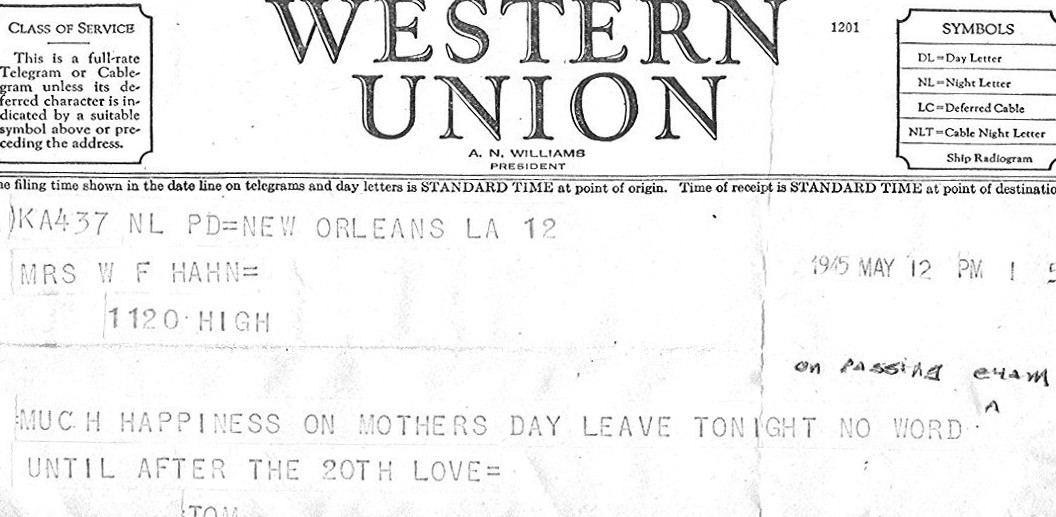
![]()
Thomas F. (Tommy) Hahn seaman 1/c, left [Topeka, Kansas] Friday to enter V-12 training at Southern Methodist university, Dallas, after spending a week's delay enroute visiting his parents, Mr. and Mrs. W, F. Hahn, of 1120 High. A former Kansas university student, he entered the Navy last October and recently completed radio training at Memphis. (Topeka Capitol or Journal)
November 1945-26 June 1946 --
Midshipman, University of Texas, Austin,
Travis County, Texas (35
weeks)
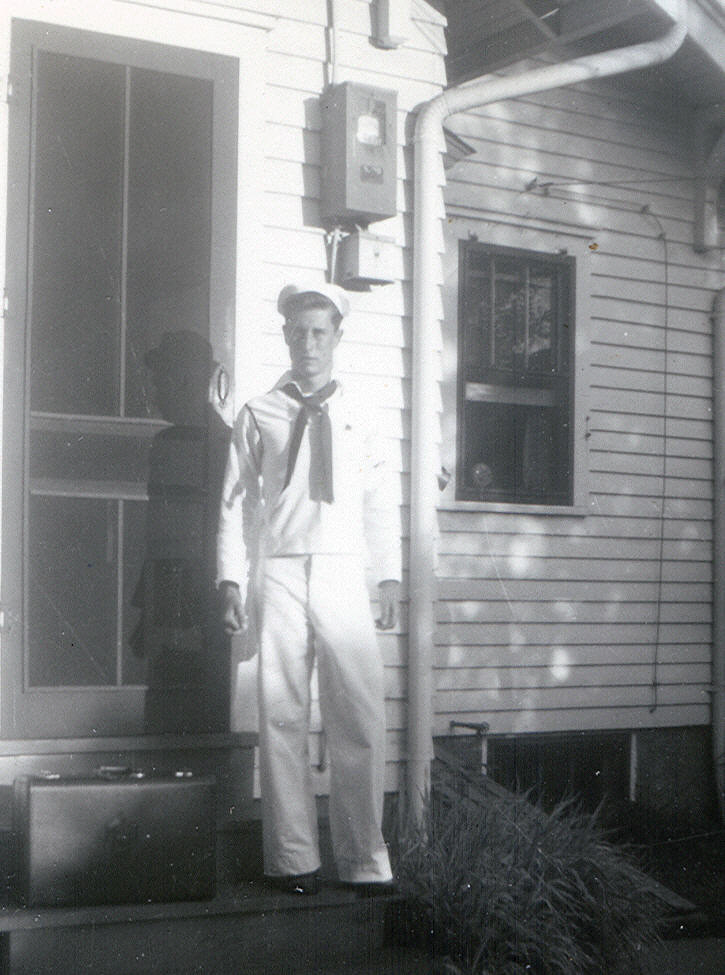
This 1945 photo was probably taken when I was at home in Topeka
on leave between Memphis, Tennessee and Dallas, Texas early summer 1945.
(Photo by Walt Hahn)

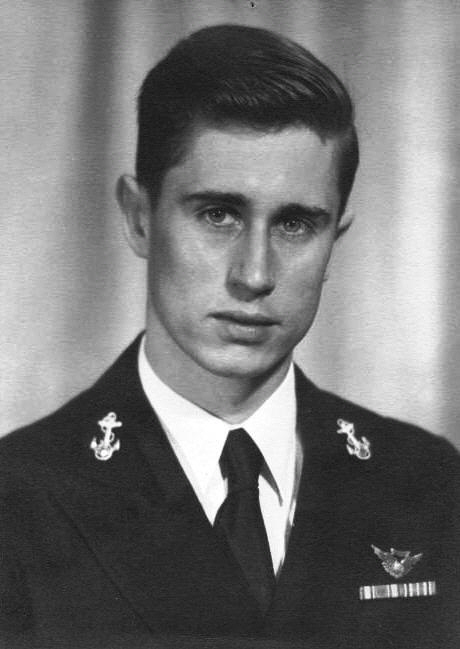
Midshipman, University of Texas (Hahn Collection)
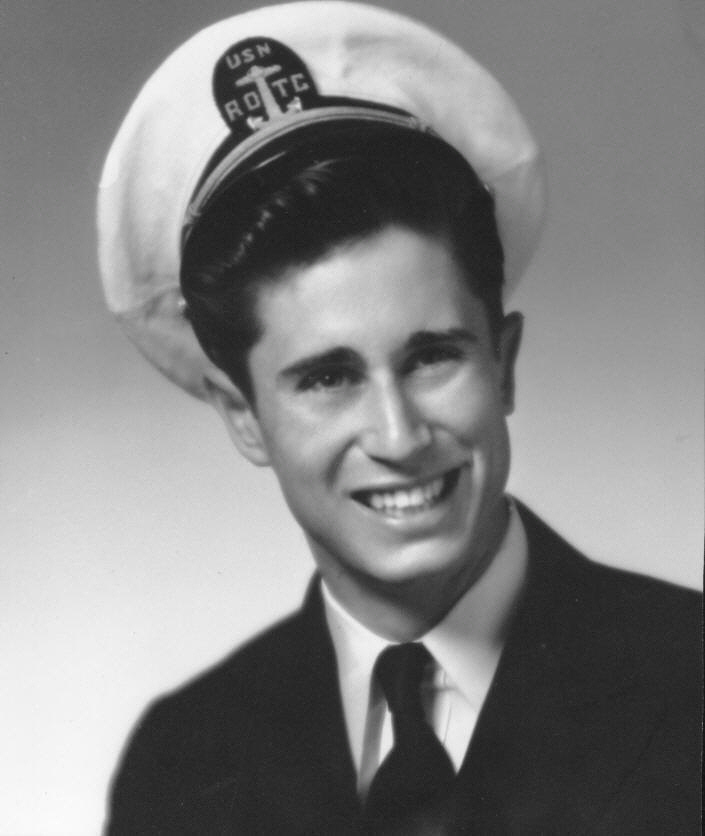
Midshipman , University of Texas (Hahn Collection)
Navy Swing Band, University of Texas, Austin Texas, 1945
Standing: (left-to-right) T. L. Belknap, K. H. Otto, T. F. Hahn, D. Brannon, R. L. Hardesty, J.P. O'Donnell Seated: (left-to-right) J. L. Bacon, T. V. Hodges, W. E. Barrington, J. C. Robinson, L. E. Goodman (Hahn Collection)
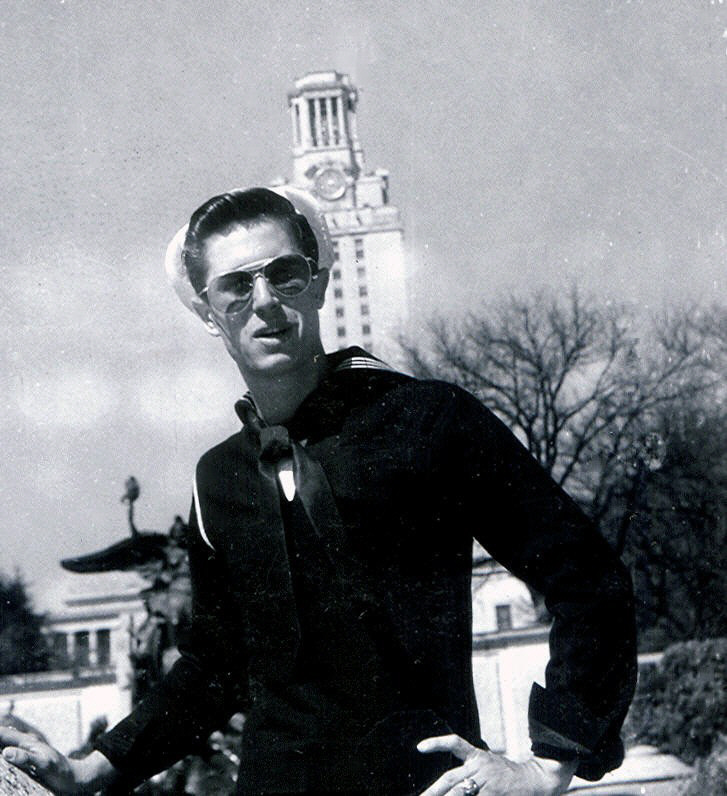
When the Longhorns won a football game, tower lights glowed orange.
(Hahn Collection)
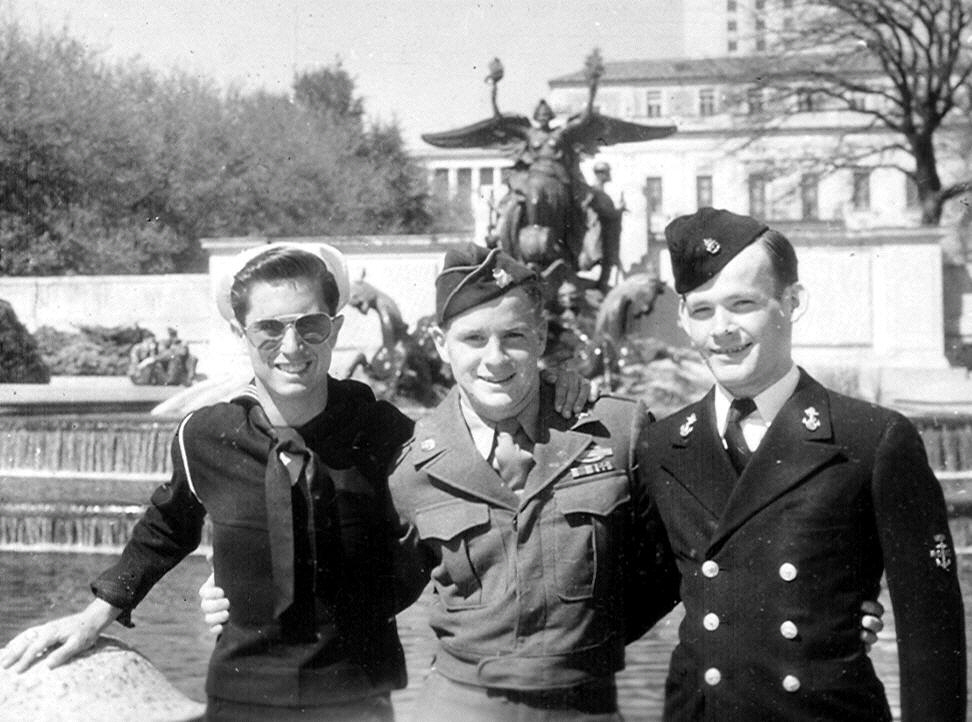
University of Texas, 7 April 1946. Left-to-right: Tom Hahn, Bill Michie, Joe "Scott"
Briar. Scott and Tom were high school buddies. Bill Michie, from Doylestown,
Pennsylvania, was one of Tom's Navy roommates at the Southern Methodist
University at Dallas and the the University of Texas at Austin. Scott was a
Sergeant in the Army stationed at Fort Hood, Texas, but when he visited
Austin, he and Scott sometimes changed uniforms, as shown here. (Hahn Collection)
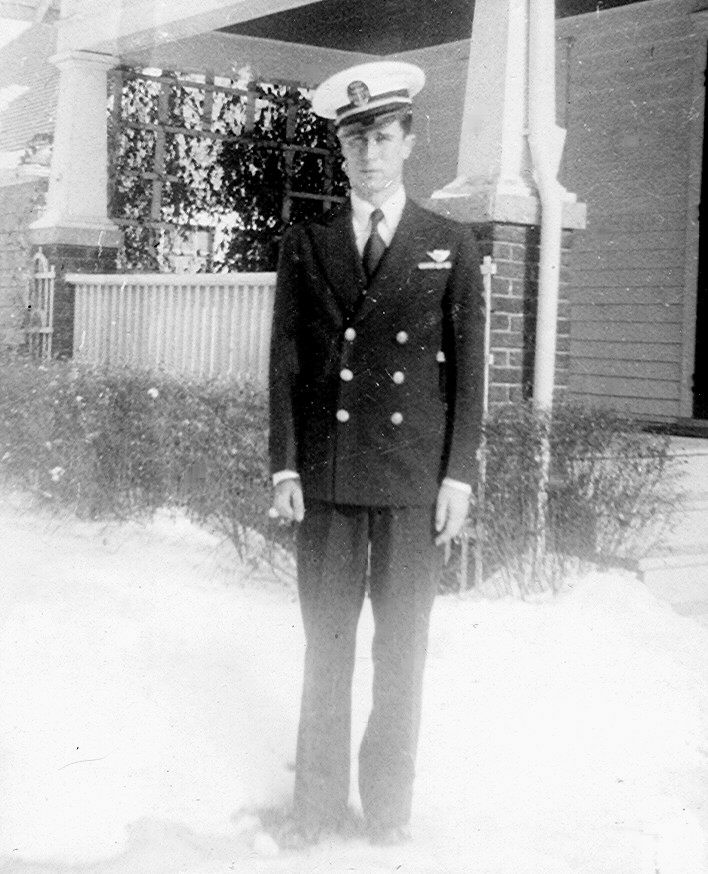
Tom Hahn on Christmas Leave at Topeka, Kansas from Austin, Texas
(Hahn Collection)
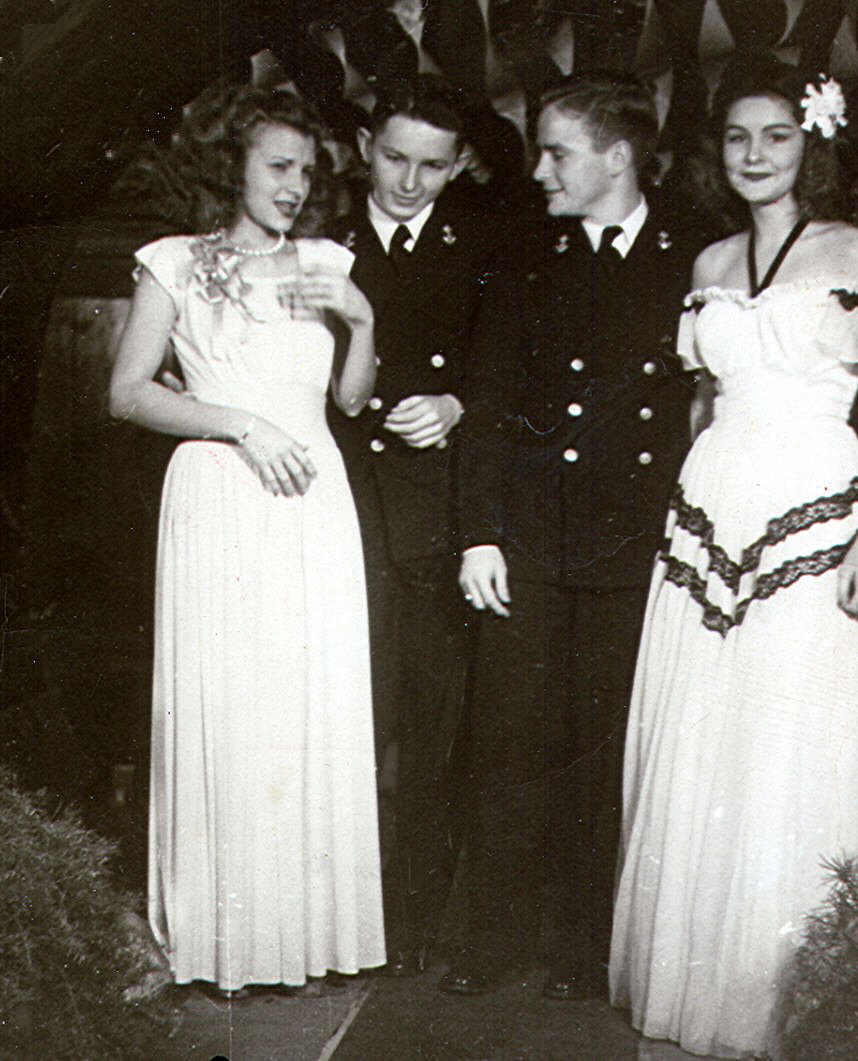
My wonderful Roommates at Southern Methodist University and the
University of Texas and their Girl Friends. Left: James L. "Jim" "Brew"
Brewbaker of Longmont, Colorado and right: William "Bill" Mich" Michie of
Doylestown, Pennsylvania. (Navy Photo) (Hahn Collection)
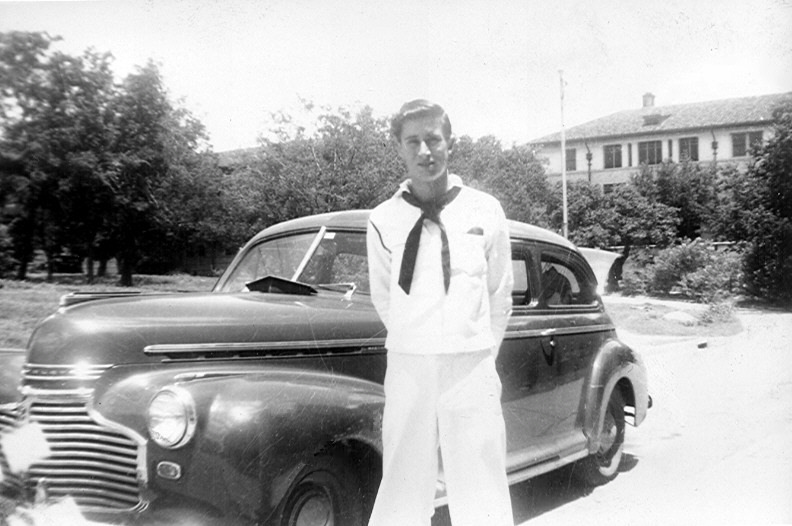
Tom Hahn in June 1946 near Prather Hall where he lived while attending the
University of Texas, Because I am in sailor whites, I was probably about to
depart for the Navy Personnel Separation Center at Camp Wallace, Texas. (Photo
by Walter Hahn)
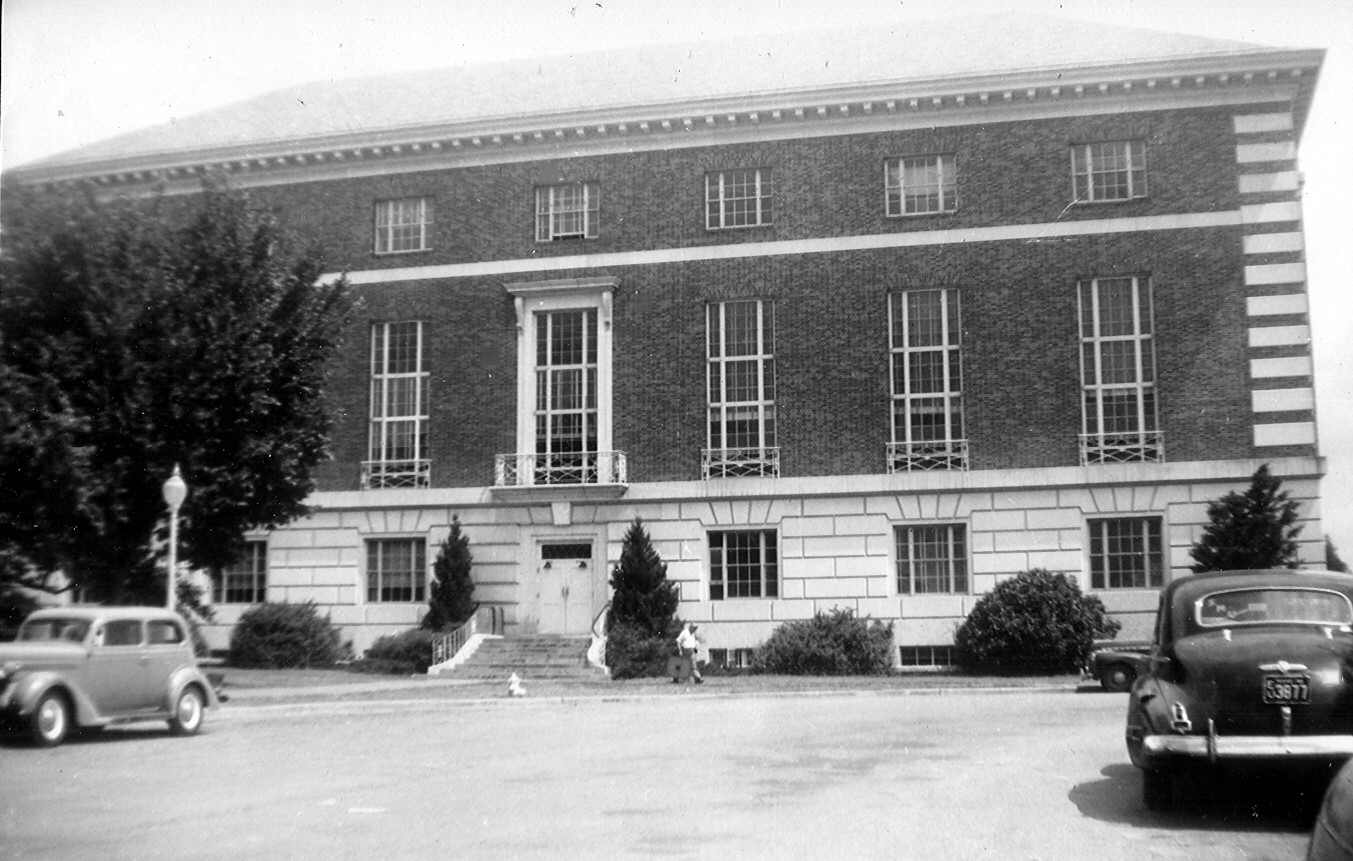
Prather Hall, Residence Hall for NROTC Program, University of Texas. That may be
Walt Hahn's car to the right and he may be the one carrying something away from
the building. (Walter Hahn Photo)
27 June 1946 -- Separated from the Naval Service under the Point System established for World War II at the USN Personnel Separation Center at Camp Wallace, Texas. The Honorable Discharge Certificate and the Notice of Separation (DD-214) Certificate were filed with the Register of deeds, Shawnee County, Kansas, on 3 July 1946. The Notice of Separation from the Naval Service said that the Serial Number was 343-27-20 and that Thomas Frederick Hahn was a Seaman First Class (Aviation Radioman) S[?]V V-6 USNR. It also said that off-duty courses in Economics at the University of Kansas and off-duty courses in German and Psychology at the University of Texas had been completed.
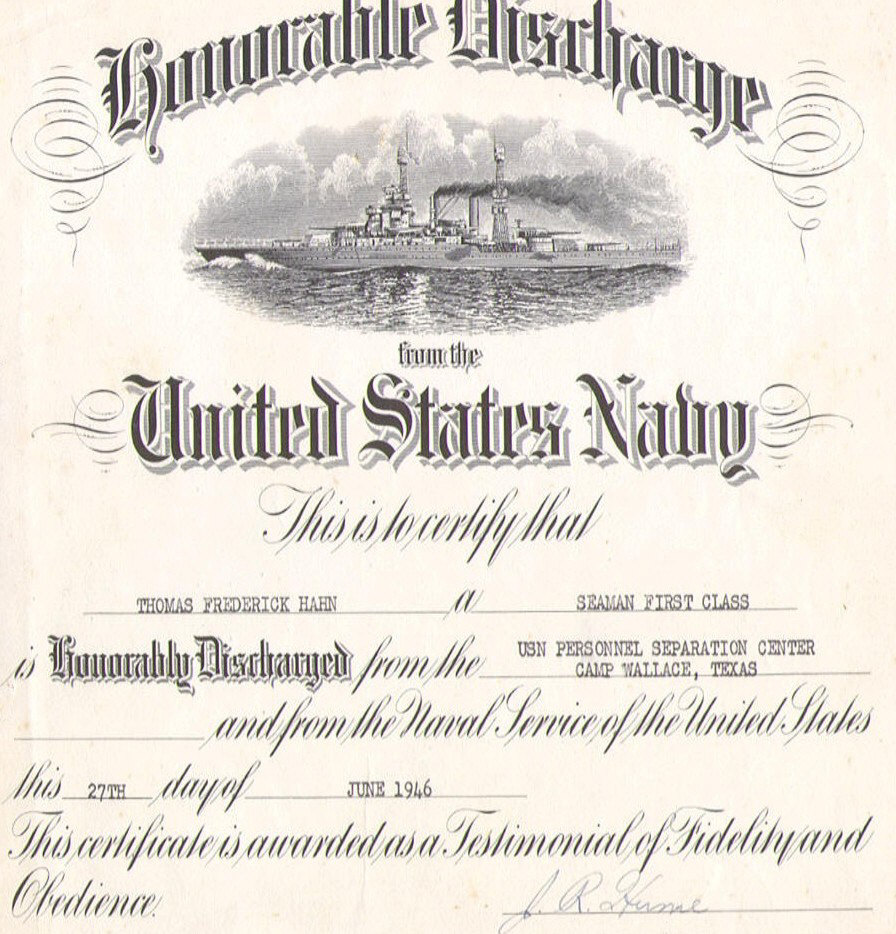
(Hahn Collection)
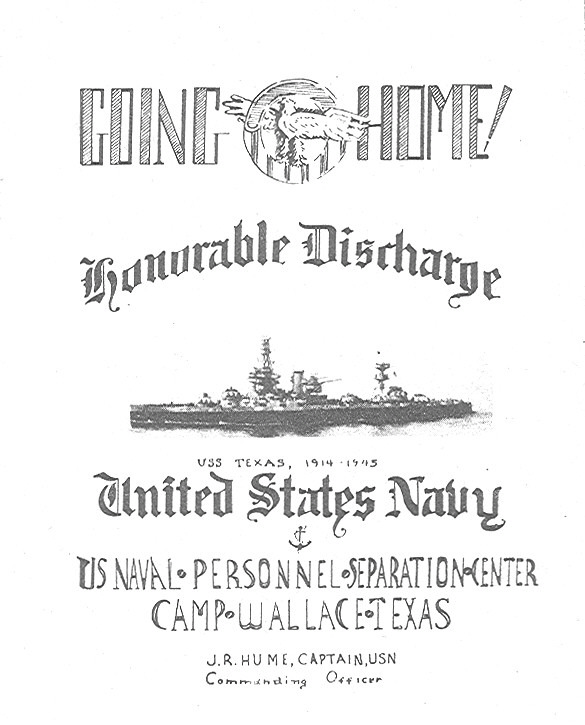
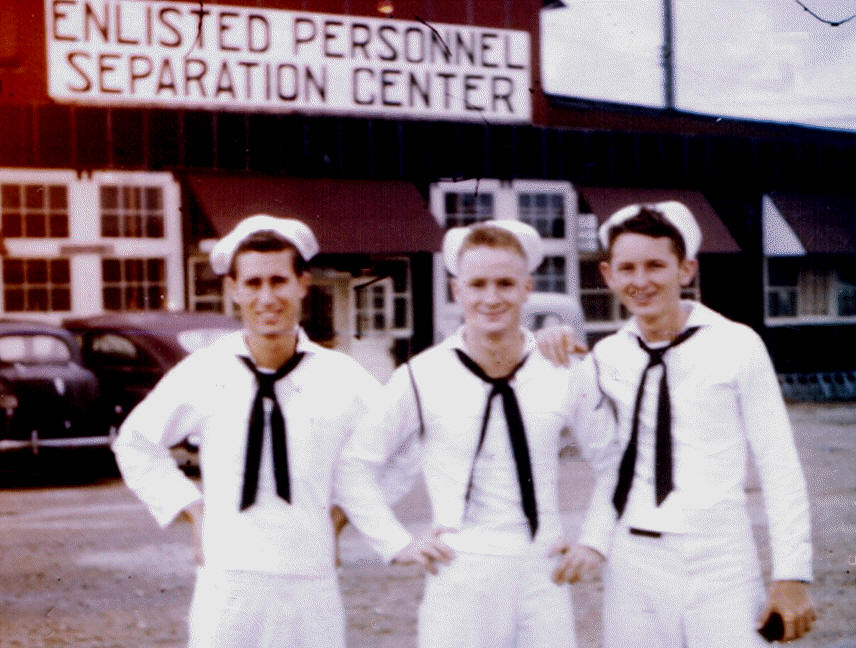
Roommates at Southern Methodist University and the University of Texas.
Left-to-right: Tom Hahn, William "Bill" Michie from Doylestown, Pennsylvania, and
James "Jimb "Brew
L.
Brubaker from Boulder, Colorado. (Hahn Collection)
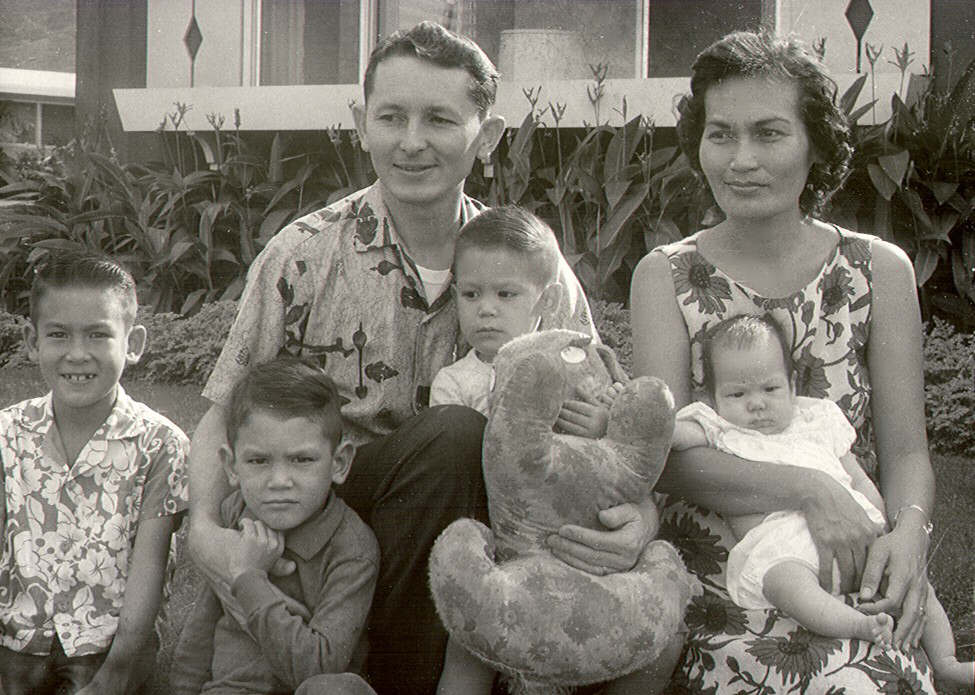
Jim Brewbaker with his First Wife Helen in 1963 and their Chidren
(left-t-right) Jin, Paul, Philip, Perry, and Pamela Barbara Jean. The children
may not be in the order shown. In 2005, Dr. Brewbaker remains a Professor of
Agronomy at the University of Hawaii.
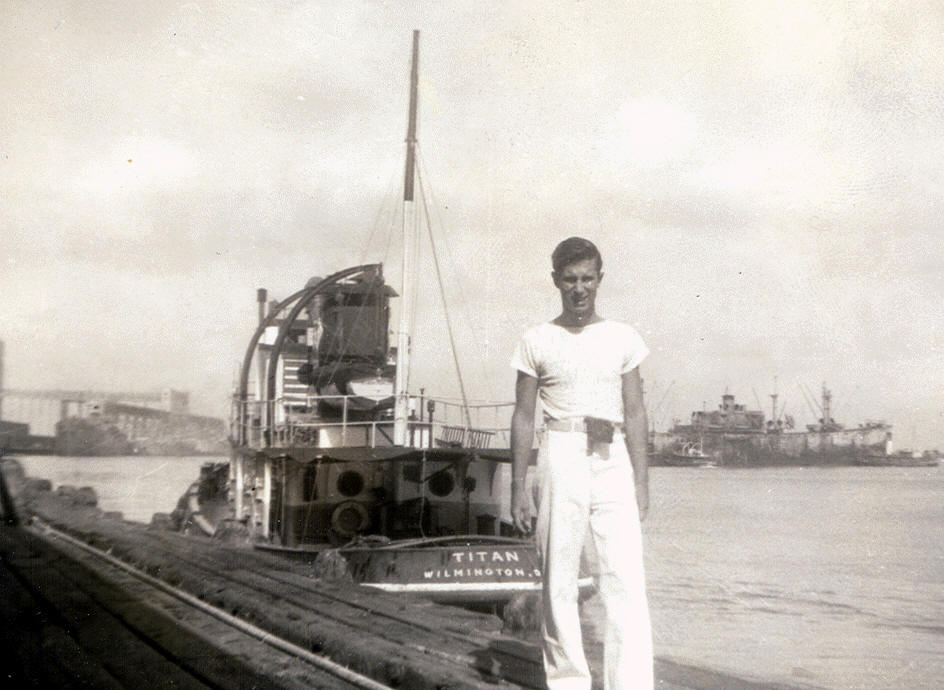
Tom Hahn, Seaman First Class, Galveston Texas 1946 (Photo by Walt Hahn)
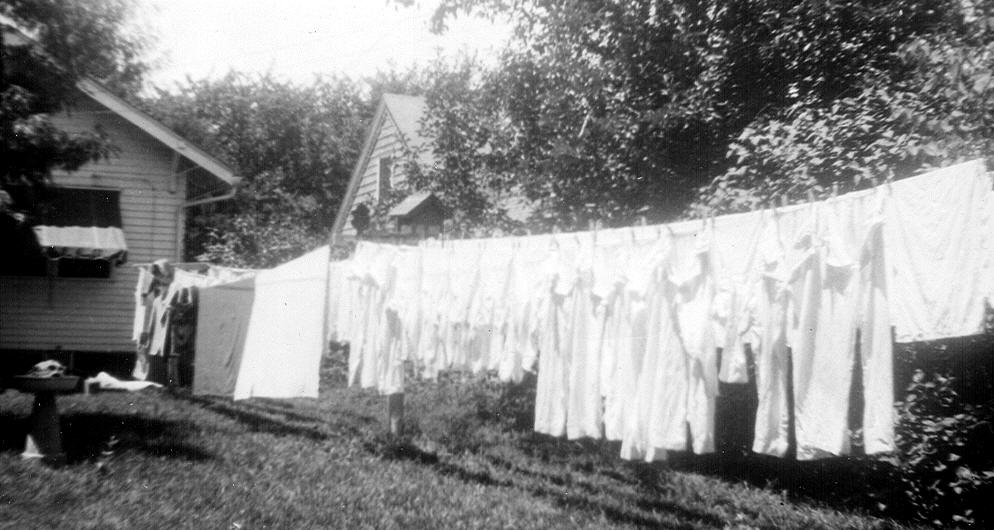
Washing of navy clothes after Tom returned to his home after being discharged
from World War II in June 1946 (Photo by Tom Hahn)
September 1946-June 1948 --
Midshipman and Sub-Battalion Commander, Naval Reserve Officer Training Corps
(NROTC) University of Texas, Austin, Travis County, Texas,
Graduated first in the Midshipman Class of 1948.
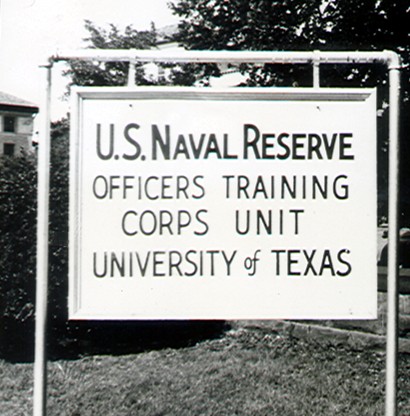
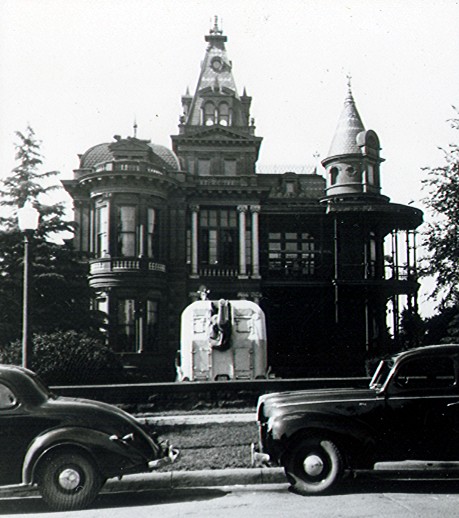
Headquarters of the NROTC Unit at the University of Texas, where
Tom took most of his Naval Science Courses (Hahn Collection)
While a Midshipman at the University of Texas (Thomas Hahn Collection)
Tom at the Fountain of the University of Texas (Hahn Collection)
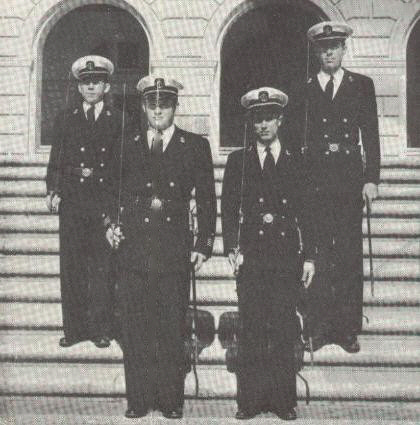
Battalion Staff, Naval Reserve Officer Training Corps, University of Texas, Austin, Texas 1946-1949. Front Row: James E. Harrell, Battalion Commander; Thomas F. Hahn. Battalion Sub-Commander. Second Row: Allen M. Kappler, Battalion Adjutant ; James R. Underwood, Jr., Battalion Chief Petty Officer (Hahn Collection)
July 1947 -- Midshipman Cruise July 1947 in Battleship USS IOWA (BB-61), from Yerba Buena (San Francisco). California. Pacific. Vancouver, British Columbia Canada.
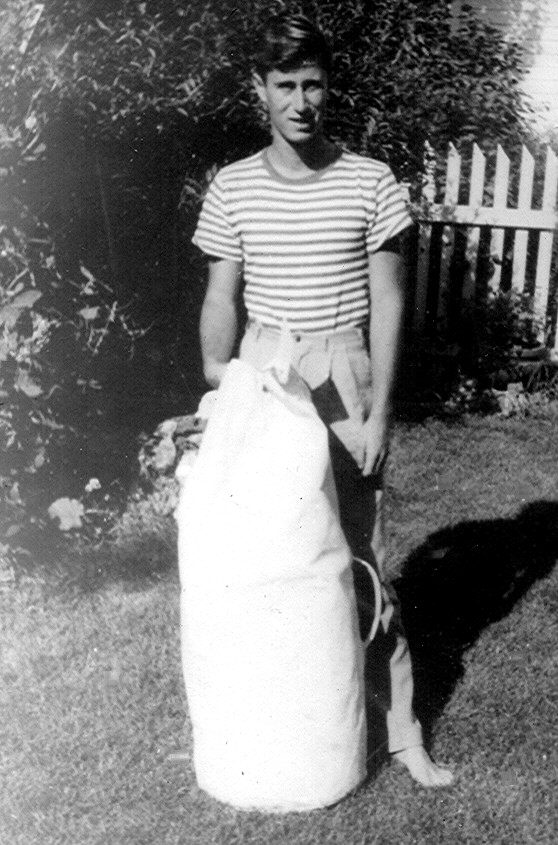
Tom Hahn at Topeka, Kansas Prior to Midshipman Cruise in USS IOWA
(Hahn Collection)
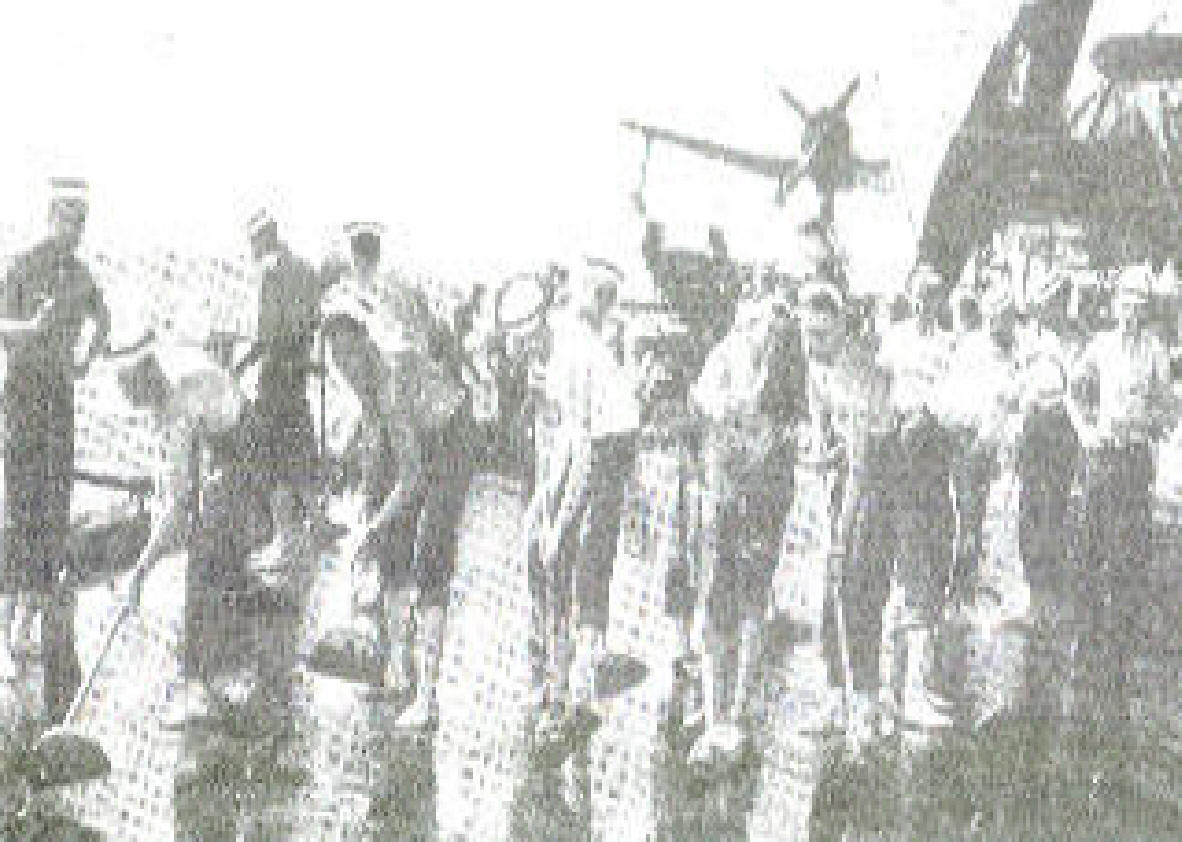
Swabbing the Deck of the USS Iowa (BB-61), August, 1947
(Hahn Collection)
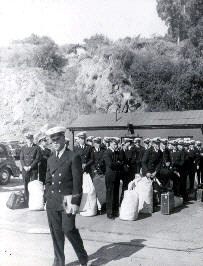
Members of Tom's Midshipman Class at the University of Texas Waiting to Embark
in the USS Iowa (BB061) at Yerba Buena, California in Summer of 1947 (Hahn Collection)
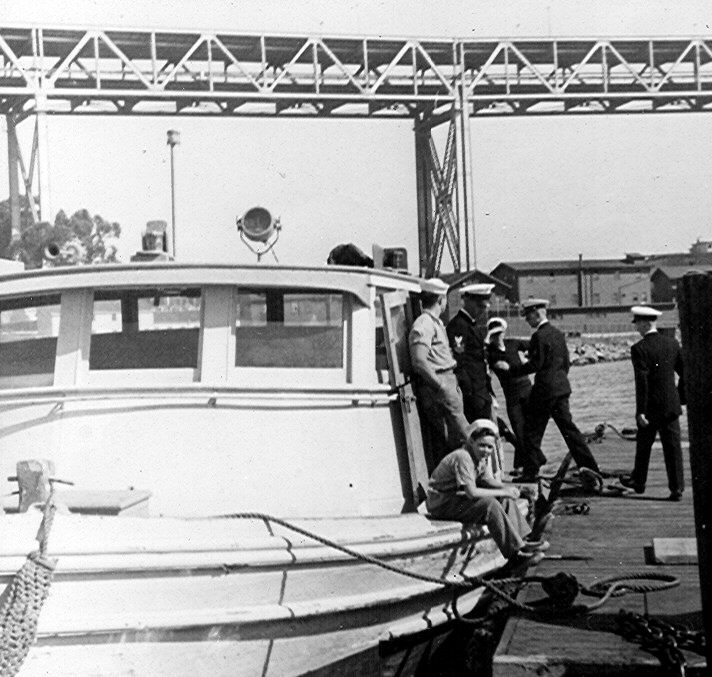
Midshipman Tom Hahn Boarding a Boat to USS IOWA at Yerba Buena,
California (Hahn Collection)
Battleship USS IOWA (BB-61)
31 May 1948 -- Discharged as a Seaman V6 United States Naval Reserve (U.S.N.R.)
1 June 1948 -- Commissioned Ensign (O-1), United States Navy, line officer designator 1100, File Number 501623. My home address at that time was 1120 High Avenue, Topeka, Shawnee County, Kansas. (Thomas Hahn Collection)
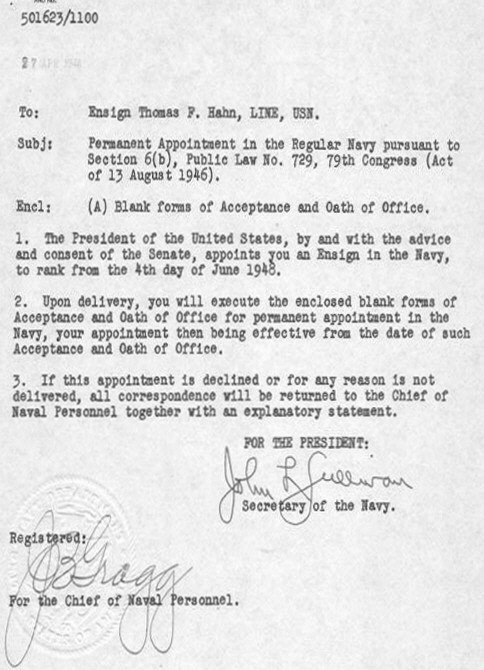
(Hahn Collection)
Congratulations are extended to Thomas F. Hahn, who has been nominated to the Senate as an Ensign, USN. Hahn has also been accepted for special duty by the Navy Department (Newspaper Item)
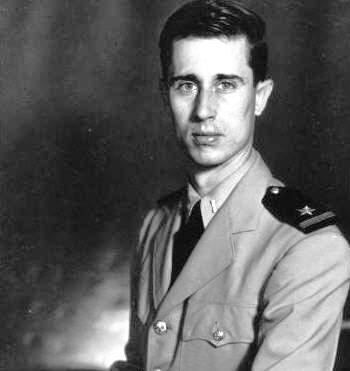
Tom Hahn, Ensign, U. S. Navy, Washington, District of Columbia, 1948 (Hahn Collection)
22 June - 5 July 1948 -- Naval Research
Analyst, United Stated Naval Security Station (NAVSECSTA), Naval
Supplementary Activity (OP-202), 3801 Nebraska Avenue N. W., Washington, District of Columbia.
Shipmates heard from, from this tour:
28 May 2006 Keith Adkisson, Cocoa Beach, Florida
The brief history of this organization below is from the web site http://www.fas.org/irp/agency/navsecgru/history.htm
The Naval Security Group traces its origins back to the first days of electromagnetic communications in the early part of the 20th century. The history of naval cryptology has a long tradition of service to the Navy and the nation.
The Navy has been concerned with protecting its signals against unauthorized use since the Civil War. More dramatic developments in cryptology came after the advent of radio communications in the Navy around the start of the 20th century. Beginning almost with the first wireless transmission from a Navy ship in 1899, Sailors and Marines have been assigned duties in communications security and intelligence. They conducted numerous experiments in this new field of warfare during World War I and dedicated themselves to drawing appropriate lessons from this experience in the years following.
The Code and Signal section of the Naval Communications Service undertook some cryptologic duties when the United States entered the war in 1917. In July 1922, it was assigned the familiar organizational title OP-20-G, which was retained until after World War II. Between 1924 and 1935, the Naval cryptology service developed operationally, culminating in the formation of the Naval Security Group effective 11 March 1935. That date marks the first appearance of the word "Group" in the title of the Naval cryptology organization and is observed as the birth of the Naval Security Group.
A handful of officers and small cadre of enlisted personnel trained themselves during the interwar period in the specific skills and knowledge of Naval signals exploitation and security. These pioneers formed the nucleus of the Communications Intelligence Organization during World War II. At the height of the war, nearly 10,000 naval specialists participated in the world-wide activities of the Naval Security Group. Their contributions played a role in all major campaigns of the war.
After 1945, the Navy was reduced in size and the consolidation of functions became necessary. The Navy Cryptologic organization was renamed Communications Supplementary Activities in 1945 and the trend toward centralized control continued. Increasingly complex technology and more sophisticated equipment added new responsibilities and accelerated the movement toward career specialties in signal exploitation and security. In 1948, officer designators and enlisted ratings were established for cryptologic personnel. A closer alliance with Army and Air Force Cryptologists was formalized in 1949 with the establishment of the Armed Forces Security Agency. The title "Naval Security Group" was adopted in late 1950 and has remained the official name. [The Naval Security Group was disestablished on 30 September 2005.]
6 July 1948 - 25 February 1949 --
Student, Naval Intelligence School (Russian
Language) Anacostia, Maryland
25 February 1949 -- Certified as a Russian Interpreter and Russian
Translator
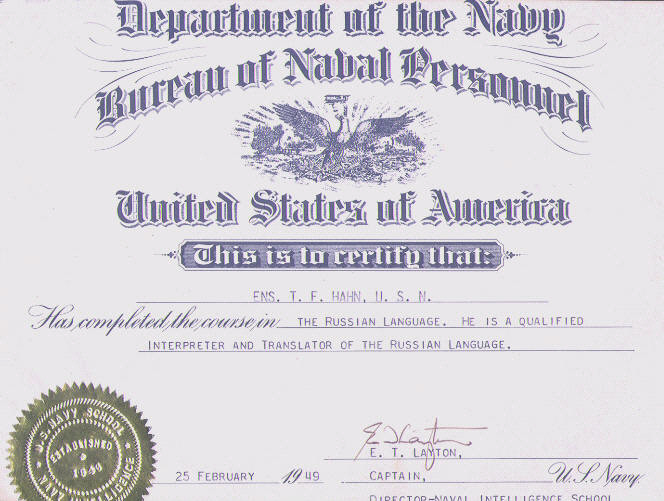
(Hahn Collection)
28 February 1949 - 24 January 1950 -- Navy Communication Supplementary Activity, Washington, District of
Columbia. Naval Research Analyst (Soviet Area)
24 January 1949 - 7 April 1950 -- Armed Forces Security Agency (AFSA), Arlington Hall Station,
Arlington Fairfax County, Virginia, Military Research Analyst (Soviet Area). Russian Interpreter and Russian
instructor. There was a six-month tour in the middle of this
tour to the Sixth Fleet in the Mediterranean Sea, described below.

Arlington Hall was the headquarters of the US Army Intelligence and Security Command's (INSCOM) cryptography effort during World War II. It was named for its location in Arlington Hall Station, Arlington, Virginiaóa private girls' school which was commandeered during the War. Arlington Hall was in many respects similar to Bletchley Park in England, though military and only one of two primary cryptography operations in Washington during the War (the other was the Naval Communications Annex, also housed in a commandeered private girls' school). Arlington concentrated its efforts on the Japanese code PURPLE while Bletchley admitted to the Americans in 1943 that it had broken the Nazi Enigma cypher. Arlington Hall eventually became one of the facilities of the National Security Agency or NSA after it was created. The Arlington Hall effort was comparable in influence to other Anglo-American WW II-era technological efforts, such as the cryptographic work at Bletchley Park, the Naval Communications Annex, development of microwave radar at MIT's Radiation Lab and the Manhattan Project's development of nuclear weapons. (Source: www.nationmaster.com )
During the Korean War, the Naval Security Group recalled several reserve officers and some of them served in the same Russian Voice Unit that I was in. Two of my favorites were Dayton Howe (living 2005) and Maury Briggs (deceased).
Dayton Howe (left) and Maury Briggs in the Presidential Yacht Sequoia, Washington, D.C.
***
9 April 1950 - 10 November - Communications Unit 34.2 (Sixth
Fleet Language Officer. Sixth Fleet (Mediterranean) Heavy Cruisers USS NEWPORT NEWS (CA-148),
USS SALEM
(CA139), and USS DES MOINES (CA-134) This was probably the best tour of duty that I had from a point of view of
location and pleasurable things to do. Visiting various ports and enjoying the exotic life on the
Mediterranean at Villefranche-sur-Mer, the home port of the Sixth Fleet, were
extremely enjoyable.
Shipmates heard from Communications Unit 34.2 on this
cruise:
28 May 2006 Jack Haizlip (and Lorrain)- Macon, GA. Still hanging in there at age
86.
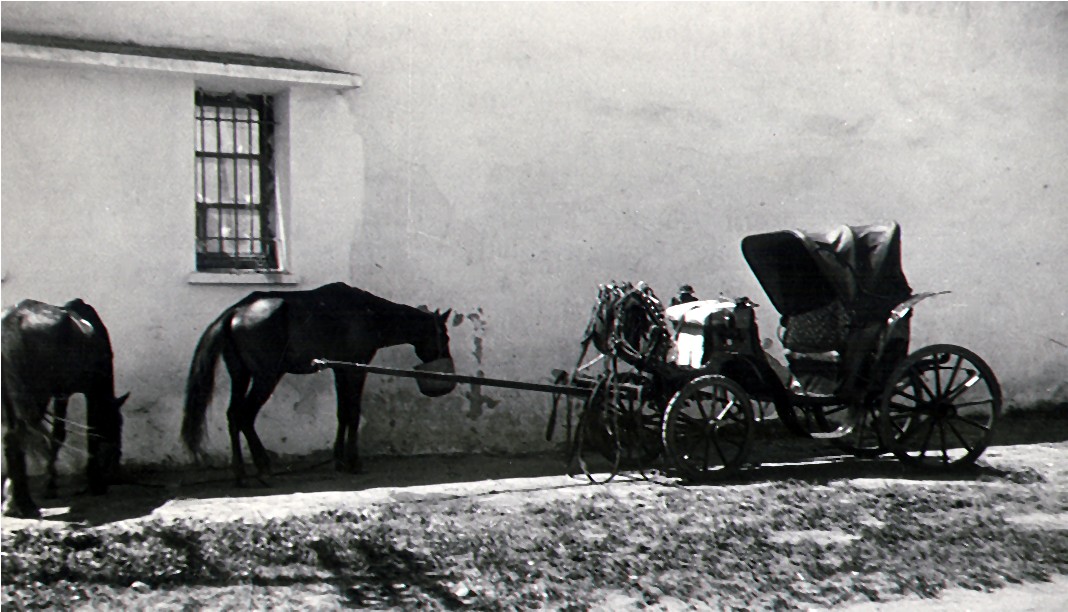
Port Lyautey, French Morocco April 1950. A wonderful country to
visit. (Tom Hahn Photo)
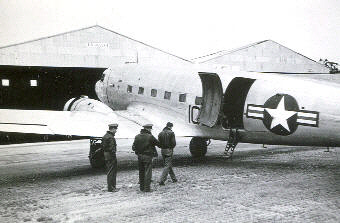
R4D Transport at Algiers 1950 enroute to Naples, Italy (Hahn Collection)
To go from Washington, District of Columbia, to the Sixth Fleet at Naples via Port Lyautey, French Morocco, with the Military Airport Transport Service (MATS) was not simple in 1950. First I flew from Washington National Airport to New York City, then to Westover Field, Massachusetts, where we spent the night, then via PB4Y2 (C-54) to Goose Bay, Labrador, then to the Azores where we spent another night, then to Port Lyautey. An engine in this R4D aircraft in which I flew from Port Lyautey, French Morocco to Naples, Italy. caught fire on the Port Lyautey-Algiers leg.
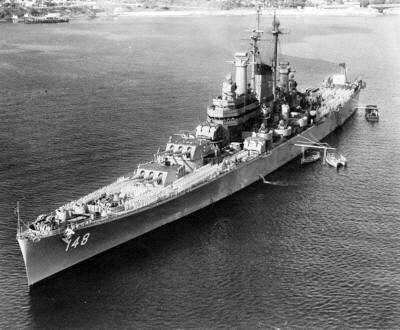
Heavy Cruiser USS NEWPORT NEWS (CA-148)
|
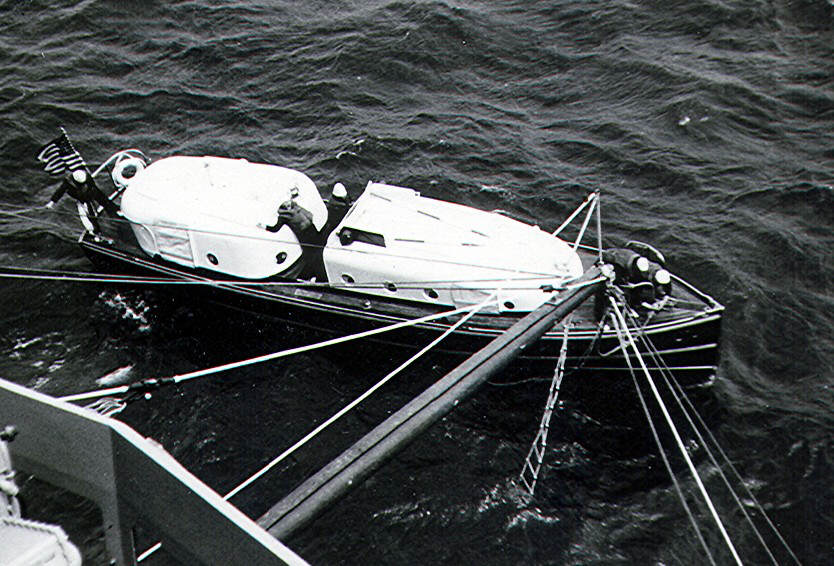
Admiral Ballantine's
Barge, Mediterranean Sea, 1950 (Tom Hahn Photo)
There is a little story that goes along with this photograph. I reported as
an ensign to Admiral Ballantine's Staff, the Admiral of the Sixth Fleet,
while his flagship, the USS NEWPORT NEWS (CA-148) was anchored at Naples,
Italy. The first evening aboard I had liberty and wanted very much to go
into Naples, the first place that I would visit in Europe. I went up to the
Quarter Deck to see if I could catch a boat going ashore. It was a stormy
night and the seas were very rough. The OOD (Officer of the Deck) said,
"There is no liberty, but no boats because of the rough sea. " I said, "I
would REALLY like to get ashore, so he said, "It is too rough for a gangway
but you can climb down the Jacob's Ladder to get to the boat below." This
was sort of a flexible metal narrow ladder with round rungs. Halfway down,
someone above stepped on my hands, and I yelled, "Get the hell of my hands
or I will fall into the drink!" When I got to the bottom I saw this nice
boat and I pulled the entry curtain and got it. It was really plush. Just as
I was looking around the curtain opened and all I could see at first was one
broad strip, and two narrow stripes on a sleeve, the mark of a Vice Admiral.
It was Admiral Ballentine. When he got in, I said, "You don't know me, sir,
but I reported to your staff this afternoon as the Fleet Language Officer [a
cover for intelligence]." Luckily, he thought that amusing and said he
admired my zeal for wanted to go ashore!
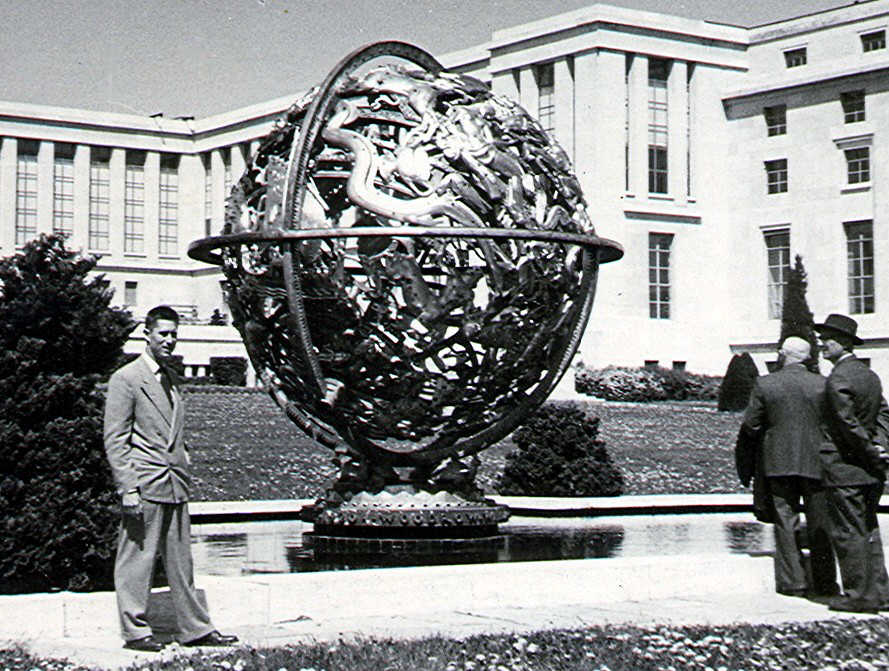
Tom Hahn at the Palace of the League of Nations at Geneva
Switzerland, April 1950 (Hahn Collection)
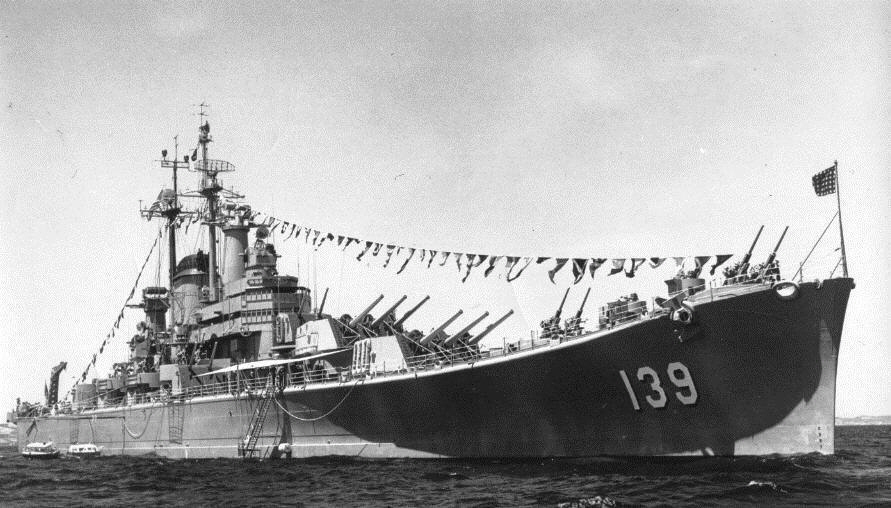
Heavy Cruiser
USS SALEM (CA-139), 1950
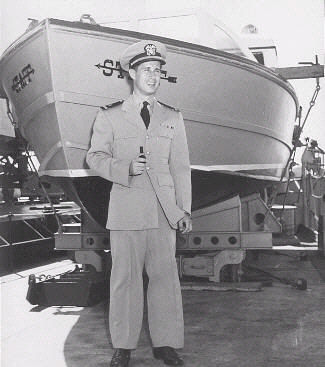
Ensign Thomas F. Hahn, U. S. Navy, USS SALEM (CA-139) in the Sixth Fleet Staff,
1950 (Hahn Collection)
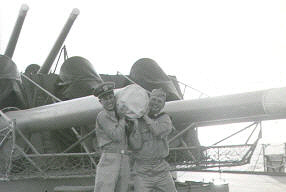
Ensigns Tom Hahn (left) and Jerry Wilda (right) Support one of the 8-inch Guns of the
USS Salem. (Hahn Collection)
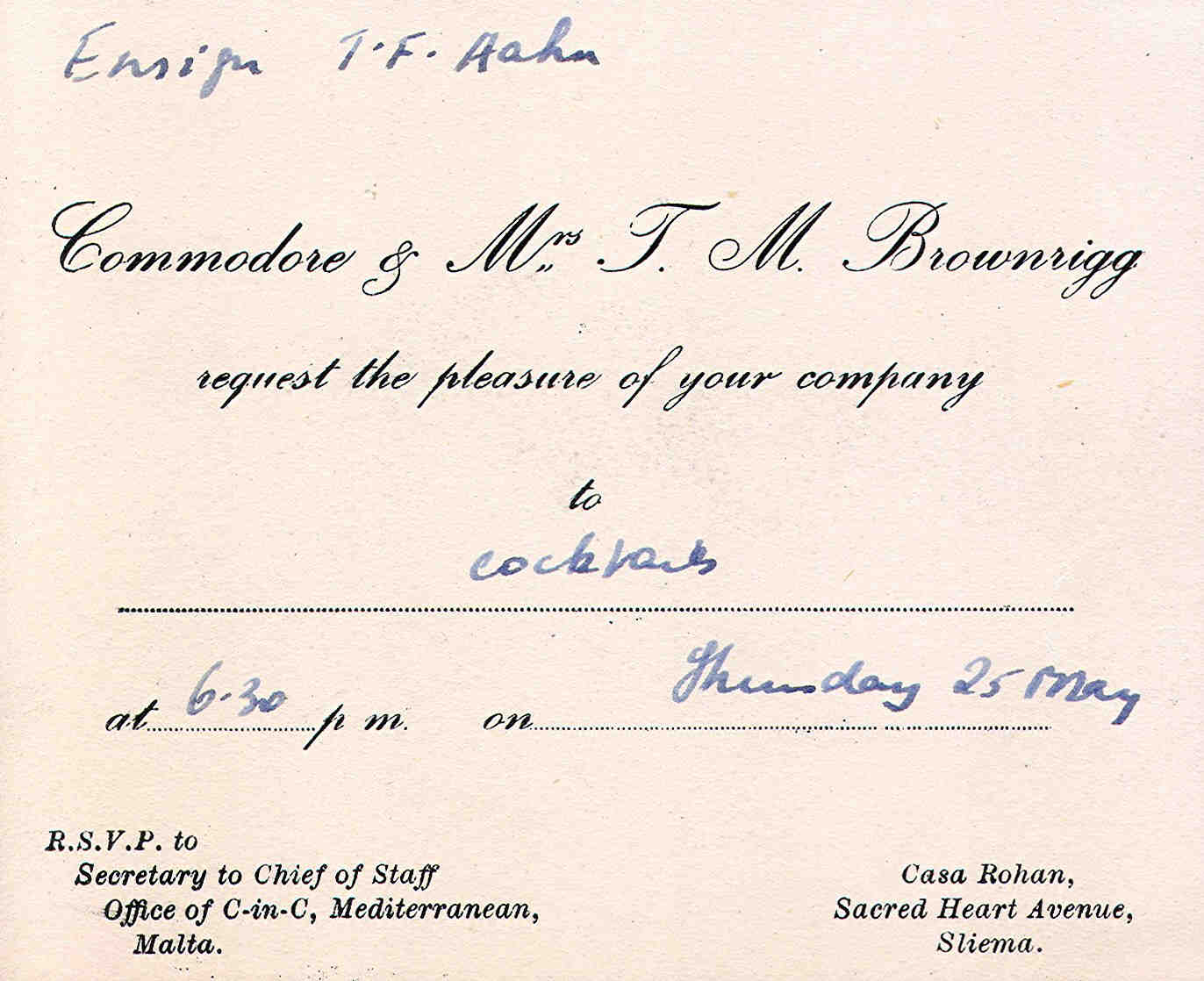
This is typical of the kinds of functions Sixth Fleet Officers
attended to help "Show the Flag" in the Mediterranean Sea. (Hahn Collection)
The USS Salem and her sister ships Des Moines and Newport News were the ultimate in World War II heavy cruiser development. She carried fully automatic 8" guns, 6" 38 caliber secondary armament and a full complement of 3"/50 rapid fire AA guns. Originally designed to carry 4 floatplanes, they were obsolete by the time of her 1949 commissioning and in service she carried a utility helicopter
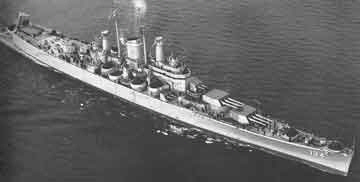
Heavy Cruiser USS DES MOINES (CA-134)
Displacement 17,000; 1ength 716'6"; beam 76'6"; draft 22'; speed 33 knots.; complement 1,799; class Des Moines) The second Des Moines (CA-134) was launched 27' September 1946 by Bethlehem Steel Co., Fore River, Quincy, Mass.; sponsored by Mrs. E. T. Meredith, Jr.; and commissioned 16 November 1948, Captain A. D. Chandler in command.
In a varied operating schedule designed to maintain the readiness of the Navy to meet the constant demands of defense and foreign policy, Des Moines cruised from her home port at Newport, and after 1960, from Norfolk, on exercises of every type in the Caribbean, along the east coast, in the Mediterranean, and in North Atlantic waters. Annually between 1949 and 1967 she deployed to the Mediterranean, during the first 7 years serving as flagship for the 6th Task Fleet (known as the 6th Fleet from1 1960).
Ports of call while Ensign Hahn was aboard with the Sixth Fleet Staff:
|
Crete |
8/16/50 |
Second Med Cruise |
|
Gulf Juan, France |
9/5/50 |
|
|
Tunis, N. A. |
9/13/50 |
|
|
Oran, N. A. |
9/19/50 |
|
|
Aranci Bay, Sardinia |
9/25/50 |
|
|
Augusta, Sicily |
9/30/50 |
|
|
Valetta, Malta |
10/6/50 |
|
|
Augusta, Sicily |
10/11/50 |
|
|
Messina, Sicily |
10/14/50 |
|
|
Villefranche, France |
10/30/50 |
|
|
Suda Bay, Crete |
11/5/50 |
|
|
Rhodes, Greece |
11/9/50 |
|
|
Athens, Greece |
11/13/50 |
|
|
Taranto, Italy |
11/20/50 |
|
|
Villefranche, France |
12/4/50 |
Transferred Flag to Newport News CA-148 |
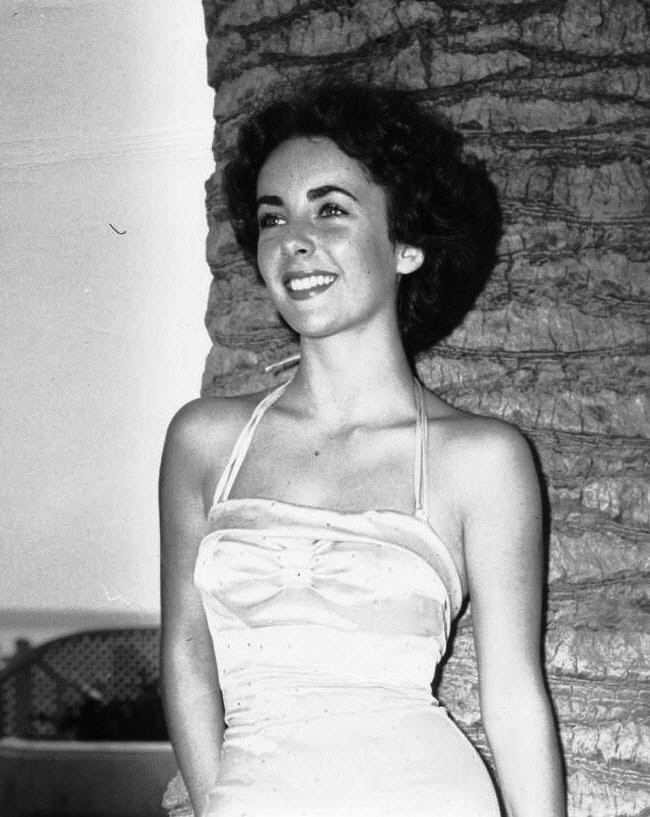
Liz Taylor at probably Antibes or Juan-les-Pins, on the Riviera, France, 1950
(Hahn Collection)
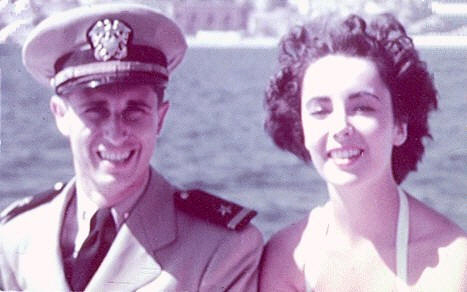
Tom Hahn and Liz Taylor on the French Riviera in 1950 (Hahn
Collection)
As a staff officer of the Admiral of the Sixth Fleet, I was expected to take part in numerous social activities where we were "showing" the American flag. The presence of Prince Phillip as the Commanding Officer of a British Ship, visits from such personages as the King and Queen of Greece, dancing with Rita Hayworth, flirting with Elizabeth Taylor (to the annoyance of her husband, Nicky Hilton, was it? getting a French friend elected as Miss Riviera of 1950, the presence of Gregory Taylor at the filming of one of the Hornblower movies, the presence of Errol Flynn and his yacht, ZACA at Villefranche-sur-Mer, and my confrontation with him on his yacht, being detained in Damascus by the secret police, etc., were among the things that made life hum in the Med.
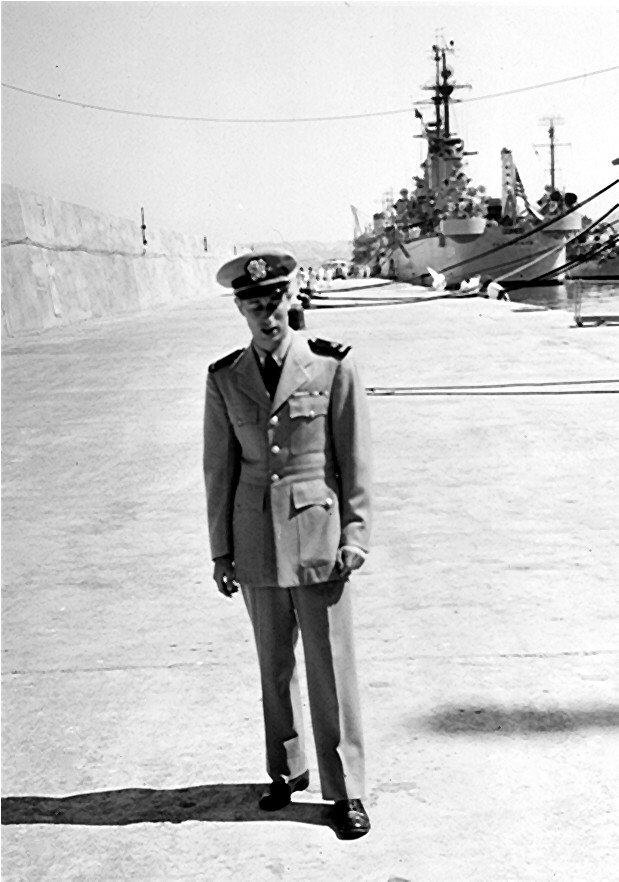
Ensign Tom Hahn at Mers El Kebir, Algeria (Hahn Collection)
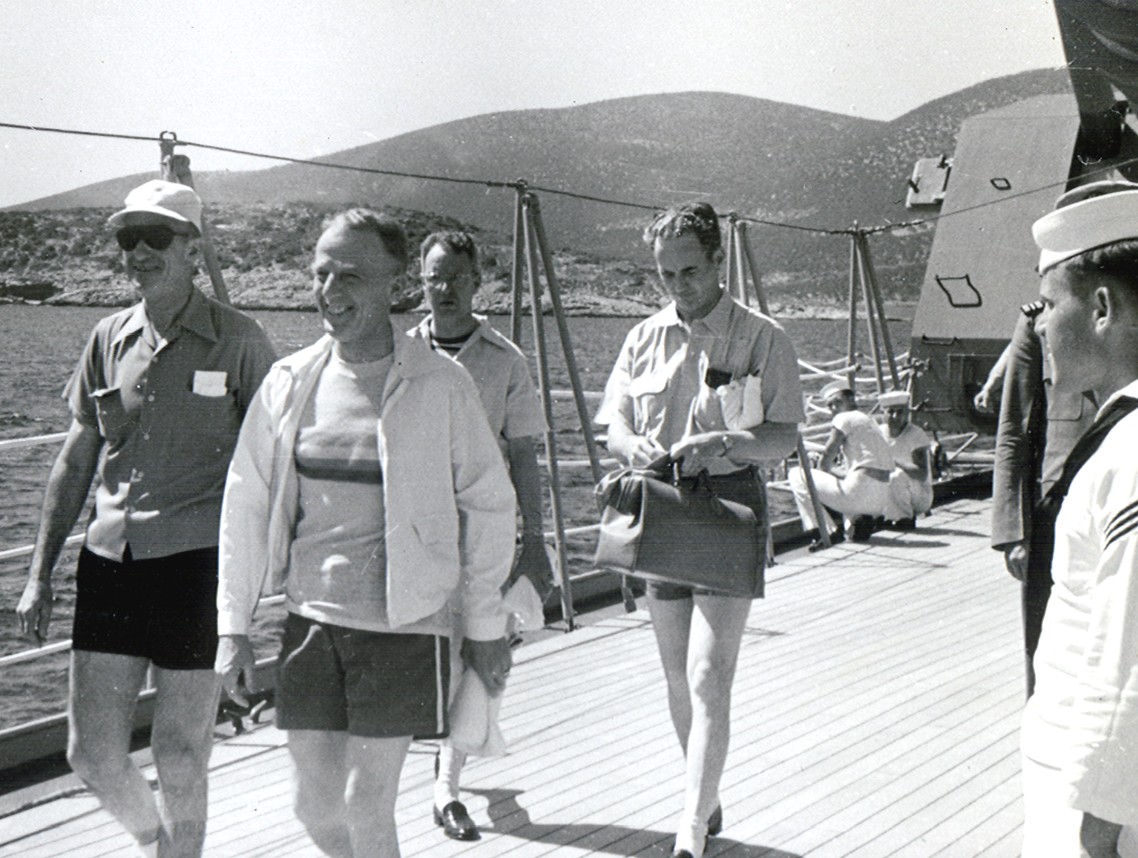
(Left-to-right, I think) VADM Ballentine, RADM Stokes, Chief of
Staff, and King Paul of Greece (?) going to Petalia for a swim from the USS SALEM
(?) in 1950. I will have to check whether or not this is King Paul in this photo
or not, or whether they [he and Queen Frederika?] are out of range in the photo
ahead of the others. (Tom Hahn Photo)
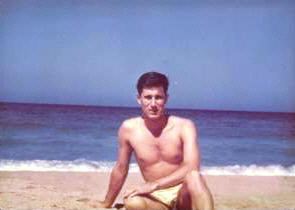
Mers el Kabir, Algeria (Hahn Collection)
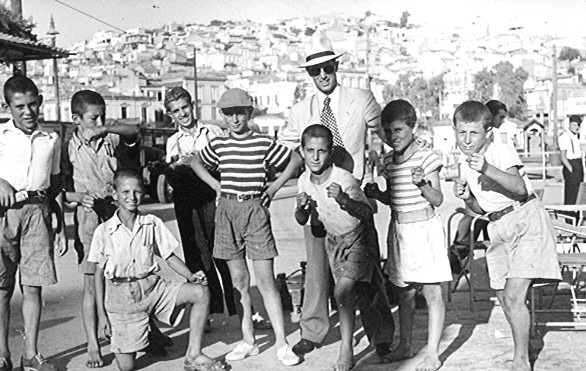
Ensign Tom Hahn at Athens, Greece 1950 (Hahn Collection)
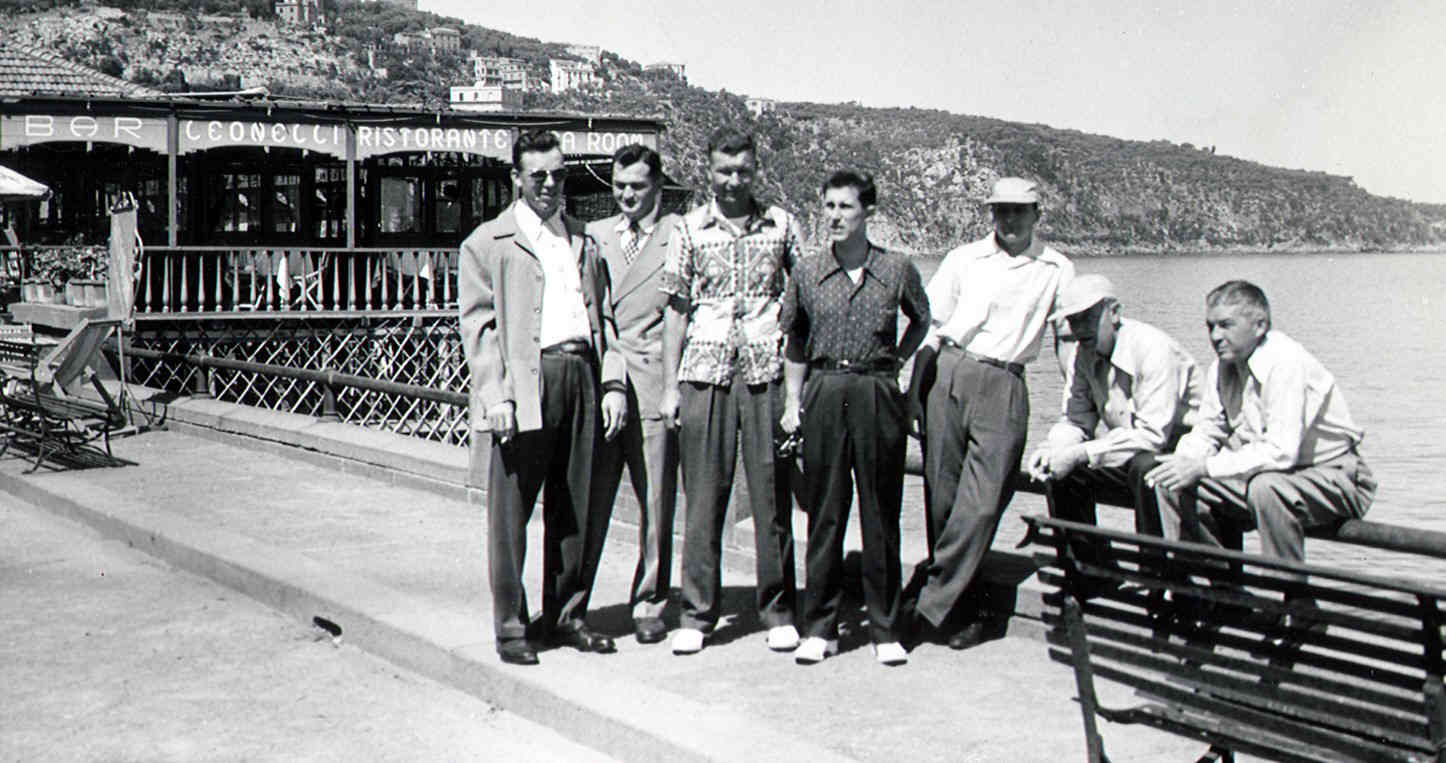
Officers from the USS SALEM (probably) or the Sixth Fleet Staff at Sorrento,
Isle of Capri, 1950 (Left-to-right:)
Bahan, Bill Powell, Andy Lovas, Tom Hahn, Ike Metzger, Lee Hogan and
Jackman (Hahn Collection)
* * *
11 November 1950-1951 --
Military Research Analyst, Russian
Interpreter/Instructor, Armed Forces Security Agency, Arlington Hall,
Arlington, Virginia,
14 April 1951 - Commissioned Lieutenant (junior grade) (O-2), United States
Navy
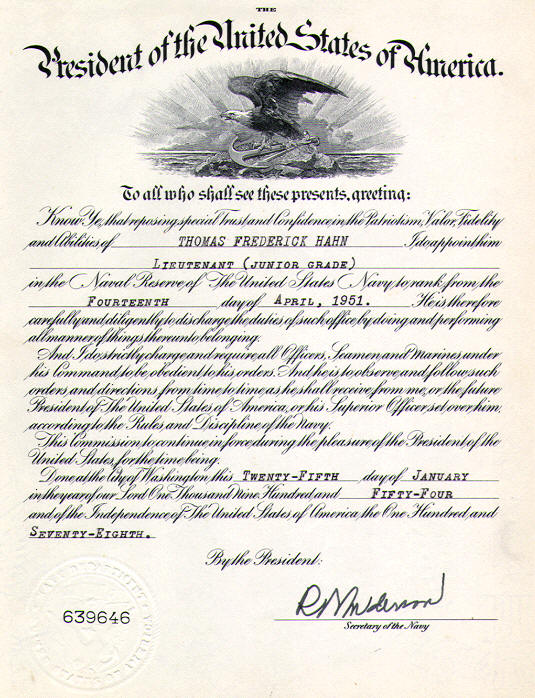
7 January 1952 -- Fleet
Training Center, San Diego, California. Duty-under-instruction in
preparation for assignment as the Communications officer of the USS Gladiator
(AM-319)
February 1952 - 2 June 1952 -- Fleet Minesweeper USS GLADIATOR (AM-319), Mine Force, Pacific Fleet,
Communications Officer

Received 20 February 1952
The Fleet Minesweeper USS GLADIATOR (AM-319) at the Recommissioning Ceremony on 29 February 1952. From a Long Beach newspaper: "The USS. COMPETENT, AM-316 the USS DEVASTATOR, AM-318 and the USS. GLADIATOR AM-319, will be re-commissioned at Pier "D", Long Beach Group, Pacific Reserve Fleet, U. S. Naval Station, Long Beach, California."
USS GLADIATOR
COMPLEMENT OF OFFICERS AT RECOMMISSIONING
Lieutenant Joe R. Perry Commanding Officer
Lieutenant Jack D. Bounds Executive Officer
LTJG Robert A. Powell LTJG Thomas F. Hahn LTJG Theodore T. Fish LTJG Thomas F. McGann
Chief Bosun Joseph McElroy
Setting of the First Watch of the Recommissioned USS GLADIATOR (AM-319) on 29 February 1952. Lieutenant (junior grade) Thomas F. Hahn, the First Officer-of-the-Deck, is Second from Right (Hahn Collection)
The Crew of the USS Gladiator (AM-319) at the Long Beach Naval Ship Yard on 29 February 1952. LTJG Tom Hahn was not in the photograph because he was the Officer-of-the-Deck at the time and was aboard the ship. In the middle row, in the lineup of Chief Petty Officers and Officers, the third person from the left is, I believe, LTJG Theodore "Ted" Ted Fish, the Chief Engineer. Ted later played in several navy movies, usually as a tough Chief Petty Officer. One time when my parents visited Long Beach, Ted and his wife showed up after a stint of gambling at Las Vegas. Among other things on that trip, he managed to flush $10,000--a considerable sum for a navy man in those days--down a toilet stool. I believe the second CPO/officer, second-from right, is Chief Bosun Joseph McElroy ( Hahn Collection)
The second Gladiator, originally BAM-6 [HMS Blaze], was launched 7 May 1943 as AM-319 by the General Engineering & Drydock Co., Alameda, Calif.; sponsored by Mrs. Made line A. Silva; and acquired and simultaneously commissioned 25 February 1944 Lt. Comdr. Robert W. Costello in command. Recommissioned 29 February 1952 at Long Beach, Calif., Gladiator sailed 2 September for Japan, closing Sasebo 1 month later, and steaming to Wonsan, Korea, 27 October. She swept mines in those dangerous waters until returning to Sasebo 10 November and subsequently, until the spring of 1953 divided her time between minesweeping operations at Wonsan, Inchon, and Hungnam and replenishment and training exercises; in Sasebo and Yokosuka.
USS Gladiator (AM-319) Carrying out a Minesweeping Exercise in the Pacific Ocean off the California Coast, c1952. LTJG is on the bridge on the starboard side forward. The Captain, LT Joseph Roderick Perry, is on the port side, forward ( Hahn Collection)
* * *
6 June 1952- 1 December 1953 -- Boat Control Officer (Amphibious Landings), Chief Engineer, and Operations Officer, Patrol Craft Escort (Control) USS PCEC 886, Amphibious Forces (Pacific Fleet/Korean Theater).
USS PCEC-886 Operating in the Pacific Ocean. ( Collection) Tom Hahn on the bridge as the Officer-of-the-Deck, has the Con (control) of the vessel. The bridge in a PCEC is open to the weather. It was not a comfortable place to be in hot or inclement weather, or when inhaling diesel fumes, a condition caused when the wind from the stern is stronger than the forward speed on the vessel. We ate fumes all the way from Long Beach, California? to Yokosuka, Japan-- at seven knots I think it was. Whenever a diesel bus passes and I get a whiff of the fumes, I think of that trip. (The photo was purchased from a company that specialized in ship portraits.)
A similar vessel, PCE-881 Class Patrol Craft Escort, was laid down on 29 March 1944 by the Albina Engine and Machine Works, Portland, OR; Launched, 10 July 1944; Commissioned USS PCE-886, 31 May 1945; Reclassified Amphibious Control Vessel PCE(C)-886, (date unknown); Named Banning, 15 February 1956; Reclassified back to a Patrol Craft Escort PCE-886, (date unknown); Decommissioned, 1950 and placed in reserve at Columbia River, OR; Struck from the Naval Register, (date unknown). Fate unknown. Specifications: Displacement 640 t; Length 184' 6"; Beam 33'; Draft 9'; Speed 16.5k; Complement 96; Armament one single 3"/50 gun mount, three single 40mm Gun Mounts, four single 20mm Guns, two dct, four dcp, one dcp (hh); Propulsion two 1,000 shp General Motors 12-268A diesel engines, two shafts. [Editor: Check this description.] PCEC-886 (Patrol Craft Escort Control) was engaged in amphibious control training and operations operation out of San Diego in 1952. 1952-1953 the ship was engaged in amphibious operations in Japan and Korea during the Korean War. In that conflict, crew members earned the Combat Action Ribbon, the United Nation Service Medal, the Korean Service Medal for three campaigns, the Korean Presidential Unit Citation, and the Republic of Korea Medal. After undergoing preparations at the Hunter's Point Naval Shipyard in San Francis late in 1953, the ship was decommissioned Francisco in early 1954.]
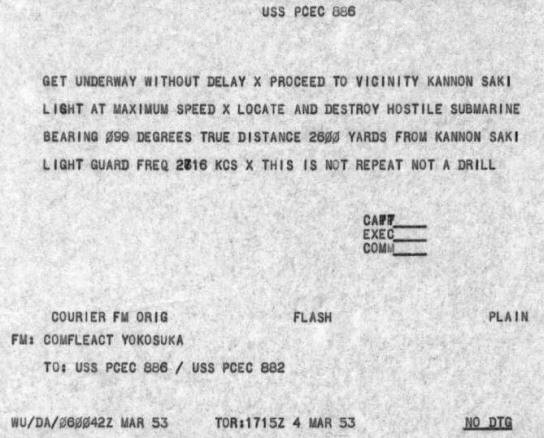
On 4 March 1952, in the afternoon, at Yokosuka, Japan, we received this flash message. We only had part of the crew aboard as most of the crew was ashore. We got underway and were just about to drop depth charges at the designated place when we received another flash message not too. I have always wondered what this was about, as I know of no other attack by any Russian or Chinese submarine during the Korean War. I think that I will send this message to the Naval Institute to see if anyone has an explanation. ( Hahn Collection)
Going on Liberty at Yokosuka, Japan from the USS PCEC-886. This was probably the port that we used most often in the Korean War. ( Hahn Collection)
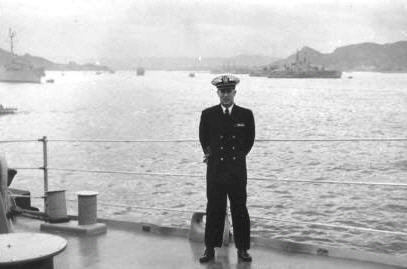
From the deck of USS PCEC-886. We often worked out of Sasebo, Kyushu, Japan
( Hahn Collection)
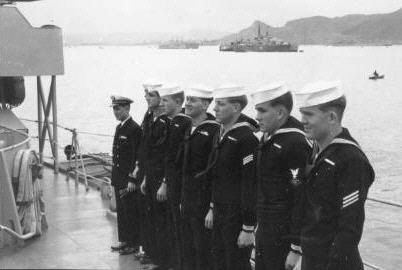
Part of My Operations Division in the USS PCEC-886 at Sasebo, Japan., (
Hahn Collection)
Aboard the USS PCEC-886 Prior to Going on Liberty. I sometimes used this little fold up bike in Japan, and later on in New Haven, Connecticut. ( Hahn Collection)

Ensign Mac Berringer, Lieutenant Ernest L. Carpenter (Commanding Officer),
Lieutenant (j.g) of the USS PCEC-886 at the Army Bachelor Officers Quarters at Inchon,
Republic of Korea (Hahn
Collection)
(Photo to be added when found. Editor)
View of the USS-PCEC-886 from the Ship's Boat at Inchon, Korea. (Hahn
Collection)
Tom Hahn as Officer-of-the Deck in the Yellow Sea, Korea, Prior to the Commencement of Operation Trojan Horse. (Thomas Hahn Collection)
ALLIES FEINT FOE INTO OPEN, STRAFE HIM--
U.N. Fake Invasion Costly to Reds[A couple of comments regarding "Operation Trojan Horse." I was a lieutenant junior grade in the PCEC-886. We were a part of the Pacific Frleet Amphibious Forces. Our primary purpose was as an amphibious landing control center. Prior to this operation, our primary duty was the training of troops and ships in amphibious landings, both in California and Hawaii. During our tour of duty in the Korean War, we operated primarily out of Yokosuka and Sasebo, Japan in the Far East We operated pretty much out of Inchon. There was another PCEC or two in this particular operation. The only persons aware of the operation in our ship were the Captain, Ernest L. Carpenter, a full lieutenant, and the Chief Quartermaster. Captain Carpenter was a fine naval officer, the best that I have had. He and I were the only regular navy naval officers aboard. An operation of this sort was known as a form of "communications deception," where partial, misleading, or false information is leaked to the enemy. It is my understanding that that "certain" information or rumor was leaked to some troops and sailors who in turn spoke loosely in bars with each other or with the bar girls, some of whom passed the information along until it reached North Korea Intelligence. I was unaware of this happening, however. I had gone from an intelligence billet to this billet in the Fleet had nothing to do with intelligence. I was a line officer fulfilling sea duty. The trip in the Yellow Sea was a hard one in that the weather was lousy and we lost our navigation capability for a period and had to resort to the older means of navigation. The "bridge" of a PCEC was pretty much out in the open so the elements were doubly experienced by those on duty there. Fortunately, on e could always eat and sleep in the relative comfort of a ship.
The control
center of an amphibious landing was a busy, concentrated effort that took place
in the CIC (Combat Information Center). A lot of things happened in a relatively
short period of time. In this particular operation, I THINK, our beach was
"Green Beach," but I am not certain. During the operation a North Korean was
attempting to interfere with my job of controlling our portion of the operation
by simulating and countering commands in English to the landing craft. The
standard procedure was to ignore such interference, but in my frustration I told
him that I was having a hard enough time without his interference. To my
amazement he stopped for one reason or another!
Received 4 April 1952 (Hahn Collection)

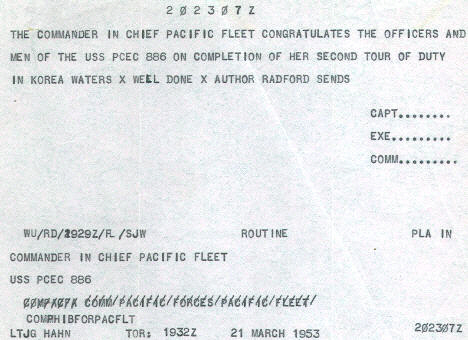
19 February 1954 -- Completed Air Control School and Combat Information School ,
Combat Information Center, First Naval District, Boston, Massachusetts, in
preparation for duty as Operations Officer in the USS BENNER (DDR-807)
1 March 1954 -- Resigned at the
First Naval District Boston, Massachusetts.
Net Naval Service 3 years, 7 months, 25 days, other service 5 years 9 months,
8 days, total net service 9 years, 5 months, 3 days, sea service 2 years 6
months. Separation from the Armed Forces (DD-214) and Honorable
Discharge as a Lieutenant (junior grade), Service No. 501623 at HQ 1st
Naval District, Boston, Massachusetts, on 4 March 1954. This document also
says that I was separated from active duty on 4 March at the Headquarters,
First Naval District, 495 Summer Street, Boston, Massachusetts. My Permanent
Address was 1120 High Avenue, Topeka, Shawnee County, Kansas.
2 March 1954 --
Accepted a Naval Reserve commission as a Lieutenant (Junior Grade) in the
Potomac River Naval Command (Washington, District of Columbia) and joined the
Naval Reserve Security Group Command, Washington, District of
Columbia, at the Naval Security Station on Nebraska Avenue, in a line officer (1100) billet. Promoted to Lieutenant Senior Grade (O-3).
1955 Summer, Reserve Cruise to Cuba in
Destroyer Escort USS Robert F. Keller (DE-419).

USS Keller at Sea 1954-1955
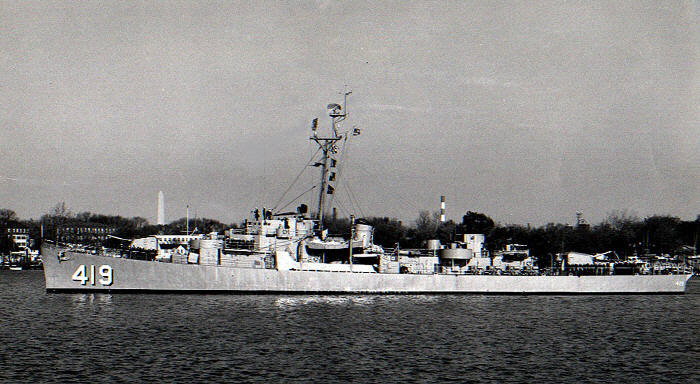
Destroyer Escort USS ROBERT F. KELLER (DE-419) at Washington, District of Columbia 1954-1955
Class: John C. Butler Type: WGT (geared-turbine drive, 5" guns). Displacement: 1,350/1745 tons Dimensions: 306' (oa) x 36' 10" x 13'4" (max). Armament: 2-5"/38, 4 (2x2) 40mmAA, 10-20mm AA, 3-21" TT, 1 Hedgehog, 8 DCT's, 2 DC tracks
Machinery: 2 boilers, 2 geared turbine engines, 12,000 shp, 2 screws. Speed: 24 knots Range: 6000 nm@12 knots Crew: 14 officers, 201 enlisted. Operational and Building Data. Laid down by Brown Shipbuilding, Houston TX on 12 January 1944. Launched 19 February 1944, Commissioned 17 June 1944. Decommissioned 24 April 1946. Status changed to "in service", assigned to Naval Reserve Training, 13th Naval District at Puget Sound WA, September 1946. Status changed to "in commission, in reserve", assigned to NRT, Potomac River Naval Command at Washington DC, 31 March 1950 Recommissioned 18 November 1950 (Naval Reserve Training). Decommissioned 21 September 1959 and placed "in service" as NRT ship, 5th Naval District at Baltimore MD. Recommissioned 2 October 1961 for Berlin Crisis, Decommissioned 1 August 1962 and placed back "in service" as NRT ship, 5th Naval District at Baltimore MD Final Decommissioning January 1965, Stricken 1 July 1972.
Lieutenant Senior Grade Tom Hahn, USS Robert F. Keller (DE419, Officer-of-the Deck, off Cuba. (Thomas Hahn Collection)From a Navy Newspaper/Newsletter: NAVY INFILTRATES "ALLIES"
Among the Navy Reservists aboard DesDiv-121, two work as civilians with other services. . . LT Thomas F. Hahn, of Falls Church, Va., is a military intelligence specialist with the Army Signal Corps. They've tried to get both of us to switch over to their services, but no soap."
1955 -- Reserve Cruise to Puerto Rico in USS KELLER (DE-419)
1956 -- Summer Selected as the Outstanding Officer Reservist, Potomac River Naval Command and 5th Naval District and awarded a Reserve Cruise in the Mediterranean in the Destroyer USS SOLEY (DD-101), a week in Rome, and a week on the Riviera at Cannes, France.
September 1956 -- Ordered to Active Duty as a Lieutenant , United States Naval Reserve, from the Potomac River Naval Command.
1956-1957 -- Student in the Mandarin and Cantonese Chinese Language Program of the Institute of Far Eastern Languages Yale University, New Haven, Connecticut. Diploma. Also tutored in Japanese.
1957-1959 -- United States Taiwan Defense Command, Taipei, Republic of China, Special Projects Officer/Naval Research Analyst Officer/Special Intelligence Officer.
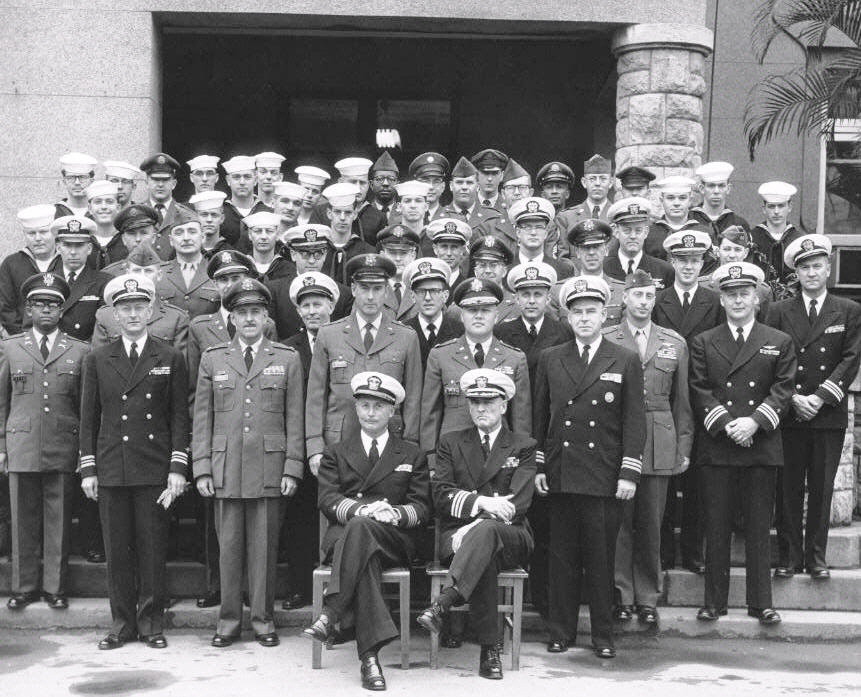
Intelligence Staff for United States Taiwan Defense Command, Taipei, Republic of
China. LT Tom Hahn third row center. Head of Command Intelligence, Captain Hahn
no family relationship to Tom), front row, left. (Thomas Hahn Collection)
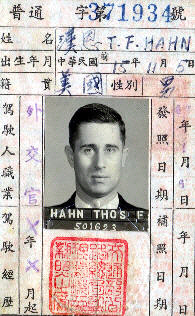
Republic of China Ministry of National Defense Identification
1959 -- Promoted to Lieutenant Commander. (0-4)
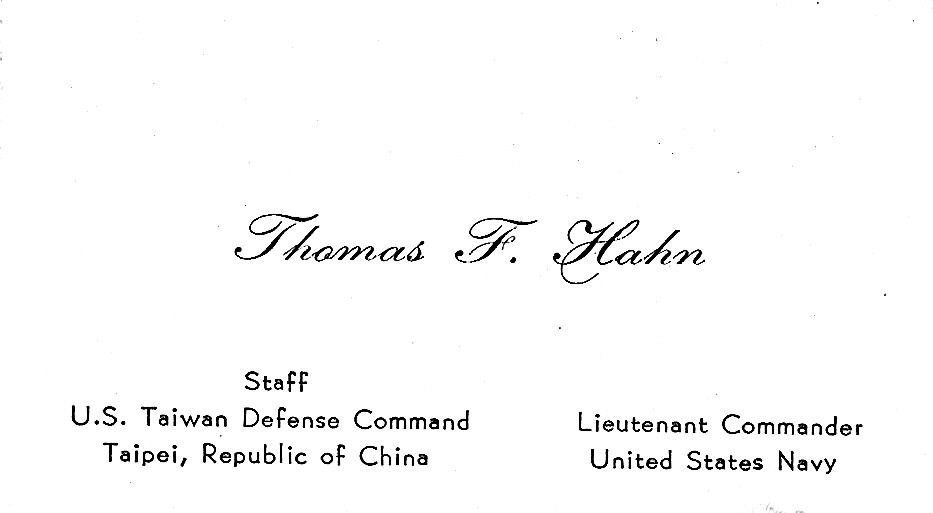
Official Naval Calling Card
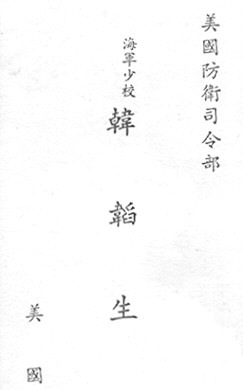
Reverse Calling Official Calling Card in Mandarin
1959 -- Selected for Special Duty Only (Cryptology, 1615).
1959-1962 --
Special Projects Officer/ Special Intelligence
Officer, Far East Area, National Security Agency,
Fort Meade, Maryland;
Alternate Member for NSA
on the Unites States Intelligence Board (USIB) Committee of Overhead
Reconnaissance (COMOR)
24 February 1961 - - Commendation from the Central Intelligence Agency
19 October 1962 --
Commendation from the Central Intelligence
Agency
1963-1964 -- Assistant Head/Head, Naval Security Group (USN-14), United States
Naval Communications Station, Wahiawa, Oahu. Net Control Officer for the
Pacific Area.
Wahiawa Shipmates heard from, from this
tour, and who have contributed to this section:
Dow and Debbie Berggren of Bethesda, Maryland
John Gidusko
1961-1964 JGidusko@cfl.rr.com
Orville Hinz Ohinz@aol.com
Art Namoski
skiandnina@starpower,net

( From www.bestofhawaii.com )
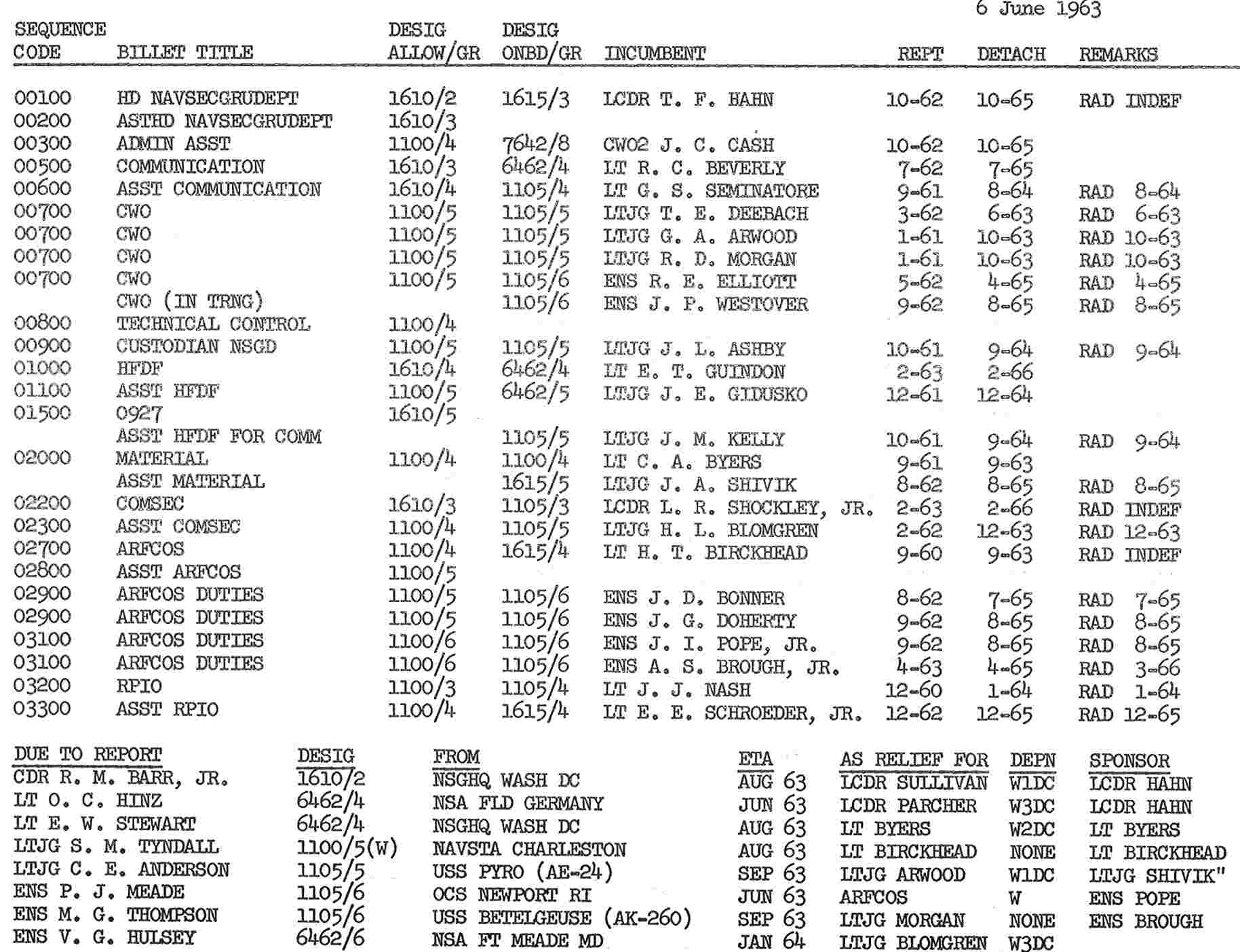
After the demanding tour at the National Security Agency in the Special Projects Office (1959-1962), the tour in Hawaii almost seemed like a vacation. Somehow I learned that passenger ships carrying the national flag reserved some limited space for military travel. I thought, "What the heck," and applied for it and was pleased to see that I managed to get a great cabin for my family and myself with the Matson Line in the SS LURILINE, I believe it was. An amusing incident happened on our arrival. Though the name Hahn is German (meaning "The Rooster,") with the same pronunciation it is also common as a Chinese or Korean name. In Chinese, "Han Ren" means a Chinese person. So, at the dock there was a Korean Family from the station named Hahn. The family head was "Duck Han." [I hope that I am remembering correctly that this happened in Hawaii and not in the Philippines.] The reception at the dock was with the traditional leis and all.
My sponsor, whose name I do not remember, kindly found us a nice house at the north end of the island, at Kawailoa Beach. It was probably only about 15-20 miles from the station at Wahiawa. The commute was very pleasant as it passed through sugar cane and fields and had very little traffic. The weather was perfect throughout the year and especially so at the beach. A famous beach, four or five miles to the northeast, was well known for its surfing and often depicted in movies at the time. I don't remember whether housing was available or not at that time on the station. Perhaps my department head preferred that I not live in the same place where he did. In any event, the location was very nice. Just down the beach a famous Vietnamese movie star had a house. I will have to look up her name, but it may have been Ngu something. One day, when I was not home, she was seen walking nude along the beach. Somehow, I seemed to miss a lot of good stuff in my life.
We had an interesting family next door. He worked as a salesman in a shoe store but was a part-time minister of the Gospel as well. Theirs was a very strict religion but I can't remember which. As an example, she told my wife that they bathed their two little children with their clothes on. (I certainly hope that they didn't see the Vietnamese movie star when she walked by!) One day, after the husband went to work, the wife was on her way to reach outside the kitchen door to get the milk that she thought that the delivery man had left as she didn't want it to spoil in the sun. For some reason, perhaps having stepped out of the shower or for whatever reason, she had no clothes on. Just as she got to the door, the milkman came up to te steps and startled her. The woman jumped in the broom closet next to the door, when to her utter surprise, the closet door was opened--by her husband, who saw his wife standing there naked. "Embarrassment, she said, " Oh, I thought it was the milkman." It seems that he kept a briefcase in the closet but had forgotten it and went back to the house to pick it up. This is a true story and seems even funnier when you consider how conservative the couple were.
One neighbors next door were Japanese-American and a neighbor a couple of doors down was native Hawaiian. I don't think Betsy was old enough to be in school in that tour. Chris went to high school, or a combination of junior high and high school at Haleiwa, but I will have to check within him on that. In any event, they were both exposed to all sorts of people with all sorts of backgrounds, as they had been in the Republic of China earlier. and I think those and other experiences in the military helped them become the tolerant, fair-minded people that they are.
[Chris Hahn commented on the above in part by saying--and I
have added my comments to his:
The famous surfing area was Waimea Bay to the north of Wailua where we lived. [Tom: We actually lived at Kawailoa Beach. Between us and the road to Haleiwa--Route 83--was an abandoned World War II auxiliary airstrip.]
The fire department had surfboards on the truck for rescues. The surf at Waimea Bay would not even break until the swells were 20 or so feet, and I believe the highest waves there, and surfed! were on the order of 45 feet or so. There are pictures of surfers there, the waves actually look like they are 100 feet high because the surfer looks so small. The waves would sometimes form a pipeline and surfers would disappear in one on the face. It is some of the largest surf in the world.
[Tom: One day while at that beach or passing there, there had been a drowning, so I took Chris and Betsy over to the body that there were working on to impress them of the danger of the waves--not to be taken lightly! The first time I tried snorkeling in the water off our beach I was slammed to the ocean floor and decided that that kind of sport was not for me. When I was young I was always in the water, but after four water incidents, three involving rescues, I not longer had that pleasure of being active in the water. One was at Blue Beach at Beaulieu near Villefranche, France (spelling?); one was at Kobe, Japan; and the other at a beach in northern Taiwan. Other tales for other days.]The Luriline was a great ship! On the final leg of the trip back from the Philippines, from Hawaii to Travis Air Base in California, we rode in some turboprop plane and wasn't it about a 14 hour trip? The worst flight I've ever been on.
[Tom: Maybe not that long, but it seemed so, anyway. Perhaps I have a different perspective, having crossed the Pacific Ocean and the Atlantic ocean in prop planes where each of the legs took a long time. One time later, while on TDY from NSA to Japan, when I went to get my plane for the Hawaii--Hickham Air Force Base)--to Tokyo, there were photographers and journalists taking photos as it just happened that when I came along I was the first jet passenger to make the trip! I forget the type of aircraft, but probably a military of contract version of the Boeing 707.]The school was Waialua Elementary School. Went to Haleiwa High School for part of the 7th grade maybe? before going to Philippines. Won first prize in the story telling class there. Wrote poetry about WWII submarine adventures for music class, much to the surprise, and not displeasure, of the teacher there, who encouraged me.
[Tom: As mentioned, going to school there was a good experience. As I recall, there were cocoanut palms on the school grounds. Cocoanuts went commonly for five cents each.]Wahiawa had a couple, a doctor and his wife, an Olympic gold medalist. The wife taught me to swim at the base pool, one on one, and gave the confidence to me that I needed to later do anything in the water. This may have been mom's idea, or yours? or both. I had a bad time with swim class at 4 corners elementary school in Silver Spring, just a few trips to a YMCA and mass, group instruction, no individual attention, and I couldn't swim until going to Hawaii. The husband doctor wrote a biology book, we had a copy for many years, after the divorce it was still on mom's bookshelf in Bethesda. What was his name, Holland? I think he was the station doctor maybe?
[Tom: They were an unusual couple, not your typical navy type. I don't remember the Olympic swimmer bit, but Chris would remember better than I. Their name was was Britton, Mel and Mary. One time we were having a lunch in Honolulu and she fainted at the table, but I think it was only a temporary condition. When he had served his obligatory time, they went to Dartmouth in New Hampshire, where I believe he was associated with the college. Later, when we were stationed at Winter Harbor, Maine, we went to visit there for a ski trip and stayed in a sort of small ski lodge with the beds in sort of a dormitory setup. Perhaps Chris and Betsy didn't go on that outing. I don't remembered what happened to them later. Both Chris and Betsy became excellent swimmers due to the training at Wahiawa and in the next tour at San Miguel.We had an old 40's Packard that had no reverse gear, but otherwise was a great car.
[Tom: I bought a really old 8 or 10 cylinder Packard from Bob Curtin--I think it was, but not certain-- for $200. It had really been a great car in its time. I tried to change the spark plugs one time, but they were frozen in place. It ran so smoothly that a few times I accidentally left the car running as it really purred. One problem was that it didn't have a reverse gear. Once in a while I would forget and park head-in, so a couple of guyts would have to help me push it out to where I could get going. Do you remember that car? One time I was out in the sugar cane fields fishing at a pond and got stuck because of that. The car had a cracked winged window and I was afraid it wouldn't pass inspection. Because of the reverse gear thingy, I found a garage where I could drive in and then out straight through as I was afraid it wouldn't pass. I took it the garage of my Japanese-American neighbor. He saw the crack in the window and said he would fix it, which he did by taking a sledge hammer and breaking it out. I was speechless by his solution! He said the crack wouldn't pass but there was no requirement to have a window, or to have a reverse gear. I also bought a boat and motor from Curtin and kept it at a small lake near or at Wahiawa for a while before taking it home to Kawailoa Beach. It never worked out and I eventually sold it. I never heard anything about Bob Curtin after he left.We went sports fishing a couple of times, never caught anything with me along, except, one time snagged a wooden sign, with the words "Peanut Pass" on it. One time we returned from a trip from Pearl Harbor, up the Kamehameha highway, stopped alongside the road, and watched with wonder the sight of a waterspout offshore, in a rain squall, that was lazily drinking its fill from the Pacific. It was still there when we got back in the car and continued home.
[Tom Comments: The "Peanut Pass" catch was caught on a tri sponsored by the Wailoa Fishing Club--I think that was the name. It was in contention for the tear for "The Most Unusual Catch," but lost out to a dead cow.]I had some interesting boy scouts experiences there, experiences in the troop with the army style of camping, walks in the jungle ravine and through pineapple fields, with our Navy patrol, earned my scout hiking requirement for first class by walking up to the Kameya Maya pass and back down to Schoffield Barracks. And I did lots of reading, studying WWII Navy stuff and reading sci-fi from the base library, and dreaming of islands.
[Tom comments: The Boy Scout troop was at Schofield Barracks, not far to the west from the Navy Station. Being on an Army post, a lot of the leaders and events were patterned after army-style things. I had some minor job on a troop committee as I recall. I thin this is the lace where Chris told me being on a camping and hearing the legend of the "Crap Hand.", that ghostly hand that reached up and grabbed when as you sat on the seat of he latrine. Chris will have to affirm or deny the place, and perhaps even my memory of it.One time there was a tidal wave alert, in the middle of the night, after the great Alaskan earthquake. We were evacuated from our beach home by local police and raced along the road to Haleiwa, then up the Kamehameha highway to Wahiawa where we watched the news for tracking of the possible wave. [Which never came.]
Being the second in charge or command is a hard thing to do, because you not only have to do your job right and please the boss, but be responsible for those under you. In this case, in loyalty I never said anything against my superiors to those working under me in loyalty and to try to be a buffer between them and the other person. The situation became so intolerant, that I went my the Captain in charge of the Navy Security Group for the Pacific area at Pearl Harbor. He sympathized with my situation, but wisely--as I learned better--told me that each of us would face a similar situation in our careers, and how we handled it was part of how were judged. His successor, another Naval Security Group captain, said to me at the change-of command ceremony with the officer concerned when he retired, "Now is the time to tell him off if you wanted to." I approached him with that in mind, then when the time came for me to do so I realized that by not saying anything made me a better, and satisfied, person.
A one-time Naval Security Department Head at Wahiawa was noted for his demanding ways. As an example, first thing each morning his yeoman, Chief Art Namoski (or Chief Buzz Clark brought him a cup of coffee and he invariably complained that the cup was not clean enough. This became boring, so at some point he took the cup to the head and cleaned it out in the urinal. (I won't get too specific here.) On inspection of the coffee cup, the officer in question said, "Chief Namoski, that is the way a coffee cup should gleam." [Once again I am corrected oh how I remember things and how others remember them. When I sent the anecdote to Art Namoski, He replied, "Here's the straight scoop on the coffee cup caper. On that particular morning the demanding LCDR called me into his office and wanted to know where his coffee cup was. I told him I would check it out and take care of the problem. When I went into the head, my seaman striker was bent over the toilet swishing something around. When I asked what he was doing, he turned around and said "nothing." I asked him to show me what he had behind his back and he showed me the coffee cup. I asked him if this is the way he always washes the cup. He said "Yes, Chief, are you going to put me on report?" I told him "No, you are following orders to wash out the coffee cup."]
During this tour the Navy ordered--to the best of my knowledge--the first African-American sailor to the department. As the assistant Department Head. I took the sailor into meet the Department Head. As usual. the latter didn't ask us to sit during the conversation but stand almost at attention in front of his desk. In his inimitable way, the Department Head put the sailor at ease by asking, "Are you a Negro?" The somewhat bewildered sailor answered, "I think I am. My father is a Negro and my mother is a Negro." The poor fellow was probably already sensitive enough about being the only one of his race assigned. I could have dropped through the floor in shame and embarrassment.
(John Gidusko mentioned that it was a real gasser the department head charged 50
cents for calling a Chief a Chief instead of a Chief Petty Officer, I guess. I
was once talking to several "Chief" and he chewed me out for calling them
"Gents" as that word was reserved for officers.) I don't really know what
his problem was. A mustang (an enlisted man who has gone through the ranks) and
had the technical skills, but he lacked something that made him a good leader.
Sort of like the Captain in the film Mr. Roberts" or in "The Caine Court
Martial." When his desk was cleaned out, the only thing that was found a new
commander's hat, so perhaps he was disappointed as he didn't reach his goal in
life. I found at many years later that he had committed suicide and I felt very
sorry for him and his family.
We all had our little escapades as life was pretty laid back in Hawaii and
in the service at this time. John Gidusko recalled that " One evening Bob Curtin
... [got this wild idea] and we went out to the Barber's Point NAS BEACH... and
he set his chord organ right there on the sand, ran about a 200' extension cord
to the rest room there... and we'd play music on the beach. Yeah, I know,
weird!!! We weren't that good, we were still learning, I don't know why Dick
Kirby put up with us." Dick Kirby was an RCA tech rep, that is, technical
representative.
During my tour, the Naval Security Group ordered WAVES to the department. Because there had not
been WAVES there before, toilet facilities had to be innovated for them. It just
so happened that there was a broom closet across from my office. Because the
walls were glass on two sides, I could see everything that went on in the
passageways in that area. The tiny broom closet was converted into the WAVE
officer's head. There was only one WAVE officer at that time. It was only large
enough for a stool and a small sink. The sitter sat facing the door, which was
about six inches from her feet. I heard voices in the passageway and looked up
and saw two seam outside this head. The seaman who was in charge (apparently)
said to the other seaman. "This here is the ladies' head. If the door is closed,
knock three times. If there is no answer knock three times again And, just to be
on the safe side, knock three times to be on the safe side." So, the trainee did
just that and then pulled open the door and there facing him sat LT _____ . I
don't know who was more surprised and never learned why she didn't call out that
the head was in usual.
I almost got in trouble because of this same WAVE officer. As often happened, many officers stopped by the Officer's Club for a drink or two before heading home. One particular night I stayed a bit longer than usual. After drinking, I thought that this officer should not drive home by herself, so I drove her to Pearl Harbor where was lived, and then had to drive back home to the opposite north end of the island of Oahu where we lived at Kawailoa Beach. In trying to find her quarters I inadvertently went through a stop sign and was given a ticket by a Pearl Harbor policeman. It just happened at that time that the newspaper printed all the arrests made and that column was a column of popular reading. For several days I sweated someone reading my name. It was all done on my part as a gesture to help a fellow officer and someone under my command, but that could have been hard to explain! In those days it was much more common among service people--and probably others--after drinking, than it is now for most people.
One of the things I particularly enjoyed was the fishing and hunting. While there, I served as the President of the Honolulu Road and Gun Club, so had a chance to be in on some some good fishing trips and hunts. One benefit was to arrange fishing trips of the Boat Islander, owned and operated by Captain Bill Dotson and to have Special Services of the station pick up most of the expense. The boat operated put of Pearl Harbor as I recall. Go to Tom Hahn Family, Interest and Hobbies (Part 7), Hunting to see some photos of hunting on the Island of Hawaii. [More later]
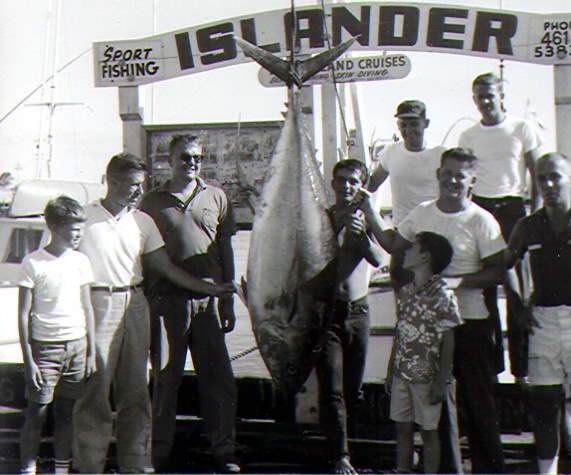
The best catch we had on the Islander was this Allison (yellow fin) tuna caught by Chief Art
Namoski. It is called an ahi in Hawaiian The fish put up a big battle and nearly wore Art down. The fish weighed about
224 pounds. Art commented in an email that the
captain said if he knew that it was near a record fish, he would have stuffed in
put a few weights to get the necessary poundage. Those identified so far,
left-to-right: Chris Hahn, Tom Hahn, Orville Hinz, a mate on the boat,
unidentified man with cap,
maybe
Seaman Sonny Eanes next to him, Art Namoski with his son, Mike, an, to Art's
right, an unidentified man. Captain Bill Dotson probably took the photo.
Our Japanese-American cleaning lady came over to the house one night where we
had invited some people and made sashimi out of a portion of the of the yellow
fin tuna. (Provided by Art Namoski)

Tom with catch from a fishing trip in the Islander in about 1963. The first and
second fish were mine, the first a mahi-mahi (dolphin) and the second an ono
(kingfish).
After one of these fishing trips I put the fish in the station freezer. The
electricity went off there and no one bothered to tell me so the fish was/were
spoiled and that was a darn shame.
(Provided by Art Namoski)
The only overnight trip I took in the Islander turned out to be a bit different than we had intended when we took the station dent, Russ Corio. After we had got out a ways, Russ complained of seasickness and finally begged us to take him back, so we did, rather grudingingly, of course. We probably should have been more sympathetic as it could have happened to anyone of us. He e looked pretty sad there on the dock with his head on his arms waiting for his wife to pick him up.When I mentioned this to Orville Hinz, Orville said that Russ lives in Rockville, Maryland. "Went on a Caribbean cruise last fall with them. the Larry Donovans, and the Leo Pecks, We were concerned that Russ might get very seasick and "demand" that the cruise ship return to port. But he didn't and we had a good cruise. We still kid him about his aborted Hawaii fishing trip." Seasickness can be a very serious illness. When I was in the USS GLADIATOR(AM-319), the recalled lieutenant who was the Executive Officer had such a problem that he was transferred off the ship to other duty
We only caught one kind of fish on this trip, opaka-paka, I think was the name. About 300 of them. Bill Dotson sold them when he got in but I can't remember whether or not we got a share. I sort of doubt it. Maybe the captain's privilege. Out of boredom, Dotson' helper, that same kid as in the yellow fin tuna next to you in the second photo above with the bare feet, out of boredom was fishing with a little rod and reel when I shark took the bait and pulled the rod right out of his hand. Dotson may not have been looking or around right then as he might not have let him mess around. I just don't remember who was on that boat. I can't remember whether Chris was with me, but I think not.
John Gidusko recalled that we played a lot of Ping Pong at the O Club,
Remember the ping-pong games that we did at noon at the O Club? Seems to me you had a wicked slam, if I remember correctly. I do remember Ron Morgan was a whiz at it. He and I really were competition for each other! And in case you do remember him, his email is:
Ron Morgan golfer@gulftel.com and is living in Foley, Alabama.
Tom comments" "We did indeed play a lot of ping pong, I think I began my tour on the first day at the station. There was a ping pong contest and I was invited to join. My recollection is that I and someone else our Department Head and his partner. The former prided himself at being good at ping ping and apparently didn't take kindly to being beat by a subordinate. Never mind that we were both the same rank (lieutenant commanders) and that in sports rank meant nothing and was put aside. Probably a tactical error on my part. So be it! Perhaps John remembers that event better than I and can comment on it.
1964 -- Promoted to Commander.
Off with the Old! Tom Hahn at promotion to Commander at the Naval Communications Station, Wahiawa, Oahu, Hawaii in 1963 (Thomas Hahn Collection)
Tom Hahn receiving new insignia from the Commanding Officer at the Nay Communications Station at Wahiawa, Oahu, Hawaii (US Navy Photograph)
1964-1966 -- Naval Security Group, United States Naval Communication Station, San
Miguel, Zambales Province, Republic of the Philippines. Head of
Naval
Security Group Elements in Southeast Asia and Project Officer and a
Technical Observer (non-crew member) for BIG LOOK, Danang, Republic of South Vietnam. Liaison Officer with the Governor
of Zambales Province. Adopted as a Son of Zambales Province.

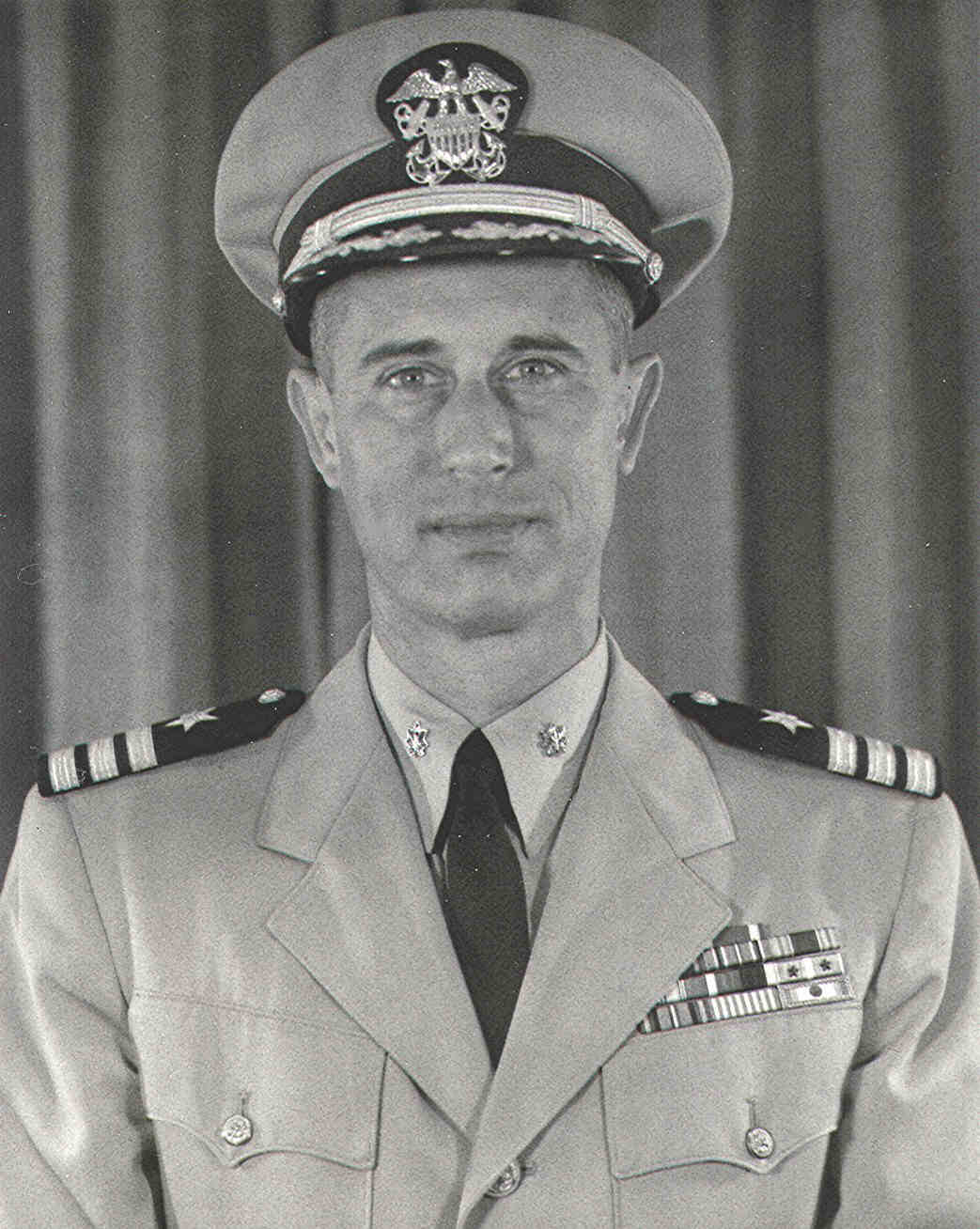
Tom Hahn as Head of the Naval Security Group at San Miguel (US Navy Photo)
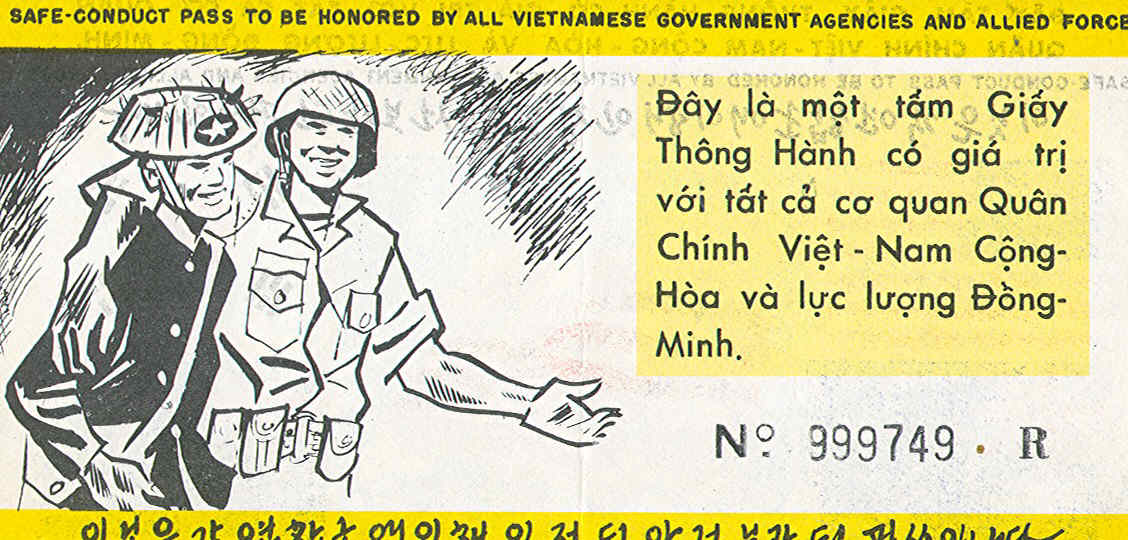
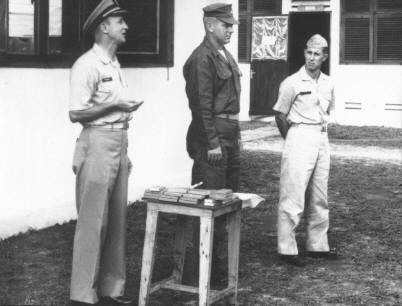

Detachment Alpha, Navy Communications Station, Philippines, at Phubai, Republic
of Vietnam. Captain Frank M. Romanick (left), Commanding Officer, Naval
Communications Station Philippines Presenting awards to the Officer-in-Charge
Center), Members of the Detachment, Commander Thomas F. Hahn (right), Head of
the Naval Security Group Department Naval Security Group Department. (Hahn
Collection)
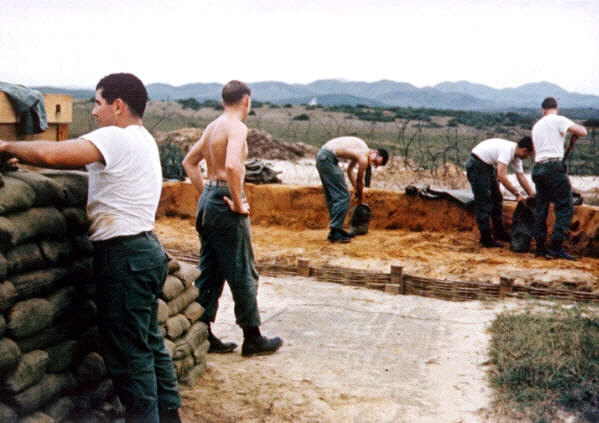
Marines preparing the defenses of Detachment Alpha, Naval Security Group, Naval Communications Station, at Phubai, Republic of the Philippines in 1964. CDR Tom Hahn (Head of the Navy Security Group at the Navy Communications Station and LCDR Ted Tettelbach (Operations Officer of the Navy Security Group at San Miguel) in August 1964 flew to Phubai via Saigon and Pleiku to help establish Detachment Alpha. There was some urgency to our getting to Phubai in a timely fashion because we had certain classified material that was necessary to start operations. We had difficulty in obtaining air transportation. Because of the sensitivity of our mission in Southeast Asia, we were restricted in the type of aircraft that we could use and were not supposed to use helicopters. The plane we took to Pleiku enroute Phubai was a two-engine Beechcraft. Along the way it developed a problem with one engine while we were over hostile territory. It seemed possible that we might not make the runway at Pleiku, so my recollection is that I--generously--took half of the sensitive documents and Ted took the other half and we were prepared to try to eat them when the engine made a miraculous recovery and we made it to the end of the runway. Ted might remember it differently. It seems to me that there was a question of whether we should have taken the aircraft that we did for security reasons. Ted says there was a second aircraft carrying General Westmoreland and that our aircraft carried five. I will ask him to clarify some of this. We spent a minimum amount of time at Pleiku. I don't know whether we went there for some purpose, or whether it was just the nearest airfield to try to reach when we developed the engine trouble. My only material memory was a primitive set of bows and arrows of the native people there, long since given away. The only other time I had some difficulty in-country on non-operational air transportation was when I decided to to take a helicopter out of Phubai because it was the only means of getting out of there at that time. We were on the way to either Hue or Danang, I don't remember which. I was napping and the doors were open, as I recall. I woke up abruptly to the sound of machinegun fire from the ground which we avoided, and again I thanked my Lucky Stars! On another occasion, I was in a helicopter (it was OK to use them in the R. P.)when we got lost in the fog on the way over the mountains on the way to Clark AFB.
Danang was one of the busiest military areas in Southeast Asia in the Vietnam War. Our detachment from San Miguel was housed and flew with the Danang Detachment of Reconnaissance Squadron One out of Japan. The aircraft used at that time was the electronically-configured Constellation (EC-121). This aircraft carried a crew of about 32, as I recall.
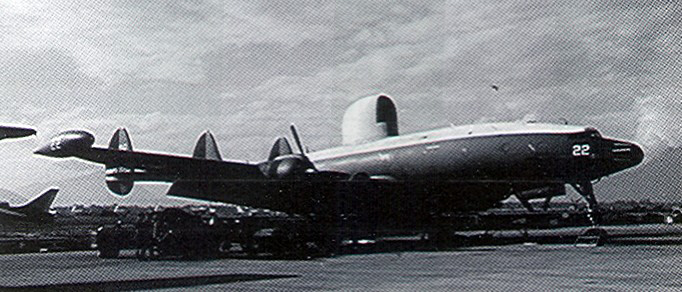
EC-121 Super Constellation Reconnaissance Aircraft (Photo courtesy
Airell Jenks)
As written in an article entitled "A Dangerous Business: US Nava Group Operations," in the Spring 2006 Issue of NCVA Cryptolog, p.12, intelligence recon missions of this nature are not always routine, as is evidenced from a couple of examples;
... "a couple of yeas later, [1968], a VQ1 EC-122IM flying from Atsugi to Danang crashed at Danang with a feathered, burned out engine, resulting in numerous killed and injured crewmen. In July of 1966, I was on a VQ Big Look mission at the northern end of our dogleg track in the Tonkin Gulf when two NVNAF MIGs streaked on an intercept course with us. We aborted tye mission immediately diving to sea level. while two of our escorting Navy F4B Phantoms flew to intercept, followed by the other two which had been refueling. The MIGs went home, no easy prey that day. But in April of 1869. a similar VQ1 flight with an NSG detachment aboard was attacked by NKAF MIGs mo miles off the east coast of Korea over the Sea of Japan. The MIGs fired ATOLL heat seeking missiles at the Willy Victor, shooting down the plane with all 31 crewmembers killed. Despite North Korea's obvious hostile posture, having seized the USS PUEBLO (AGER-2) in January of 1968, inexplicably no fighter escort had been provided.
Conditions at Danang were not quite so primitive as they were many other places in Vietnam, but anyplace in a war zone can be dangerous. There was a mortar attack one night. On day I was sitting on a rubber doughnut, a big-bladder-like container for aviation fuel. I heard a plop and saw noticed a spurt of fluid (gas) three-or four inches high coming out of the doughnut near me. Apparently an errant rifle shot from somewhere off the base had hit it. The planes carrying Agent Orange--not the ones we flew in--were nasty things to be around. All At the time we tended to take things like that rather casually and probably didn't know the long-lasting effect that they would have later. I filed a report or form with the Veterans Administration a few years ago reporting the exposure to Agent Orange just for the record. Over four years ago I was diagnosed with idiopathic pulmonary fibrosis. Agent Orange is a possible contributor. Another factor was histoplasmosis from swimming in the streams of Kansas in the 1930s as discovered by a navy doctor during a physical many years ago. A third possible factor was being dumped on by a C-47 mosquito control plane a week or so after 9-11 in Fort Myers.
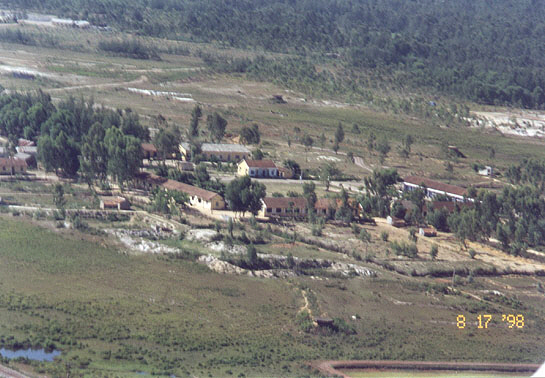
Aerial View of Phubai, Vietnam, as it was in 1998
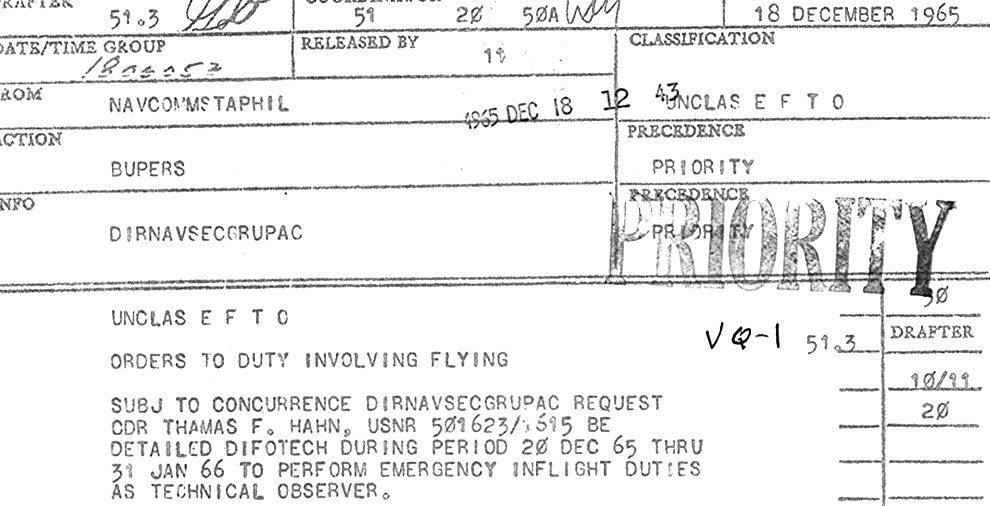
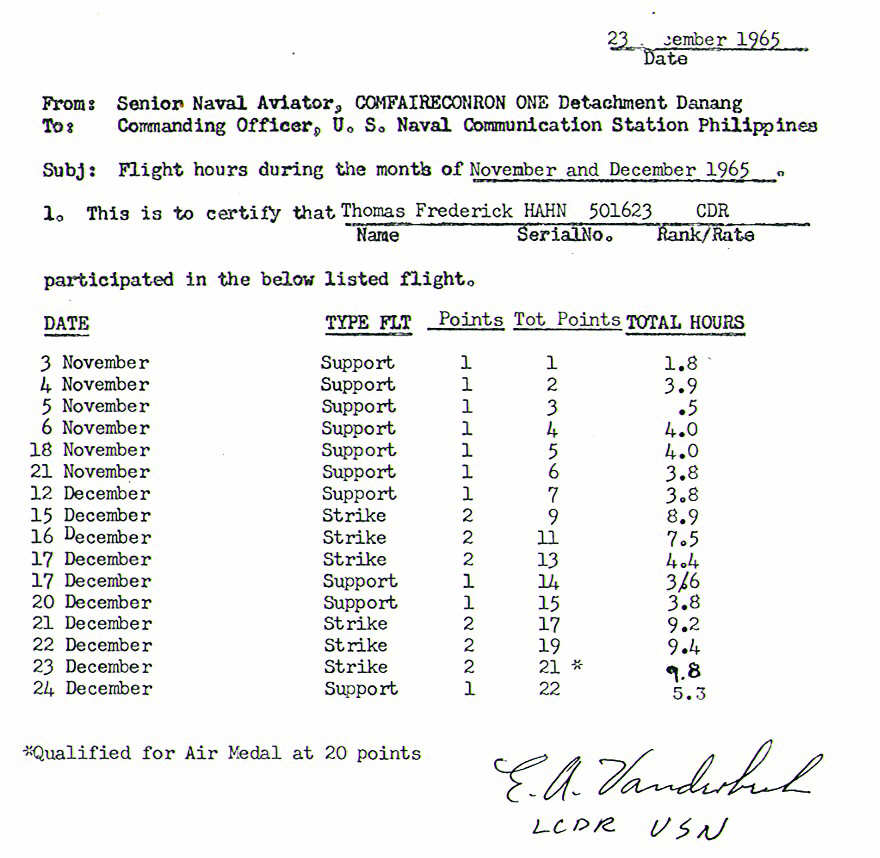
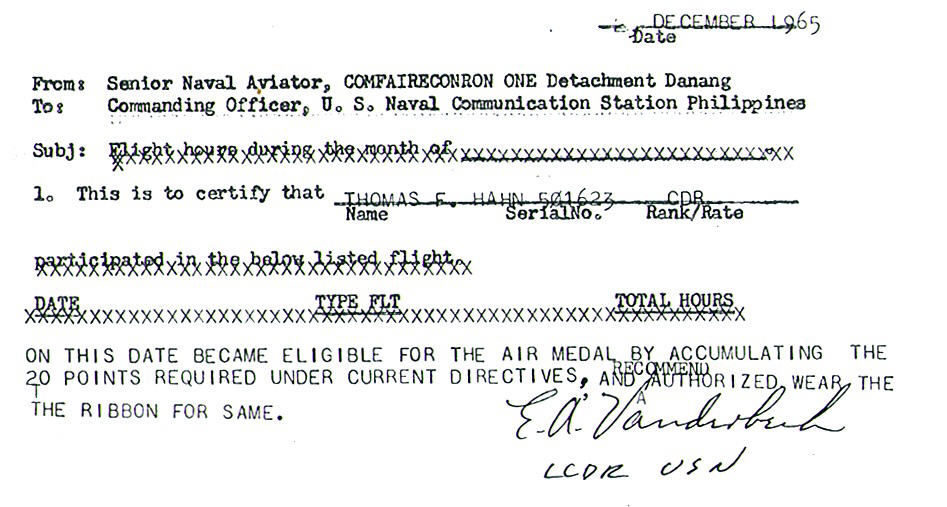
Danang was one of the busiest military areas in Southeast Asia in the Vietnam War. Our detachment from San Miguel was housed and flew with the Danang Detachment of Reconnaissance Squadron One out of Japan. The aircraft used at that time was the electronically-configured Constellation (EC-121). This aircraft carried a crew of about 32, as I recall. On occasion I went along as a Communication Liaison Officer. I was the BIG Look Project Officer for NSG in our area. Conditions at Danang were not quite so primitive as they were many other places in Vietnam, but anyplace in a war zone can be dangerous. There was a mortar attack one night. On day I was sitting on a rubber doughnut, a big-bladder-like container for aviation fuel. I heard a plop and saw noticed a spurt of fluid (gas) three-our four inches high coming out of the doughnut near me. Apparently an errant rifle shot from somewhere off the base had hit it. The planes carrying Agent Orange--not the ones we flew in--were nasty things to be around. All At the time we tended to take things like that rather casually and probably didn't know the long-lasting effect that they would have later. I filed a report or form with the Veterans Administration a few years ago reporting the exposure to Agent Orange just for the record. Over four years ago I was diagnosed with idiopathic pulmonary fibrosis. Agent Orange is a possible contributor. Another factor was histoplasmosis from swimming in the streams of Kansas in the 1930s as discovered by a navy doctor during a physical many years ago. A third possible factor was being dumped on by a C-47 mosquito control plane a week or so after 9-11 in Fort Myers. So, folks, take care of your environment or it can turn on you!
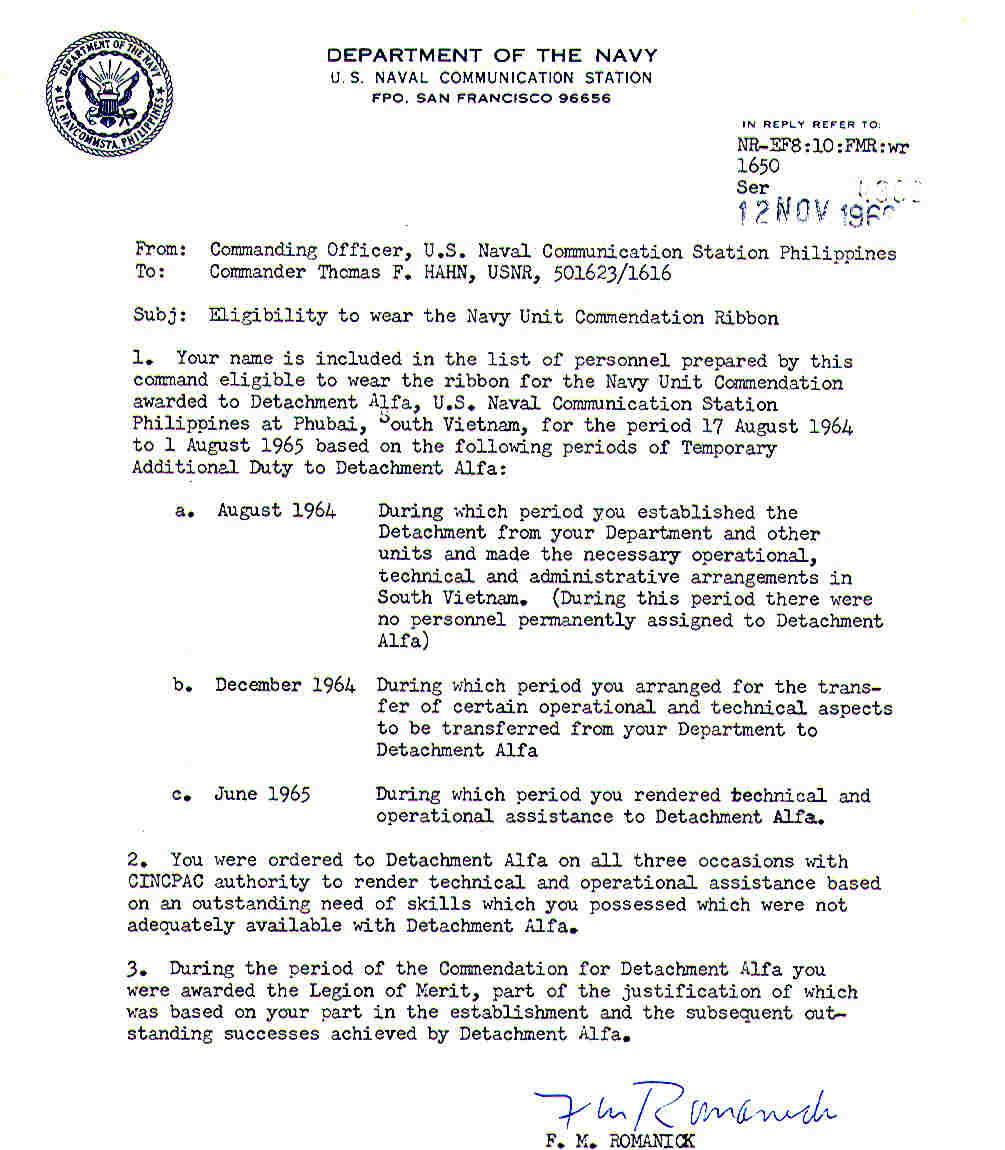
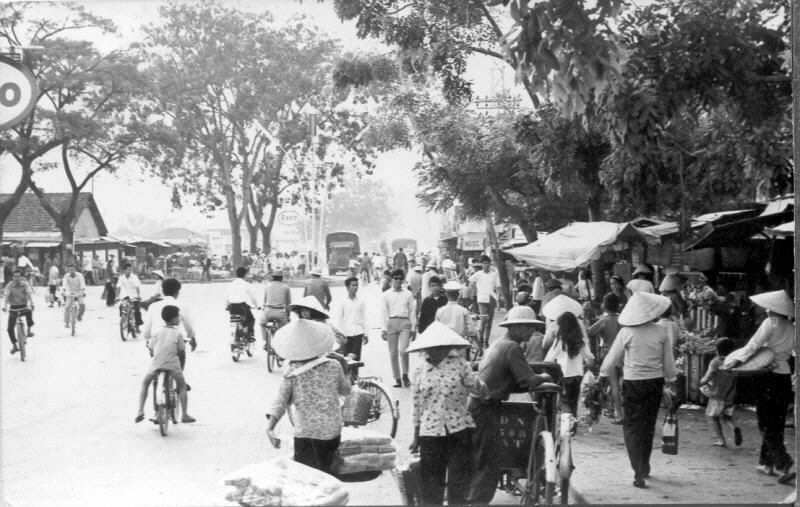
Danang, South Vietnam

Officers Club, Naval Communications Station, Zambales Province, Republic of the Philippines, ca.1965. Although we were in the middle of the Vietnam War, there was still time for relaxation on the "O" Club. At one period, I sometimes flew to Danang, Vietnam on a Sunday afternoon to go on reconnaissance missions against North Vietnam and China and then return back to Zambales Province later in the week in time to go to the Officers Club on Friday Night. Left, Paul Fuquay on the clarinet and Tom Hahn. Need some help identifying te others. (Hahn Collection)
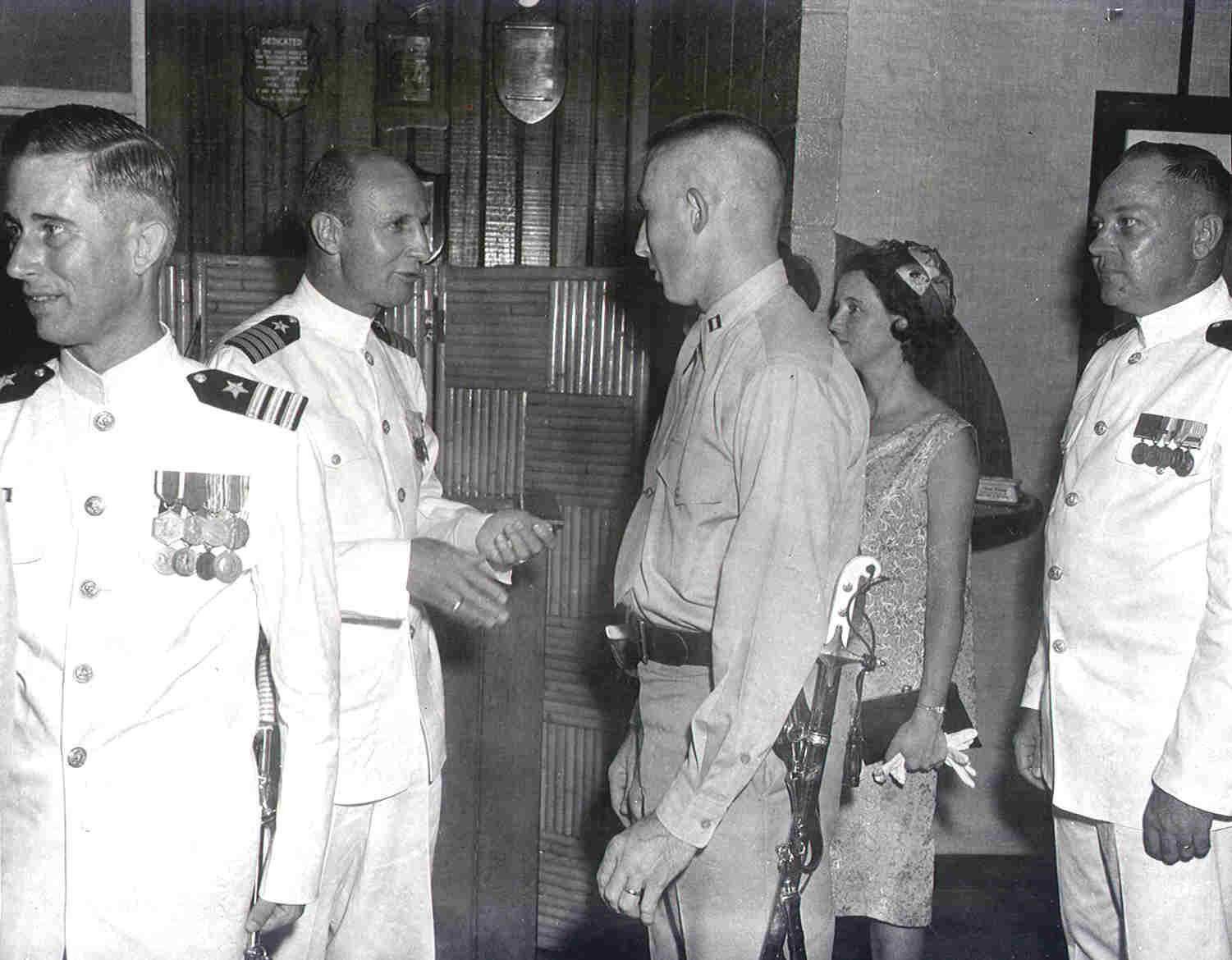
Official Navy Function at the San Miguel Officers-Open Mess. There were
always official naval and military functions, even in the middle of a war. (CDR
Tom Hahn, CAPT Frank Romanick, unidentified Marine Lieutenant, Lt Paul and Mary
Fuquay? (US Navy Photo)
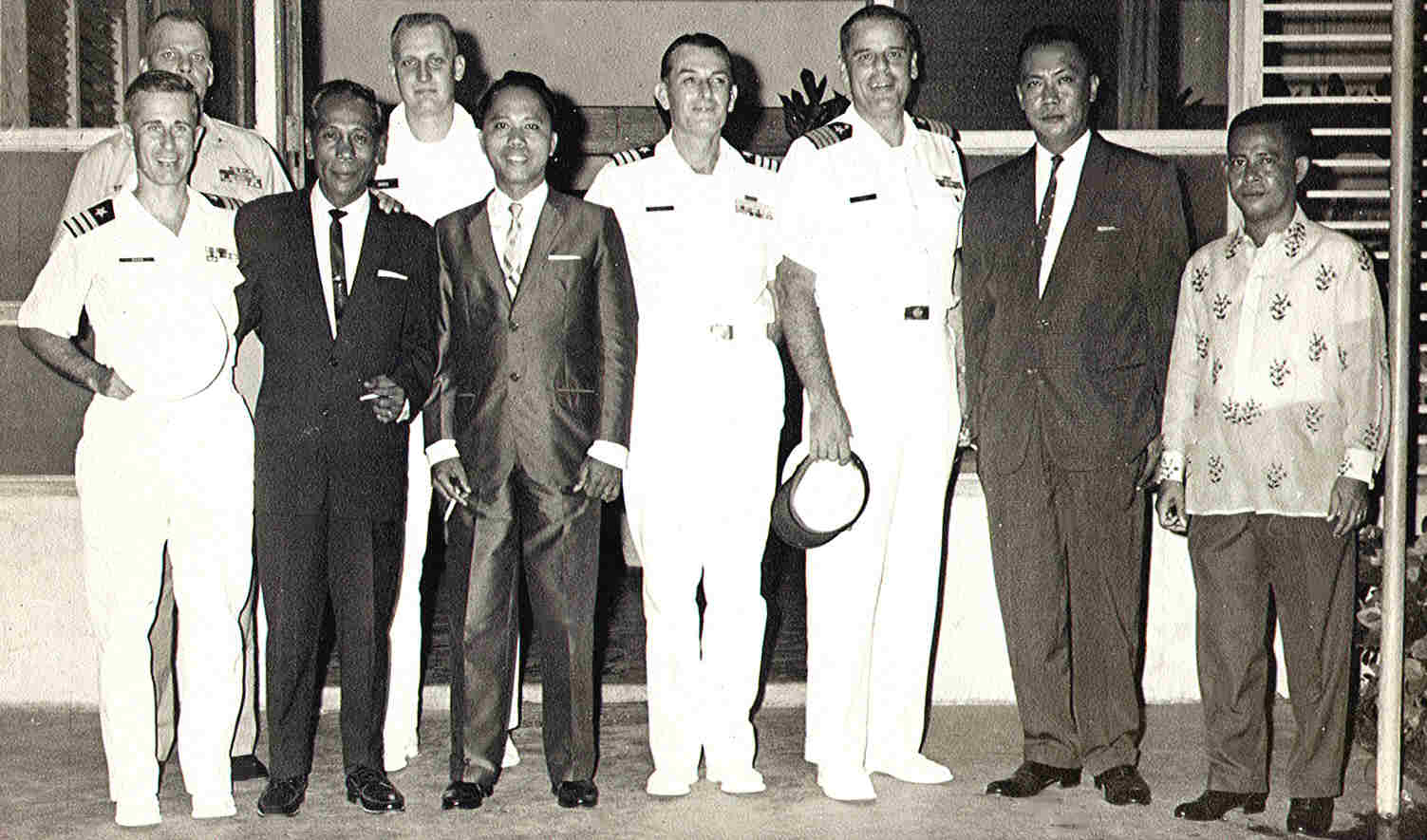
We had close relations with the people of the Zambales Province, particularly
those in the surrounding towns of San Marcelino, San Felipe, and San Narciso.
Need some help in identifying our Filipino friends. Tom Hahn on left. Captain
D. B. Gaw, Commanding Officer, third from right, and to his right, Commander
Miller ?, Executive Officer. (US Navy Photo)
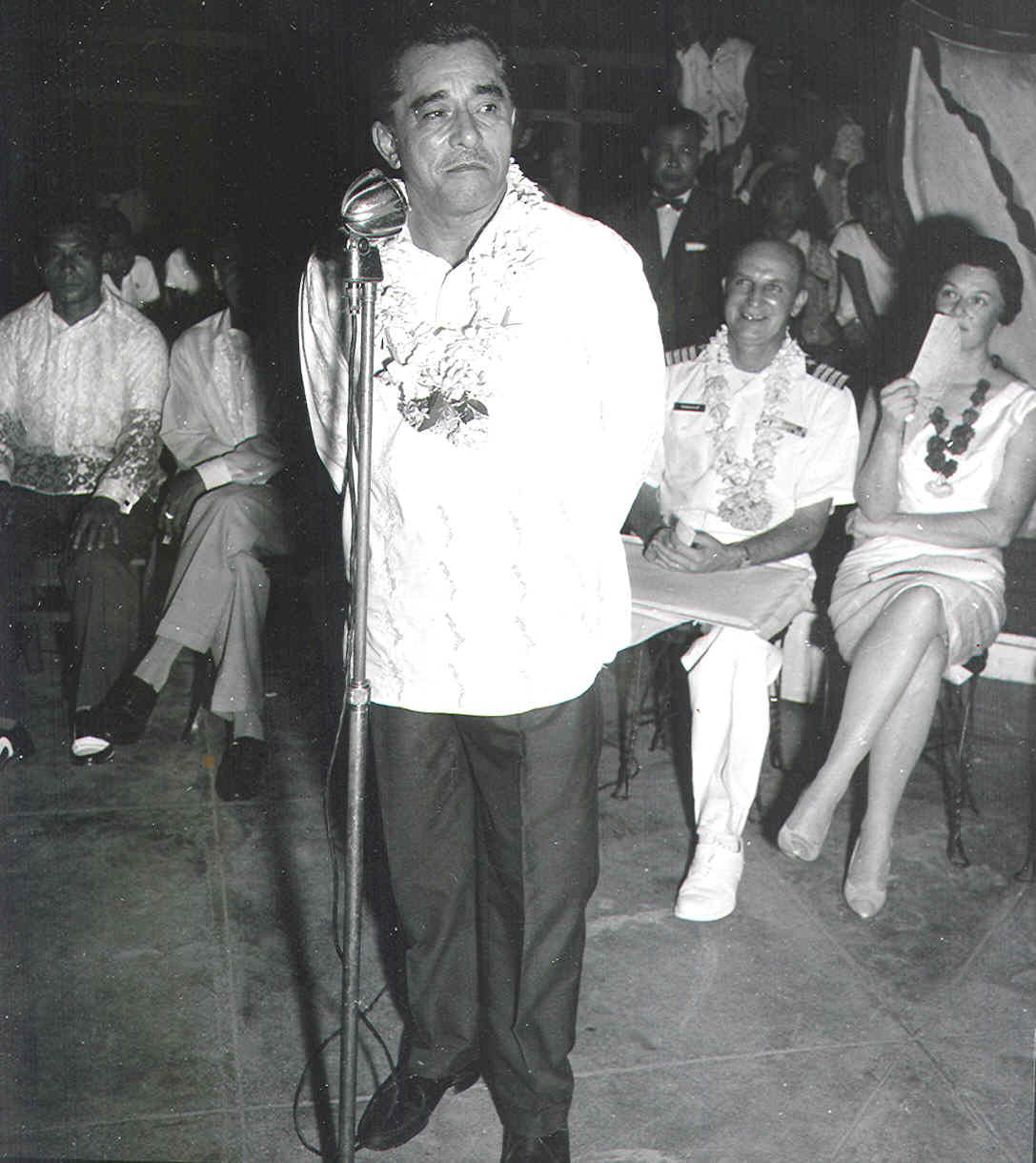
Manuel D, E. "Manoling" Barretto, Governor, Zambales Province, Republic of the
Philippines. One of my duties was being the Liaison Officer with the Governor of
our Province. We became very good friends and often went hunting in the
mountains to "Shangri-La," to other islands, to Manila, and to many official and
social occasions. His friendship and the many Filipino friends that I had made a
difficult tour in t5he middle of the Vietnam War more pleasant.
When we first arrived at San Miguel the Commanding Officer of The Naval Communications Station, Republic of the Philippines was Captain D. B. Gaw. I believe his Executive Officer was Commander Miller, succeeded later by Commander Chartier. I was the Head of the Naval Security Group (NSG). Many NSG units were a Department in a Naval Communications Station as a security cover and because in general we were specialists (Special Duty Only Cryptology) and not line officers for command of stations and navy vessels. That sometimes made it difficult, as I had units all over Southeast Asia that weren't directly under the CO of the communication station, so it made for some juggling at times. I often went to Vietnam, established a station at Phubai (Detachment Alpha) and flew a number of missions with our outfit out of Danang. All that was on on the Naval Security Group side. I don't remember doing much with the local population in Captain Gaw's tenure, but it was probabkly that operations in Southeast Asia were very hectic and not as much emphasis was placed with the local people as later. I could be wrong there and realize that I really didn't know Captain Gaw very well. But right from the beginning I did people-to-people programs and got engaged in local and area Filipino activities with his successor, Captain Frank. M. Romanick, a great people in People-to-People Programs and showing the American flag at its best. Many of them were really a bit boring after a while, such as the local "festivals" which were centered around the crowning of the local royalty of young people. We sat through all of these in sometimes hot weather. At some early point we arranged that someone would keep us supplied with a cold San Miguel beer under our seats to make it more tolerable. We just relaxed and took oft as part of our duty. I don' know that I will be able to recall all the things that we did, but I will mention them as I think of them. All these events also took us to weddings and all sorts of ceremonies and activities. Many of them brought us wonderful acquaintances and friends as well. I have always enjoyed fitting in wherever we lived and enjoyed the local people, so I did some of that on my own. Note: Captain Romanick died about 2004. I am attempting to establish contact with his daughter, Susanne. Editor
NEGRITOS 1. On my first trip up in Negrito country with Governor Barretto in the mountains I wasn't sure what to take or what to expect. Although before going on a hunting trip to Shangri-La up in the mountains, I went on a hunting expedition with the governor's family and friends. They took along a live goat. I wondered what that was for for and later found out when they hung the goat in a tree and strangled it with a bottle of beer. That was supper! I managed to go along with it, but that part was distasteful to me. There was just a different attitude toward wild things than I had. For example, it wasn't unusual at the Governor's house at ( ______ to see exotic birds strung up in a tree or bush just because someone wanted to rather see them rather than to enjoy them in the wild on their own. I don't remember taking anything to Shangri La other than my clothes and a rifle. There were several vehicles in our little convoy, one with sort of bodyguards as I think there were still a few bandits around. One of the vehicles broke down on the first trip, so we were delayed while a major problem was ingeniously repaired with wire and bits of metal. The ride was exciting, of course, as new territory always is, and we gradually climbed up into a mountainous area. Either while we were there or already built for our arrival was a large covered bamboo structure, partially walled, and I think we used cots of iron beds, I am not sure I may have taken a sleeping bag as well. On this first trip was there a Navy captain from Subic, but he and I were the only Americans. There a doctor, and various of the governor's people with rice and other supplies and sources of help for the Negritos. It soon became apparent that part of the purpose of the trip was a political one to hold the support of the Negrito people. The Filipinos in our group spoke English, and the educated ones like the governor also spoke Tagalog and a few knew Spanish. They also knew the local Zambales dialect. I took Tagalog lessons on the base and attempted to learn Ilocano at the same time. One in the mountains, I began learning Sambal or Tina Sambal as well and tried to learn all three in tandem.
I had never been exposed to Negrito people, but being partially an aboriginal person myself (Native American) I was very interested in the original people of the Philippines. They were very short, wiry people and scantily clad. Many of them had respiratory problems. It got quite cool up there in the mountains, but I am not sure whether or not that was part of the reason. They were very curious about us and friendly though a bit shy. Some more than others. There were also several to many of them standing or sitting just outside of shelter house.
As I recall, on the first night of our visit we were sitting around visiting and then the governor and the captain from Subic and a couple of the governor's group decided to play poker. The Negritos were very interested in this and became quite animated when the bets went over ten pesos. At some point, Manoling (Governor Barretto) and I got the idea to put on a little show for them, so with the cooperation of the others we elevated the states to higher and higher levels, never intending to pay off the large amounts of money that were being exchanged. The climax was that the governor owed me a million pesos and couldn't pay up, so couldn't pay up, so he put up the Province of Zambales to cover his bet. By this time the spectators were jumping up and down and the climax of the evening when I won the province from as his debt. Of course I never collected. However, I was interested in buying some land in the province, but the laws were pretty prohibitive. At one point I was attempting to buy one of the Capone Islands. I can't remember which one, so I will have to try to find them on a map to see if I can recall it.
NEGRITOS 2. On the first trip, I believe that the Governor brought along a group they called "doggers" along with their dogs. I don't remember them as being Negrito, but I could be mistaken. My impression in that they were from the lowlands of the Zambales, perhaps near where the Governor lived. They were used to flush out game. None of these involved were adverse to burning down the vegetation to do the same. It seems to me that the Negritos concentrated on small game and birds and. Most of their bows and arrows were constructed to take care of that kind of thing. Most of the arrows were made of old metal files, but for the life of me, I cannot remember where there found them\ to work with. The bows were of wood, of course, and rather small. Them bow strings were mostly of twisted vines as I recall. They were very excited about the hunts, as was I at the time. We mad quite a party with the gun hunters, the diggers, and the bow-and-arrow Negritos. We were hunting for pigs and my mind was all set for that, so on the first hunt I was separated by by someone else by a small gully and I heard a loud, rustling noise and an animal burst out across the ravine. I was all geared up for a pig when to my surprise it was a deer. I believe I have a photo of that deer and will insert it here if I can find it. The deer of Southeast Asia are different from the white-tailed deer that is the most common in the United States. I believe that my daughter Betsy has those antlers in their barn at Amherst, New Hampshire. My little collection of bows and arrows still reside, I believe, in the office of my mentor Dr. Douglas Smith at Shepherdstown, West Virginia, along with my bow and arrow from Pleiku, South Vietnam. reside. Doug is an archer and fully appreciates the origin of the weapons. After I shot it, the Negritos began to gather and to cut off small pieces of the organs of the deer--the lungs, heart, liver, etc. and cast them in different directions as was their practice in their type of worship which was a form of animism. They then made a sort soup of the digestive organs AND THEIR CONTENT from gullet to anus. Of course, that was very appealing to anyone who wasn't brought up in their ways, but I managed to partake of whatever they did in the spirit of being a part of them. I believe that the rest of the deer was consumed rather quickly as they needed the protein. There was no refrigeration and I don't recall that they had any way to preserve meat, except for salting--I think--or drying. I believe it was also in their area that there were colonies of fruit bats hanging from the trees and that we also ate them. But, again, this may have been another part of Zambales where we did this.
At one point in the first trip while we were in the shelter, an old, wizened, leathery, white-haired man showed up and caused quite a commotion. I asked the Governor who this was and it was the King of the Negritos of all the Philippines. During the Second World War, he was in charge of resistance against the Japanese invaders in the mountains and so he was also a United States Brigadier General according to the Governor. The Governor had a large wooden chest, like a sea chest, that he kept his clothes and other things in. He gave a nice khaki shirt to the King and the onlookers really thought that was neat. As I was watching this I wished that I had something nice to give hi, but practically had nothing but the clothes off my back. I also thought that I should "show the American flag" somehow and not let take the spotlight of the proceedings. I wore a khaki shirt and khaki pants, so on impulse, I took off my pants in front of everyone and gave them to the King. Typically, the King wore only a loin cloth. The Governor thought that was very enterprising. He was really a great friend. I forgot about the incident, but the next time I went up when we arrived at the villager, people shouted something as we went by. There was a Catholic priest with us this time and he knew some of the local dialect and so I asked him what they said, and he replied, "Here comes the man who not only would give the shirt off his back to the King but also gave him his trousers." As we drove along a little boy came up to me and felt the hair on my arm, and something something that translated into, "Feels like monkey!" Evolution at work, I guess. What wonderful times those were and how fortunate I was to share a part of their life.
Guns were a part of the Philippines as were machetes for protection. I have seen some pretty mean machetes and the damage that they could do. While in Viet I always carried a Colt Cobra .38 caliber, 4" barrel revolver, and sometimes in the Philippines, but seldom on base. Because the governor and I went hunting together, I either sold or gave him that revolver and a Remington 12 gauge shotgun when I left for Maine. The 1918 Winchester?/Remington rifle that had been captured by the Finns in about 1938 from the Russians that I used for deer and pigs in both Hawaii and the Philippines I took with me to Maine and used it for deer hunting there. It was pretty primitive, but I got a kick out of sing it. Sometimes the Governor would come by the house and say, Let's go hunt the four-legged deer in Manila, Tom." Although I did go to Manila with him, there was nothing of that nature that took place." He just liked to kid around.
The Negritos, probably with the encouragement of the Catholic priest and maybe the Governor, wanted to build a permanent school house. Even though they they were primitive people and lived in primitive condition with minimal exposure to the modern world, they were aware of the fact that by education their children and future generations would improve their way of living. One thing that they needed for the school house was a roof, that is, the metal and the nails to hold it in place. They had no money as they lived off the land, so I had them give me what weapons they could spare and I sold them to American servicemen, probably mostly at Sam Miguel, but perhaps other places as well. Another thing they desperately needed was warm clothing. They mostly wore loin cloths and maybe a skimpy shirt of some kind, so I got the idea of collecting clothing for them. From some place we scrounged clean 55-gallon steel drums and placed them at San Miguel and Subic and maybe Clark, and Cubi Point, but I am not sure about the latter two places. The barrels were painted and stenciled "OPERATION NEGRITO." Al Eaton and John Glasgow may have got roped into some of this, I am not sure, and probably Public Works placed and gathered up the barrels. I just don't remember the details.
When we had sufficient amount of "clothes" collected, we took them with and under the Governor's auspices, up to the Negritos. I am quite sure the Governor was there and probably organized the trip. Also, I think that the Catholic priest from San Narcisso went along. Bar in mind that the service people who contributed the clothing had been in all parts of the world, so there were odd things inappropriate for the Negritos such as felt boots from Alaska, women's purses, nylon hose, etc, and all sorts of stuff like like. We took it all, including women's all kinds of women's lingerie. Distributing the clothing was a lot of fun for both the donors and the recipients. Although they were a bit shy at first, the Negritos got into the spirit of the thing and there was lots of excitement in trying on all this newly-acquired clothing. Among the women's things were purses and hats which were a great novelty. I think the items of greatest interest and fun were the brassieres. The women had never seen them and were bare breasted. I had a great time "volunteering" to show them how to put them on and somewhere have a couple of 35-mm slides of this. One photo I had was great as it was the surprised look on a baby's face to discover that something had come between him and his mother's breasts! I will try to locate these slides try to get them in a message later.
Toward the last of my tour someone--maybe Al Eaton arranged to bring a few of the Negritos to the station where they put on some of the native dances. They were a great hit and a novelty, of course, but I had some reservation--perhaps as a Native American--at putting people on display. I still have that reluctance on reservations and elsewhere and it makes me uncomfortable when that is done. I am not saying that it is wrong, just that it is not comfortable for me--and perhaps no for them, for, after all, they are in most in many instances trying to make some money for their survival. I may think of more memories of the Negritos, but at the moment that is all I have to offer.
Betsy Hahn bhahn@earethlink.net adds:
I remember sorting though clothes for the trip to the mountains. Mom and approximately four other ladies were there going through the stuff and laughing uproariously. It was all stored in a screened in area under the house. I found a cowboy outfit that I wanted in the worse way. Buckskin type thing unbecoming a young lady or something of the sort as mom put it. I even hid the outfit but she found it as she knew me too well. That was an interesting trip up to their land. I think that they were equally as fascinated with me being a tow head as I was with them being so dark and wrinkly. I went swimming with their kids. Seemed so freaking hot up there even as a kid.
People-to-People Program: Besides working with the Negritos, I did what I could with and for the local communities. Somehow the station received a large amount of reflective tape. I don't think we asked for it. Perhaps it had been meant for bicycles, so Captain Romanick, as I recall, asked for idea on how it could be used. We had had accidents with Americans running into caribou carts and other vehicles at night, so I got an idea that I called "Operation Stop Light" and put a piece of large reflective tape on every type of Pilipino vehicle that we could find. Some of the farmers seem a bit surprised, some amused, and some a bit apprehensive when I tried to tell them what I was up to. In any event, it took me out into the countryside to meet all kinds of interesting people.

Commander Thomas Hahn with Philippine Department Commander Edward T. Berling
taken during the 47th Anniversary of the American Legion on March 19, 1966.
(Caption of reverse of photo) At this ceremony I was inducted into the American
Legion and the Republic of the Philippines Legion. (Hahn Collection)
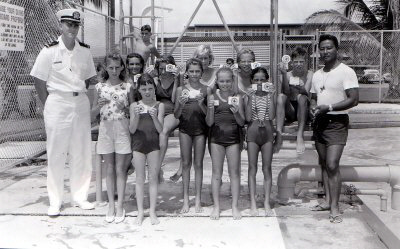
"That is a shot of the various levels of Red Cross Swimming Program. The great
looking dude (adult) swam in the Pan Am Games and was the swimming coach." Betsy
Hahn. Chris Hahn is next to the instructor. He says, "Also Boy Scouts had
awards/badges for various swimming accomplishments, like swimming and
lifesaving. I seem to remember a 50-mile swim patch you could get over a period
of time; I hope I'm not confusing it with something else though. There was
also a mile swim patch, you were not allowed to rest for that one. I was on the
swim team and it all involved a lot of laps every day. Anyone recognize anyone
else in the photos? (Photo sent by Chris Hahn)
My son, Chris Hahn, was a Cub
Scout and then a Boy Scout for a few years. While I was assigned to the National
Security Agency at Fort Meade, Maryland 1959-1962 Chris was a Cub Scout and I
was the Assistant Pack Chairman of his Pack in Silver Spring, Maryland, where we
lived. When I was assigned to USN-14 at the Naval Communication Station,
Wahiawa, Oahu, Hawaii. Chris was a Boy Scout in a Troop at Schofield Barracks,
just west of Wahiawa. I was on some committee there, but I can't remember what.
When we went to San Miguel, Chris belonged to the Boy Scout Troop there. Perhaps
he will share his memories of that some day in this web site. For some
reason--and I don't think it had to do with Chris being a scout--I was asked to
be the Assistant Commissioner of the Boy Scouts of America in the Philippines.
At one time I was on my way to a meeting of officials of the Far East area in
Tokyo, Japan. But I never made it? I went to Kadena--I think it was--Okinawa as
scheduled where the aircraft made a fueling stop. They announced when the
departure time was. I decided to take the base bus around the circuit of the
base to kill some time. When I returned to the flight line, the aircraft and my
suitcase were making their takeoff at the far end of the field! I didn't know
that they had a half-hour time in Okinawa. There I was with only short sleeve
khakis and not even a tooth brush. I made the best of it, spent the night, and
returned to the Philippines the next day. So, I still don't know what I missed
at the big conference, but I guess they didn't miss me. Captain Romanick didn't
care and just laughed at my blunder.
A I mentioned earlier, my principal a duty at San
Miguel other that running the Naval Security Group was as the liaison to the
Governor of Zambales. It may be that duty that led me more deeply into scouting.
I remember helping Governor Barretto with the Region 11, Boy Scouts of the
Philippines with the Regional Jamboree. I don't remember where it was held or
what the camp was named, perhaps Chris Hahn or Bob Lippert can help out there.
Like most scouting things I did with the Governor, we made an appearance, walked
around and met a few people, then went off to someone's house or someplace else.
I quickly learned in the Philippines--and in other countries--showed up, scouting
was sort of a political thing and scouts were looked upon as potential party
constituents. One scouting activity that I personally sponsored, probably
because I was asked to by the Governor, was Sea Scout Ship No. 1 Danacbunga
Botolan. My duties seemed primarily to show up on certain occasions and parades.
Understand, I enjoyed doing this and met a lot of wonderful people. I have never
met any other people in the world that I liked more than the Philippine people.
Perhaps the most memorable scouting experience that I
recall was the trip that Governor Barretto and I made to Cebu City, Cebu for the
Philippine National Jamboree. A small contingent of scouts from San Miguel went
ahead of us. I don't remember how they went or what their experience was.
Perhaps I can get my son, Chris, who was there, to give his account of the
adventure. I had all the proper scout uniforms with me as befitting an
"Assistant Commissioner." The Governor and I first went by Manila. I can't
remember whether we were driven or whether a small plane took us. When the
Governor went by plane, it landed and took off right on the road leading to the
base. The President of the Philippine Airlines )(PAL) was a friend of his, so
that may be where he got his air transportation. By the way, my family and I
went to an island owned by the President PAL and that was a nice experience.
When we arrived at the Manila airport we discovered that something had gone awry
with our airline connection to Cebu, so, we tried to find an alternative way to
go. At some point we noticed a man write a flight to Cebu on a blackboard
outside the little terminal on the wall. The sidewalk was covered by some sort
of canopy. A little later the same man set up a card table that said Southern
Airline or Southern Air Transport, or something like that. He took our
money and said that the plane would leave when there were enough passengers.
Finally he folded up the card table and chair and led a few people to a C-47
that was outfitted with picture windows rather than the normal port holes or
small windows of the day. The aircraft was fine, but to our surprise the pilot
was the same man who had written on the blackboard and who had taken our money.
At Cebu we landed on a primitive pasture-like airfield and went to our hotel.
Later on, around supper time, we went to the jamboree encampment and met with
the American scouts from San Miguel and the Philippine scouts from Zambales
Province. I needn't have bothered with any other uniforms, as that is the only
time we went there except perhaps to bid they farewell at the end. The rest of
the time we spent at parties and casinos and taking in the world championship
flyweight-class boxing bout. The Filipino won, but I don't remember his name. It
was a big deal in the RP at the time. So, that's all I have to say about that.
(Forest Gump)
I don't know whose idea it was to build a Boy Scout
Camp at San Miguel, but it was probably a part of the People-to-People Program.
It was intended from the beginning to be a joint American-Pilipino venture. Some
time at the beginning of the camp I think it was, with the cooperation of
Captain Romanick and my wife, I was "captured" as I left the Naval
Security Group building and
taken to the camp on a vigil. At the time we were in the middle of some
operational crisis and the idea didn't appeal to me at all. So, most of the
ensuing 24-hour period was spent hewing palm tree logs and such and doing drudgey
construction work. I think there were a couple of others involved as well. The
culmination was a ceremony where we were inducted as Members of the Order-of-the
Arrow. And, I think that was about the end of my involvement in the Boy Scout
Movement.
Scouting experience of others:
Bob Lippert, email for the summer of 2006 is
rlip37@aol.com and later
blippert@halldale.org ,
son of Chief Bob and Alice Lippert, Says: I
look forward to your Boy Scout update. I was a Boy Scout while I was there too.
I went on the Bataan Death March too. I think that it was in December of 1964. I
remember that there were water trucks from Clark Air Base that traveled with the
scouts. I think that it was a three or four day hike. We had a small ceremony in
every little town that we went through. I went to a Boy Scout Jamboree on Clark
Air Base. That may have been in he summer of 1964. I remember that you could
trade anything that said made in USA there. A canteen, pocket knife, utensils.
If it said made in USA you could get a lot in trade. If it said BSA made in USA
you had a treasure. How times have changed." Perhaps we can get Bob to tell some
more his scouting experiences in the Philippines.
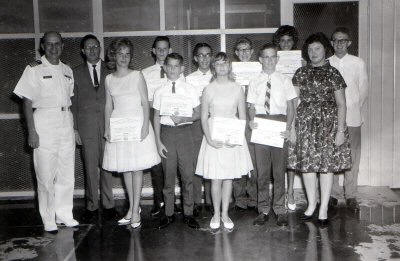
This appears to be the Graduating 1965 Class of the Oliver Hazard Perry
Elementary School. Captain Frank Romanick on the left; to his right is probably
the Principal, Mr. Hardy B. Ross. The man in back on the right end is probably a
teacher, Mr. Myron E. Ranny. On the right, front, is
Mrs. Janice M. Kendra, their teacher. To her right is Chris Hahn,
then Elizabeth Ann Hall, then Faith Lippert is the first girl on the
left.
Rick Kneal is just behind Chris. Claudette Ann "Cookie" Crozat is
to Neal's left. Can anyone identify the others in the photo? (Sent by Chris Hahn "I
remember attending 7th grade and 8th grade, there. Interesting, since the
classes were so small, both years were spent in the same classroom. We simply
traded sides of the room from 7th to 8th grade. Just happened to have the
program from that graduating class)
From The Graduating Program:
Graduation Ceremony of the Eight Grade Class Oliver Hazard Perry School, U.S. Naval Communication Station, San Miguel, Zambales, Republic of the Philippines 27 May 1965 1930 hours
Program: Invocation Chaplain H. B. Waters
Song "Battle Hymn of the Republic" Graduates
Guest Speaker Captain F. M. Romanick Commanding Officer
Presentation of Graduates Mrs. Janice M. Kendra Teacher
Presentation of Diplomas Mr. Hardy B. Ross Principal
Graduation Song Graduating Class
Accompanist Mrs. Howard Waters
Teachers: Mrs. Janice M. Kendra, Mr. Myron E. Ranny
List of Graduates:
Claudette Ann Crozat, Christopher Frederick Hahn [the son of Tom and Beth Hahn],
Elizabeth Ann Hall, Walter Clark Harrison, Jr., Charles Richard Kneal [the son
of Maj. and Mrs. Charles [Chuck] Neal], Faith Henni Lippert [the daughter of Chief
Petty Officer
Robert "Bob" and Mrs. Lippert. They later were stationed at the Naval Security
Group Activity, Winter Harbor, Maine. Chief Lippert died in September 1982.
Mrs. Lippert lives in Ellsworth, Maine. Their son, Bob, contributes to this
site.], Ronnie Roberts, Robert Alan Simpson
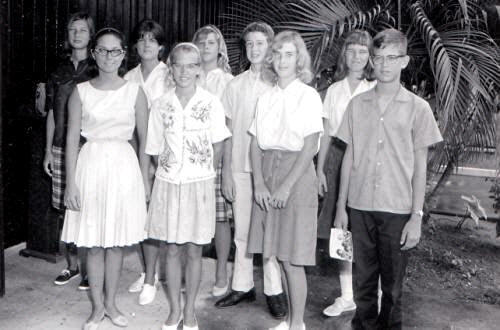
What is the occasion of this photograph? Bob Lippert says, "Could the photo have
been taken in front of the base chapel? I don't think it is a field trip."
Genie Waterssays that she thinks that it was taken in front of the
chapel at a church function. The ages of the subjects vary from a
seventh grader in the Oliver Hazard Perry Elementary School to a junior in the
George Dewey High School (GDHS). The photo was taken sometime
before July 1965. Front row, right-to-left: Chris Hahn (GDHS 1969)
(e-mail
cfhahn@hotmail.com) left, is holding a program or a brochure of
some sort, perhaps a religious tract?; Faith Lippert (GDHS 1969)
(e-mail
lppfai@aol.com); Marion Cooper (GDHS 1964) (the sister of Carol Cooper GDHS 1966 and Bill
Cooper (GDHS 1968); and, unknown girl. Back row, left-to-right: Susanne "Sam" Romanick)
(GDHS 1966), Genie Waters (GDHS 1965) ;
Dixie Waters (GDHS 1970). who died in 1998), and according to Chris
Hahn, probably Rick Kneal, whose father, Major Chuck Kneal, was
the head of the Marine Detachment; and Rebecca "Becky" Douglas (GDHS 1970) (email rsr52@comcast.com)So, now we need someone to identify the girl second from the left in the front
row. Good detective work in getting this far everyone.
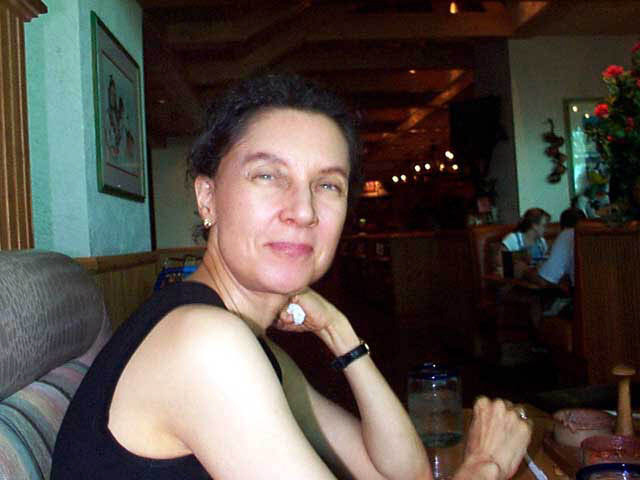
Suzanne "Sam" Romanick in 2000. (Sent by Bob Lippert
blippert@halldale.org )
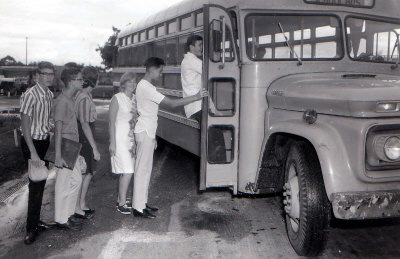
Base High School Bus to and from San Miguel to and from Subic Bay where the
George Dewey High School was located. (Provided by Chris Hahn)
Ok, above is of from my Freshman year at Dewey High School, getting on the school bus at San Miguel to go to Subic Bay for school. Rick Kneal is wearing the striped shirt, I'm to his right. Pulling himself on the school bus is Gary Hutchcroft. A morning ritual on the bus ride, was for Gary to tease Suzanne (Sam) Romanick about whatever he thought might get a rise from her. Gary and Rick and I were also in a rock band (I have a picture of that band somewhere), along with a guy named Perry, on the drums, who was pretty good. Rick and I played electric guitars, there was someone else who played bass but I don't remember who.
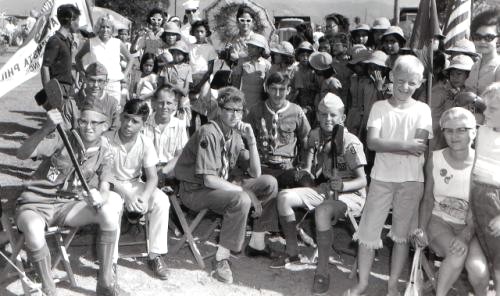
A Contingent of Boy Scouts from the San Miguel Station. Chris Hahn
with the axe, fourth scout in uniform
Gary Hutchcroft. This may have been the group preparing to depart for
the Philippine Jamboree at Cebu, or in conjunction with the Philippine Camp
Barretto, or the Re-Enactment of the Bataan Death March. Need some help
here. (Sent by Chris Hahn)
OTHER MEMORIES:
Allan Eaton AEatonii@aol.com amplifies one of the dangers of living in the Philippines.
My mother told me the story about being in car with the Governor Barretto, coming back to San Miguel from some function. She said there was a gun between the front seats- this made her a bit uneasy- until a shot rang out and flew in the front window, then ricocheted into the back seat and hit my mother in the neck. Luckily it was a glancing blow and she wasn't seriously hurt, but about then she wasn't quite as upset about the machine gun between the seats as she was earlier in the ride.
Life at San Miguel: From Betsy Hahn bhahn@earthlink.net
One regret about living there is that I did not start a bug collection. I got locked out of the house one morning before dawn and went down to the maidís room to let me in. I was absolutely fascinated by the amount and type of bugs on her screen door at that hour of the morning. I did not wake her but admired the bugs. Guess I hung out in my nipa hut until everyone woke up. I did find that picture and will scan it for a later rendezvous.
A RMC (retired) Nancy Bryim naobryim@hotmail.com summarizes the Philippine experience nicely in a San Miguel Bulletin Board by saying:
The Filipino people are so kind and generous. They would take us in like family even though they were so poor, and I do know of some nights girlfriends getting me off the streets to their homes before curfew if I was too far from home. The country was so beautiful, the beaches and the forests. And we got to experience things that most ppl will never get to do. Like ride a Victory Liner (bus) or a jeepney [jitney] full of people with chickens or whatever kind of animal ppl could carry with them with the bus going as fast as it can down winding roads scaring you sh*tless. Foods that were so delicious. I am glad that I did learn how to cook lumpia, panict, adobo and pan-de-sal and a few other dishes, my kids love them. I guess I am like the rest of my shipmates, when I want a lift or a grin all I need to do is think back and reminisce to those days long ago.
(John Glasgow) I have the picture from the 4th of July parade, with me and others carrying telephones. NavCommStaPhil was known as "Home of Instant Communications" and I think there was a sign that said that, and one of us was carrying the phone with a sign "Officer's Wives Club" and the other was carrying one that said "CPO Wives Club" - of course they both meant "instant communications etc". Don't think some of the Wives' appreciated it. I also have a picture of Capt Romanick presenting me with what I think was the first place prize from the parade. Also have a Navy Photo of me painting a school in San Antonio for "Operation School House". Anyway, the following is something that happened while I was in charge of the Entertainment Committee for the CPO Club. Now, you must remember that I was 34 when I got to San Miguel. My Wife Mabel and I and another couple went to Olongapo and met with an agent to try and sign some entertainment to come up to the Chief's Club. Mabel was not happy, but the agent took us to 3 or 4 bars where he had entertainment. It was all pretty raunchy. Before we left, we told the agent which group we would like and made arrangements for them to come up the following Saturday to the CPO Club. Well, during the next week, some of us got to thinking and decided that if the word got around that we were having that kind of entertainment, we might get into a little trouble, so decided not to have them. I called and left word for the agent not to come. Well - like most Saturdays, we all went to the Club just to hang out. I had not been there very long when I got a call from the main gate guard, saying I had some visitors. I went up to the gate and there was the agent and about 4 or 5 of him female entertainers. After they had traveled that far, I thought the least we could do is feed them. I took them all to the club, and by the time they got done eating, most of the CPO's had drank just enough that we decided we would let them put on a show in the "stag bar" area - which was not open to the ladies. And we did, and they were good - and Mabel still is mad about that whole thing. But you have to remember we were probably about 10 years younger than you that went to school at San Miguel at the time.
(Allan Eaton April 2006) - I remember the greased pole contest well. Another pole story was Father Pete giving me a quarter to climb a pole in the O Club. This pole climbing evidently was an embarrassment to my mother and every time she turned around there I was on the pole again, another quarter richer. Great memories of the bike parades, colored streamers and playing cards clothes pinned so they would make noise in the spokes. I also remember Halloween and using paper bags to make chaps for my cowboy costume. How about "surfing" on plywood boards during the rainy season in the field ponds. There was also some type of a huge flying bug that I remember tying a string to its legs and "flying" it in circles. Snakes: The adults all told us not to take short cuts through the drainage areas around the housing circles. Did we listen? No. We would all line up, count to three, and make a mad dash for the far side. Doesn't sound like such a brilliant plan in retrospect. I also remember the field hands chasing snakes with machetes while mowing the fields and also seeing the many dead cobras that didn't get out of the mowers way.
1966-1968 Commanding Officer, Naval Security Group Activity, Winter Harbor, Maine (also United States National Park Ranger, Constable Winter Harbor, and Deputy Sheriff Hancock County). President Winter Harbor Chamber of Commerce.
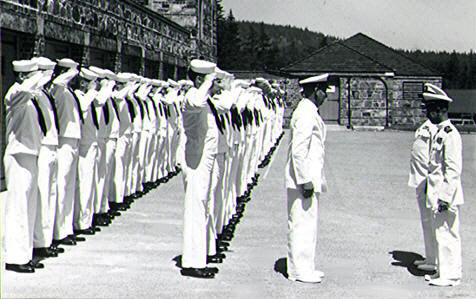
Change of Command from Commander Stu Faulkner to Commander Tom Hahn, August
1966.
(US Navy Photo)

9 June 1967 -- Completed United States. Navy Space and Astronautics Orientation Course at the United States Naval Missile Center, Point Magu, California.
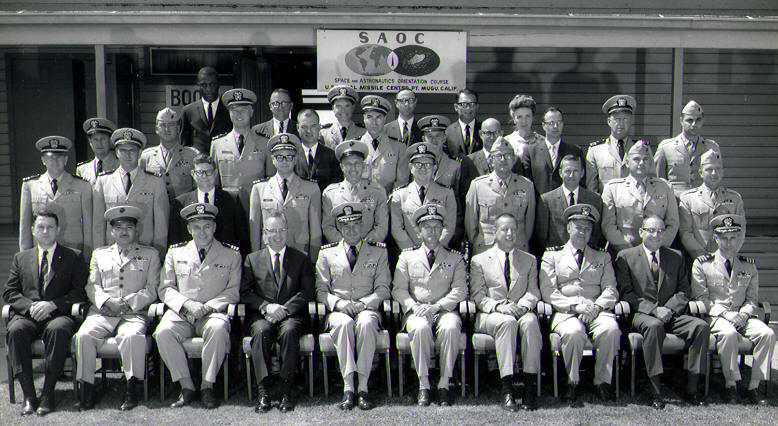
Space & Astronautics Course Class Graduation at Point Mogu, California
(Hahn Collection)
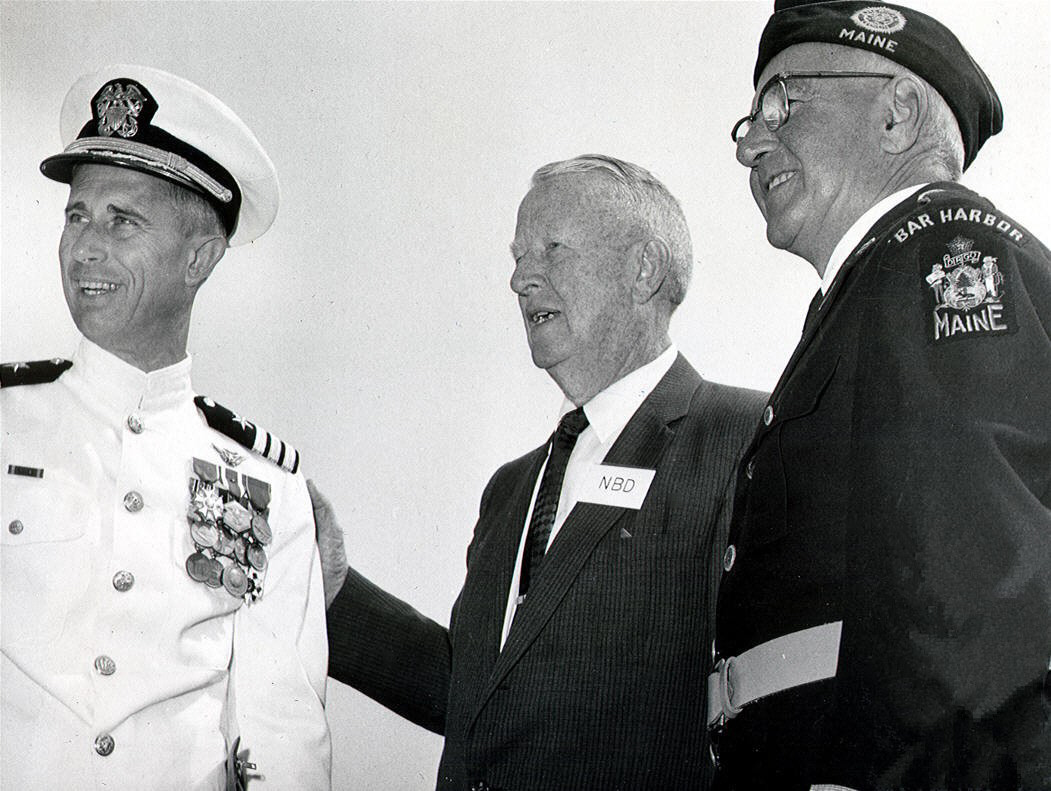
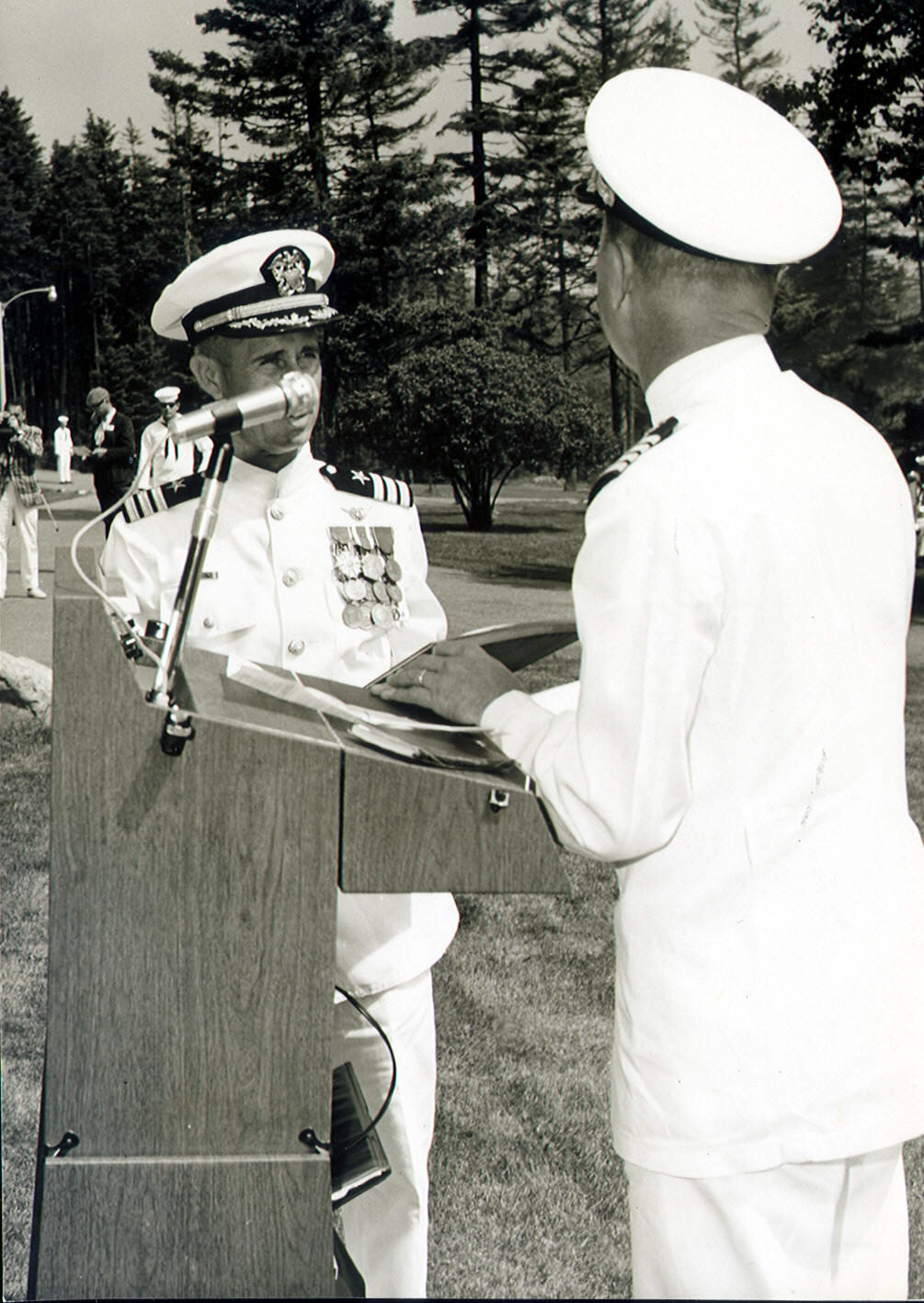
50 Anniversary of Naval Communications in Maine.
CDR Tom Hahn, Commanding Officer, Captain Romanick, Commanding Officer USS WRIGHT
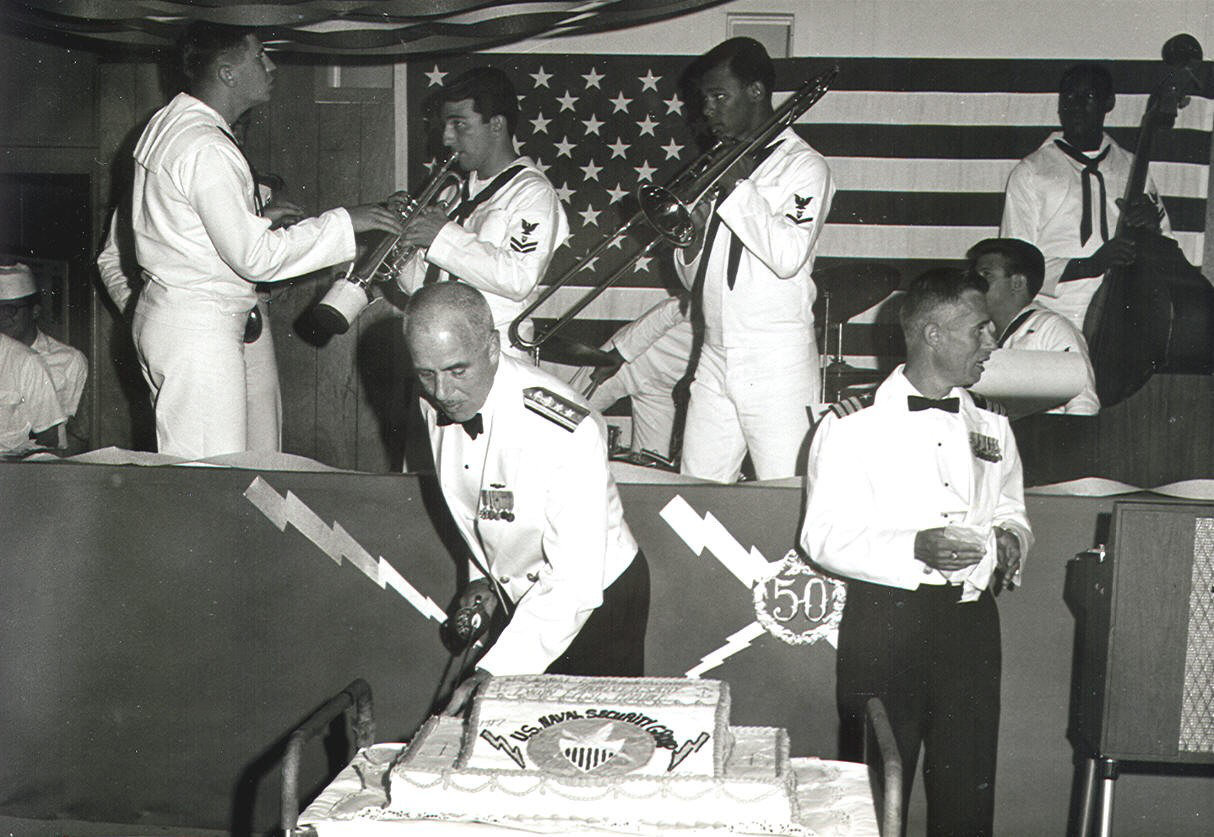
50th Anniversary of Naval Communications Dance
and Dinner. RADM Weeks, Director of Naval Communications (left) CDR Tom Hahn,
Commanding Officer, Naval Security Group Activity, Winter Harbor, Maine (right)
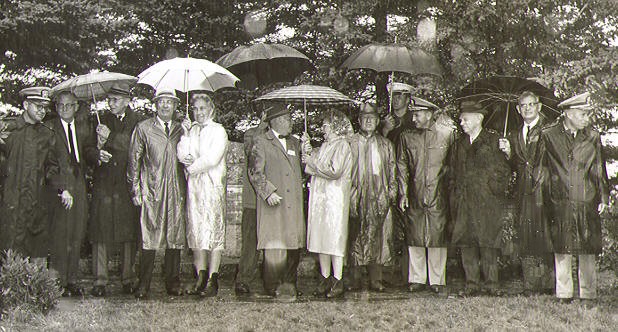
Veterans of the original radio station at Otter
Cliffs, (Bar Harbor) Mount Desert Island and others as a part of the 50th
Anniversary of Naval Communications in Maine, August 1967. (US Navy Photo)

Dignitaries and Guests at the 50th Anniversary
of Naval Communications in Maine Dance at Winter Harbor NSGA, August 1967.
(Official US Navy Photo)
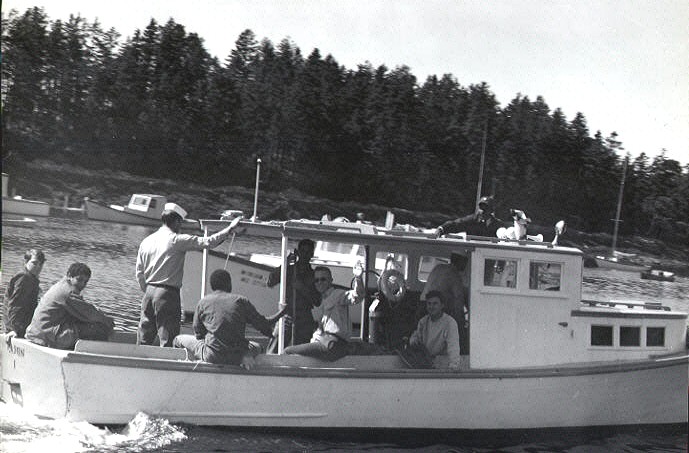
Station fishing boat, The Cajun, with Tom Hahn and
guests from the Job Corps Center at Bar Harbor, 1967 (Hahn Collection)
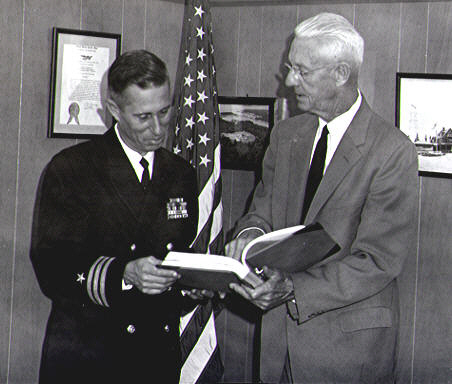
Harold Castner, Station Historian and veteran of
Otter Cliffs and CO Tom Hahn in Tom's office, 1968 (US Navy Photograph)
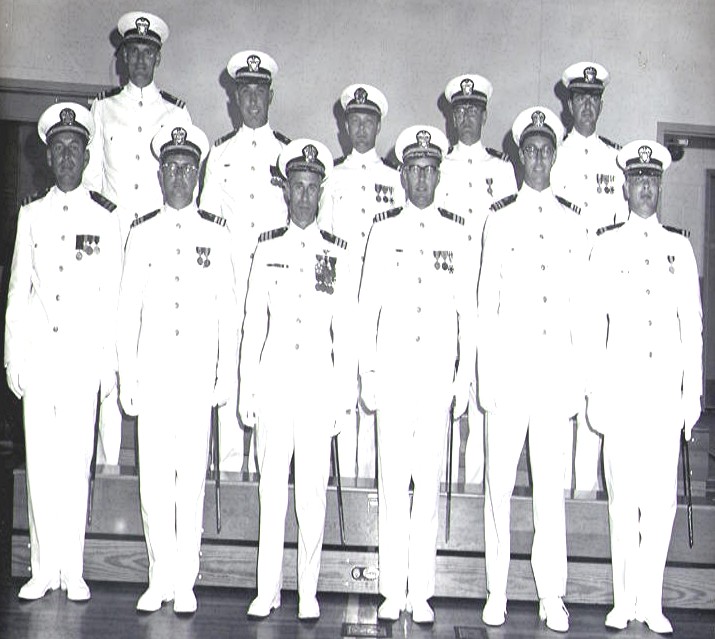
The officers of the Naval Security Group
Activity at the Change of Command in August 1968. Outgoing Commanding Officer.
Tom Hahn, third from left front row, and Jeff Davis, new Commanding Officer.
Jeff later became a Rear Admiral and the Director of the Naval Security Group
Command. (Official U.S. Navy Photo)
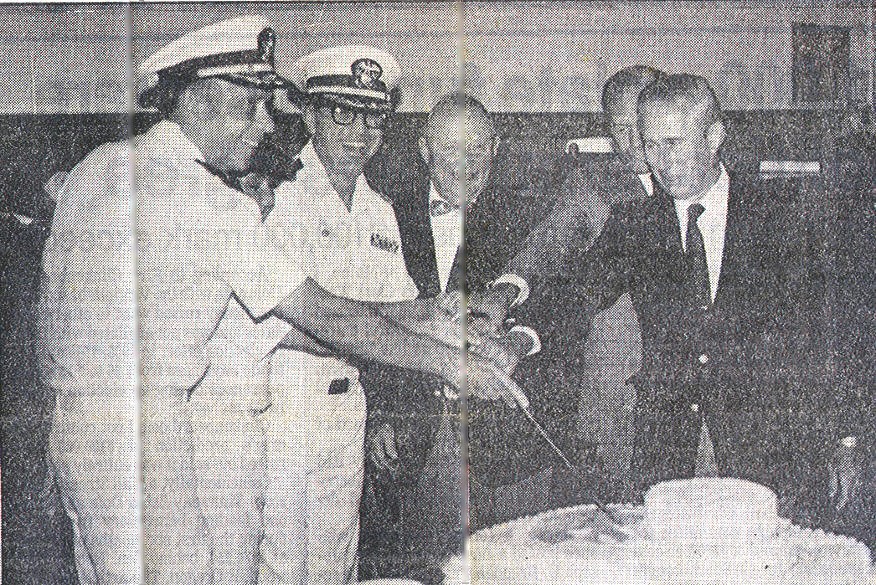
Commanding Officer (present and past) at the
Fiftieth Anniversary of the Navy Base at Winter Harbor, Maine. August 1985 .
Left-to-right: Rear Admiral Donald H. McDowell, then current CO Commander Edward
Dittmer, Captain Jackson Koon, Captain Roger Lunde, Captain Tomas F. Hahn
(Bangor Daily News)
WINTER HARBOR MEMORIES
(From Chris Hahn May 2006) You forgot to mention that grocery shopping involved a hundred plus miles trip while we lived there. I remember some long drives to Hays Air Force Base in Bangor (I think that was the name) [Dow Air Force Base] where the commissary was in those days. Now of course the old Base is Bangor International. A lot of things required a lot of traveling in that area, I know that following the coastline was several hundred miles because of the irregularities of the coastline. And hitchhiking. There were a few times I hitched with a friend, or maybe even by myself at least once, to go visit Bar Harbor since I didn't have a driver's license, probably 75 miles or so, another time to Bangor for an afternoon rock concert (Mitch Ryder and the Detroit Wheels), and a few times from Sumner High School in Ellsworth to home not sure how many miles that was. Probably the hardest part of hitching was the road from Winter Harbor to Rt 1, several miles; there were more cars with friendly drivers along there it seemed. Most often though, there was that bicycle ride from Base to Winter Harbor, and then back, to visit my friends at off-base housing. Winter Harbor was where the occasional Saturday night dance was held on Town property [Hamilton Hall], and my high school buddies (and kind parents) would let me stay the night in town there.
What was nice about the [living on the] Point (the Base), for me, was walking across the street to the grassy area to the side of the gatehouse and picking fresh cranberries, not to mention the blackberries and raspberries, in season all along the side of the scenic approach road. And the wildlife, raccoons (in the trash bins at night), deer on the lawn by the flagpole in front of our quarters in that picture, and the more teenage thrills of renting a snowmobile for a dollar or so and riding it at night on the trails, movies, and attempting to find an FM music station on the radio that I liked that was in Boston.
(From Tom Hahn May 2006) You are right about the grocery shopping, although we did some of it at the Cutler Navy Communication Station. It sure was nice for everyone when the commissary opened on the base later. It was hard to get around. I think Bar Harbor was about 45 miles. There were extra trips to go back and forth to Sumner High School as well. I remember Jimmy Cavelle taking you to Sumner a few times to basketball games, perhaps? You did have some good friends in town, but it made it hard for you and Betsy as two of the only three kids living there at that time and no neighbor's kids to do things with. That little patch of cranberries across for the guard shack were bog berries and not too many of men but fun. Also the blueberries, both high bush and low bush. One of the things you did not like doing was taking the trash down to the trash house at the end of the building was because of the raccoons that were kind of spooky at night. Maybe these messages will start a string of the things that we did. We certainly made the most of being a rather remote navy station. I can think of lots of things will will bring them up a couple at a time.
(From Betsy Hahn) I had all of my buddies in that housing area [in Winter Harbor]. The side closest to the homestead (east) there was a sledding hill Ė when it was iced down it was slick and fast. I creamed myself on someoneís clothesline on a saucer. Winging down the hill with two people holding on and turn around for a glorious face plant. Damn that hurt. My best friend in WH was Margaret Faulkingham whose family lived across from K-Park. Thatís how it sounded phonically back then. Housing details are not important to a second grader. I canít remember what year but it was the best Halloween spooky time ever. I had to cross that property coming from Sergeant St. to get back to K-Park. There were a couple of testy goats that lived there too. I actually crossed the field with my brother Duane [Torrey] and I really think that was the first time I met him. By the way the goats coming across the field in the dark sounded like the demons from HELL.
(From Betsy Hahn) The guards at the gate as I remember always had apples for the deer. The deer were always around that flagpole. Used to wake myself up so I could see them in the moon light. I used to roam that whole property as a kid. Great place to be a kid. It was lonely but I turned the place into a space that was my own. On the south side there was a shack for washed up lobster traps. I liked sitting on the rocks and smell the dried seaweed went back years later to find it but everything was gone. Even then it seemed magical. You know Chris was trying to do that teen age thing as illustrated below but he forgot to tell you that he never forgot his little sister. Chris and I built a raft that we could use when the tide was low to go over to the island. We got caught one time because we were exploring, watching clouds, etc and the tide changed. I will never forget the panic look on Chrisís face. Chris never said that we were screwed. We were trapped with the strong tide coming in. Did I mention cold water. Well we talked about it and we determined that going in the water was better than facing the parents if we were not back on time. Damn good thing we were both good swimmers. Thank you the swim team in the Philippines. Did I mention that it was COLD.
(From Tom Hahn) Chris, you are right in a way about the CO Quarters at the base in Winter Harbor, but I guess the CO could have chosen to live wherever he wanted to. Maybe some housing thing that it was set up that way. In general, you just fell into whatever the pattern or custom was/had been. It never occurred to me to wonder whether or not I could have lived in Capehart Housing in town. That large, corner four-bedroom (? ) apartment had always been the CO's Quarters and I just took it for granted. The XO was in Capehart, so maybe someone along the line intentionally did it that way. Our quarters were great except for being isolated. We had the whole section of the National Park to ourselves. Each bedroom had a wash basin which was handy. It also made a nice place for entertaining various official visitors to the base. A considerable amount of time was spent doing that, but we enjoyed it.
The base was a great place to try out new ideas. My Security Group boss was in Washington and our nominal administrative boss was ComOne/Commander Naval Base, Boston, so usually I just went ahead and did things and if in doubt sent a UNODIR message or letter, that is Unless otherwise directed I intend to do ____ by ____. I used that often in the fast-war war in Vietnam while in Southeast Asia. Down in the woods on one side I had Public Works improve a trail for an Adirondack Shelter and on another side a place where there could be viewing of the sunset, but I suspect that very few people took advantage of or had in interest in some of the things I did like that. One of the reasons I made friends with the Superintendent and folks at the Acadia National Park Headquarters was to take advantage of the things that they could do for us or that we could do for them in return. The picnic area, for example was done by a Reserve Construction Battalion. The Park Service at Bar Harbor needed a project for the Job Corps, so the Family Campground are seemed fitting for them and we ended up with a nice area that is still there. That also took care of having to cut down some trees that could have been a problem otherwise. Some folks thought that idea foolish and for a while there was a sign up there that named it "SKIPPER'S FOLLY." It was to my knowledge the first Navy Family Campground. The last time I went by there, it was full of people having fun from all over the United States. We needed a pier to use for the 50th Anniversary when my friend and old CO, Captain Romanick brought in the aircraft carrier USS WRIGHT (CC1?) at my request, I got are reserve group of Seabees to build that pier which is still there and still usable to my knowledge. I went around the state visiting groups like that to make friends and because they were all interesting folks. We needed a new Chief's Club, so I went to the Recreation and Welfare Conference (Special Services) Conference with "Suds" Sunderland at Dallas, Texas. I was the only CO there so I spent considerable time at the bar with the guy in charge in Washington and the result was a new club, which became an all services club later.
(Tom Hahn) Does anyone remember CPO Wayne Smeal? He was a T-brancher at San Miguel then was at Winter Harbor. Wayne was one of a group that I went hunting with. A couple of times I stopped by their house and had a cup of coffee and doughnuts before we set out. Wayne died after they retired there. Maybe someone cam tell me the name of Wayne's wife. I stopped by their later a few times when she was a widow. I think they lived in Steuben.
(John Glasgow) Mike was about 4 years old but he remembers me taking him out to the base and then we walked way down past the ball diamond to cut a Christmas tree and he wandered off while I was cutting the tree. Took an hour or so to find him. Another thing they talk about is the time a friend of mine and I went duck hunting. I had my own gun, but he had to check one out from Special Services. Anyway we launched our boat and pretty soon a couple ducks flew over us. Am not sure which one of us stood up, but anyway, the boat tipped over. I held on to the boat and kept my gun out of the water, but my friend dropped his gun into the water. He looked at me and said - my gun is at the bottom of the lake - and he could not swim - SO, I had dive into the very cold water and get his gun. When I got home, the first thing I did was get the wet clothes off. When my Wife and Son's heard my story, they made me put all the wet clothes on so they could take my picture!!
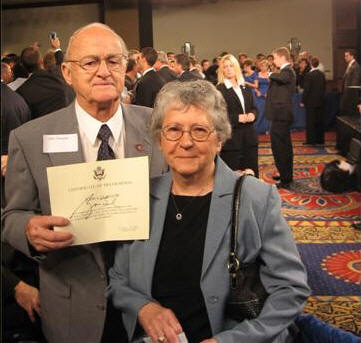
This is
one of the pictures that we had taken. President Bush had just signed
my Certificate of Recognition recognizing my service during the Cold
War (any service between 2 September 1945 and 26 December 1991).
Anyone tho served anytime during that period is eligible to get this
certificate. It was already signed by the Secretary of Defense, but I
thought it would be nice if I could get President Bush to sign it and
he did. That is the President with grey hair standing between the 2
guys near the center. (Provided by John Glasgow)
(Tom Hahn to John Glasgow re above items) The only thing I remember about duck hunting in Maine was what a heck of a job it was to clean the ducks and pick out the bird shot. I can't remember where we went. I did quite a bit of deer hunting and more about that later. I guess a lot of us sneaked a Christmas tree out of the woods even though it was a National Park. The only time I really got mad about anyone doing anything in the park was when a couple of guys I hunted with, maybe [name omitted] and [name omitted]--maybe one of the others--shot a deer with a bow and arrow up at the area where we had the flag. I thought that was tacky and particularly so because we enjoyed the deer so much. As Betsy said in her message she got up to watch the deer in the moonlight. I am trying to think of the names of the other hunters I went with. One was Doug ____ a Chief Petty Officer and Security Group O-brancher, at San Miguel too, I think. Another was Wayne Smeal, also at San Miguel. A Security Group T-brancher. Ring any bells? I didn't hear about my "friends" jacking the deer, but I guess I felt badly that they had taken advantage of our friendship. Luckily at that point I didn't have to do anything about it as a National Park Ranger.
The
Superintendent of the Acadia National Park at Bar Harbor, Bob
Binnewiess, and I became good friends. Bob became a big gun in the
Department of the Interior and at one time was hired by David
Rockefeller as the Director of the the Maine Coast Heritage Trust.
When I was working for the National Park Service in Washington
about 1974 Bob asked me to be assistant at Bar Harbor and then to
take over his job as director. We had just bought our house at
Shepherdstown, West Virginia, and decided that we didn't want to
pull up stakes and move back to Maine. Because they only had a
seasonal (summer) park ranger, Bob appointed me as a National Park
Ranger and Law Enforcement Officer, so I had to take care of some
things beyond what was navy in our part of the Schoodic Annex.
(From
Tom Hahn) By the time we got to Winter
Harbor after the hectic, enervating tour at San Miguel and
Southeast Asia, having lost my father in 1966, trying to help
my mother--who had broken a hip in 1965 in the midst of my
father's illness with cancer and who was at the Veteran's
Hospital at Topeka, Kansas, and trying to take care of some of
their affairs in transit to Winter Harbor, getting myself and my
family from the Philippines to Maine, and coping with some
personal difficulties, I was dead beat by the time that the new
tour began in August 1966. This was the first time that I
was a commanding officer. I was looking forward to running the
station to try to change some of the things things that had
irritated me by various people and by commands all along the
way. One of the first things I had to do was to get some
much-needed dental work done that had been neglected for a
couple of years. Luckily, being a remote command in Downeast
Maine, we had a good doctor and dentist and good dental and
medical and dental staffs. For major work we went to the
hospital at Ellsworth, or to Boston and to Washington for really
major or specialized medical stuff. Lt Ron Hatch was our dentist
and his dental technician was Hospitalman First Class Piscitelli,
I believe. They were in the middle of doing a big filling when a
drill broke off in the tooth and they had a heck of a time
getting it out. The next time I went, they were a bit
apprehensive, so began their when once again. In the middle of
the procedure I passed out. I think it was just general fatigue.
In any case, when I woke up, Dr. LCDR Hamilton was standing
there and I heard Ron ask the doctor, "What do we do if the old
man is dead? "(Old Man referring to the co, sort of regardless
of age). The third time I went in, everything went well, to
everyone's relief, except that when Piscitelli handed me the
cone-shape cup of water, he pressed too hard in his relief and
the water shot up in my face. That was good for a laugh, later.
Piscitelli was a good man with an interest in Downeast Maine. We
were both looking for a cabin, and it turned out that we were
both trying to acquire the same cabin. I backed out of my offer
so as not to create a problem for either one of us. He later
went to Vietnam and I see him years later at the base when the
Recreation Building was dedicated after I had retired and was
living at our camp at Lower Lead Mountain Pond in the
summertime.
1968 -- Promoted to Captain (O-6).
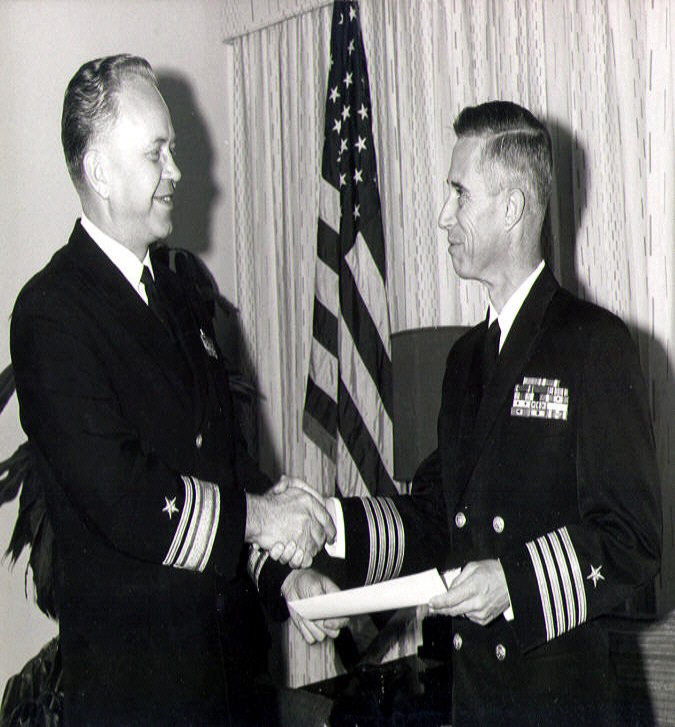
Tom Hahn Receiving Commission as a Navy Captain by Read Admiral Ralph Cook,
Director, Naval Security Group Command ( Hahn Collection)
1968-1970 - Assistant Director, United Stated Navy Security Group Command
for Mobilization and Naval Reserve (100 reserve divisions), Washington,
District of Columbia.
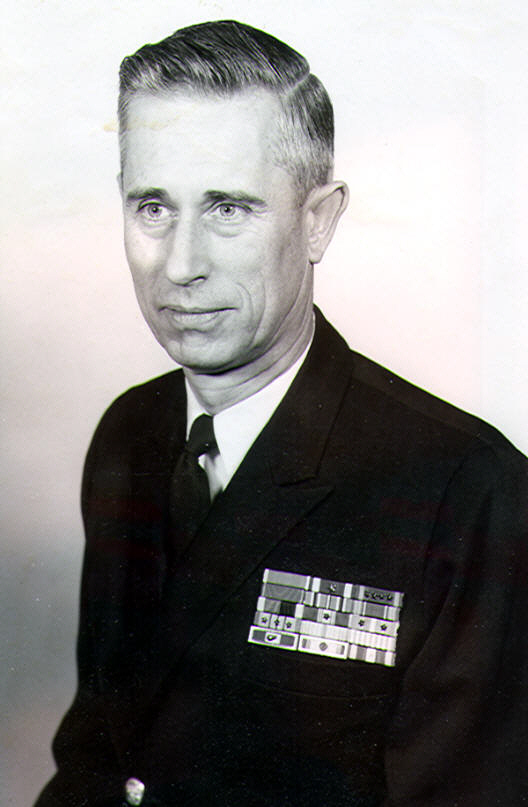
Tom Hahn, Navy Captain (Hahn Collection)
1970-1972 -- Chief of Office, Far East Area, Production Group, National Security Agency,
Fort Meade, Maryland.
1972--June Retired from active duty.
Medals and Decorations:
1. Legion of Merit Medal for the Gulf of Tonkin Incident
(1964-1965) (First Row in Ribbon Display Below)
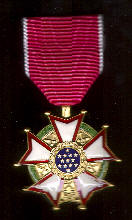
2. Air Medal for Reconnaissance Missions as Aerial Observer, Communications
Liaison Officer against North Vietnam and China
(1965-1966) (Second Row Left in Ribbon Display Below)
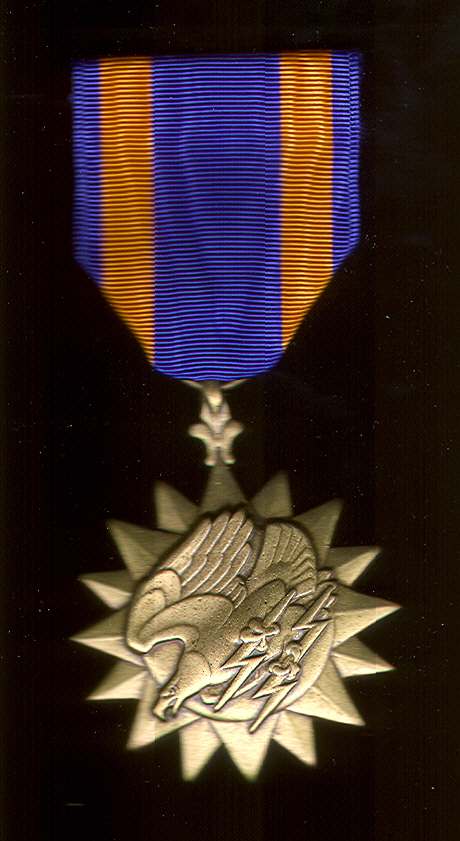
3. Secretary of the Navy Commendation Medal . First medal responsibility for
Overhead Reconnaissance and Special Projects in the Far East at the National
Security Agency (1961-1963). Second medal with combat V as Project Officer and as a
Technical Observer
for BIG LOOK
, an
aerial reconnaissance program in Southeast Asia, during the Vietnam War
1965-1966) (Second Row Center in Ribbon Display Below)
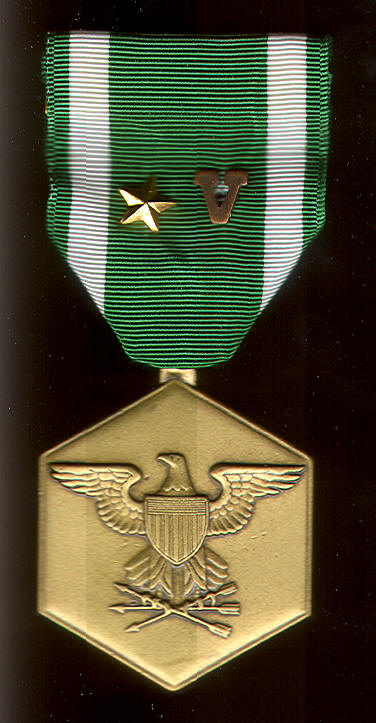
4. Combat Action Ribbon (Amphibious landing in Korea during Operation Trojan
Horse) (1953) (Third Row Right in
Ribbon Display Below)

5. Secretary of the Navy Unit Commendation (five awards):
1.

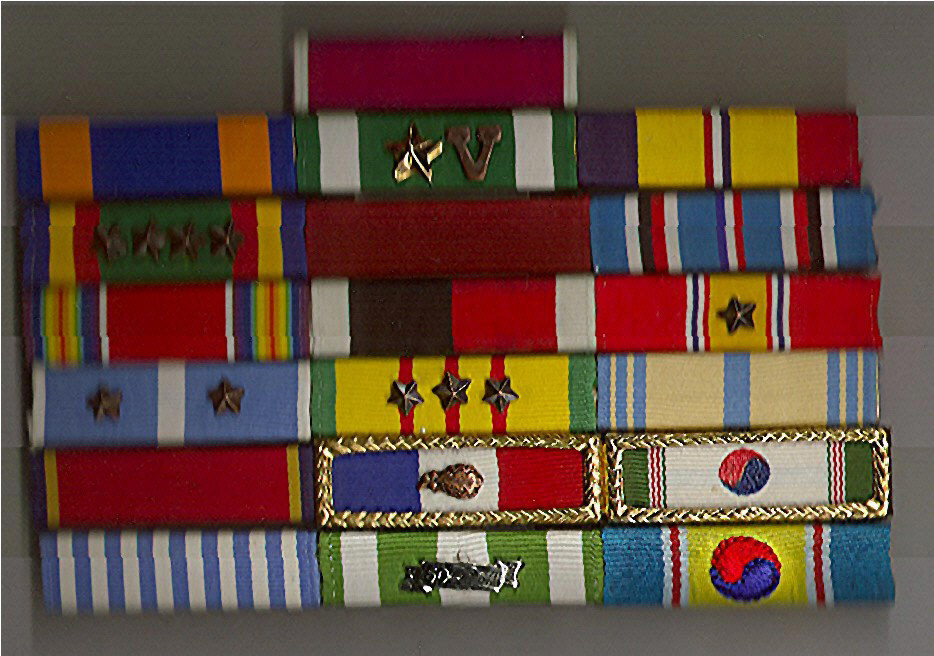
6. Navy Good Conduct Medal (Third Row Center)
7. American Campaign Medal
(Third Row Right)
8. World War II Victory Medal
(Fourth Row Left)
9. Navy Occupation Service Medal (for service in Europe and North Africa)
(Fourth Row Center)
10. National Defense Medal with bronze star
(1950-1954 and 1961-1974) (Fourth Row Right)
11. Korean Service Medal (two campaigns) K-8
8/29/52 - 11/30/52 K-9 12/152-12/19/52 1/30/653-2/2/53(Fifth
Row Left)
12.Vietnam Service Medal with Device (1960 - ) (three campaigns)
(Fifth Row Center)
13. Armed Forces Reserve Medal (Fifth Row Right)
14. Naval Reserve Medal
(Sixth Row Left)
15. Philippine Republic Presidential Unit Citation Ribbon with Oak Leaf
Cluster (Sixth Row Center)

16. Korean Presidential Unit Citation (Sixth Row Right)
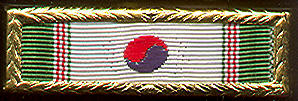
17. United Nations Service Medal (Seventh Row Left)
18. Republic of Vietnam Campaign Medal
(Seventh Row Center)
19. Republic
of Korea Medal (Seventh Row Right)
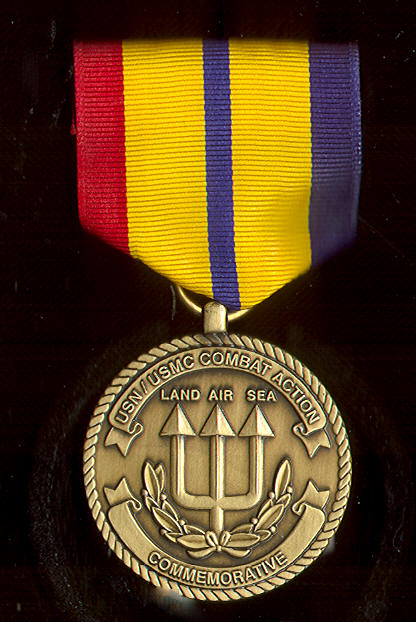
Combat Action Commemorative Medal (Korea) 1952-1953
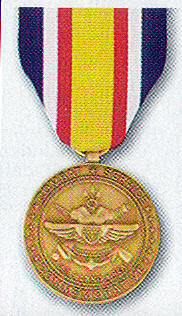
Combat Service Commemorative Medal (Vietnam) (1964-1966)
Times New Roman. 12 point. Copy 30 October 2004. Photo check A. TH